Introduction
In this article I will highlight my MLB Top 50 Pitching Prospects, including a handful of honourable mentions. Each pitcher will have a graphic associated with them that includes information such as biographical data, MiLB statistics, and, most importantly, my scouting grades. These grades are on the traditional 20-80 Grade Scouting Scale and were determined through both statistical and video analysis.
As I learned through this process, the task of writing and compiling a Top Prospects list is not easy. The plethora of research required is time-consuming, and that does not consider the complexity of scouting. I have consumed countless amounts of baseball content in my life, and I would like to thank everyone that inspired and provided me the knowledge to undertake this project.
A special thanks goes out to the following:
MLB for their library of videos in the MLB Film Room. The Film Room provided easy access to videos on each prospect covered in the article.
MLB Pipeline for their prospect coverage.
Tess Taruskin (Fangraphs) for their incredible work on “A Visual Scouting Primer: Pitching” on Fangraphs. All 3 parts of the primer helped me immensely while I was reviewing footage of each pitcher. I also learned a ton from their Prospect Coverage on Fangraphs.
Eric Longenhagen (Fangraphs) for their Prospect Coverage and many articles on Fangraphs.
Aram Leighton (Just Baseball) for their Prospect Coverage on Just Baseball. Aram is a top-notch evaluator, and his work at Just Baseball was a large inspiration for me.
Lance Brozdowski for their indispensable pitching analysis. Lance’s video and posts are chock-full of knowledge that every baseball fan can learn from.
Tom Tango and the MLBAM team, who maintain MiLB and MLB data and keeps it publicly accessible.
Let’s cover some important parts of my scouting process:
A defined a MLB Pitching Prospect as: Any pitcher signed to a MLB Team that has fewer than 25.0 IP in MLB
I made sure to gather as much publicly available data as possible. Statcast was my best friend during this project, and if a pitcher ever made an appearance in a Statcast Park, I reviewed it. Most commonly, this included MLB, AAA, and FSL games; however, it also includes some College Games, Arizona Fall League, Spring Training, and even the Futures Game. If there was no Statcast Data available for a certain pitcher, I would read scouting reports and posts about players to fill in the blanks, for example, this tweet about Dylan Lesko from Lance Brozdowski.
Reading scouting reports was extremely important. Outlets such as MLB Pipeline, Fangraphs, and Just Baseball helped with the structuring of my analysis. They also helped me understand what to look for in a pitcher, for example, how certain characteristics (such as delivery and size) impact their projections.
Reviewing film via MLB Film Room helped me visualize a pitcher’s delivery and pitches and relate it back to their data.
I used tjStuff+ to help inform my scouting grades, but did not rely on it solely.
I used the 20-80 Scale for my scouting grades with Present Value (PV) and Future Value (FV) being separated for pitch types and command. For Overall FV, I include a “+” in some instances which indicates that a pitcher is approaching the next tier.
Some other notes:
As always, I encourage constructive criticism! I would be happy to discuss any prospect on this list or any others that you have questions about.
I am human. Please inform me if I made a mistake!
This list is actually 53 Prospects because I couldn’t stop at just 50.
Now, with that out of the way, we can get to the list. Enjoy!
1) Chase Burns
Burns has the best stuff of any pitcher on this list, and the Reds believed in his tools to select him 2nd overall in the 2024 draft. Burns is the definition of a flamethrower, sitting in the high 90s with his fastball, which exhibits a ton of ride. Due to his delivery and high release point, the pitch approaches the plate at a steeper angle, which may inflate damage against the offering. His breaking balls, a slider and a curveball, boast high velocity and have a good amount of depth. His slider sits in the high 80s and is difficult to pick up from his high slot. His curveball sits in the low 80s with more two-plane movement than his slider. He rounds out his arsenal with an unpolished changeup. His explosive delivery and over-the-top release are high effort sparked debate surrounding his future command, but he has quieted those concerns this season. His stuff is simply too good to place him anywhere other than #1, and he has backed it up with consistent strike throwing.
2) Bubba Chandler
Chandler has a prototypical pitcher’s body backed by an electric fastball and increased confidence in his changeup. Chandler was raising red flags earlier in 2024 despite the strong results, as he was up to 70% Fastball usage with his changeup essentially nowhere to be seen. Chandler started diversifying his arsenal and was rewarded with a promotion to AAA, where he continued to dominate. From an initial glance, Chandler seems to be cut from the same cloth as fellow Pirate Jared Jones. Both wield a similar 4-Pitch mix highlighted by a 4-Seam Fastball, which sits at 97 MPH and gets above-average vertical movement from a lower release. While Chandler’s slider may not be a whiff-inducing machine, his changeup is helps him stand out. The changeup sits 89-91 MPH with over 10” of vertical separation from his 4-Seam, and thanks to its running action, can get some nasty whiffs when located well. His delivery is on the aggressive side, which may limit him from making strides in the command department, but his athleticism should allow him to make the necessary adjustments to limit walks. Chandler projects to be a top of the rotation arm and should be up in Pittsburgh very soon.
3) Andrew Painter
Nominative determinism worked overtime with Painter as he projects to be a top of the rotation starter with bonkers stuff and great command. Painter was on the fast track to Philadelphia as he mowed through MiLB batters in his 1st full professional season while showcasing elite stuff and pin-point command. Unfortunately, Painter has had his Major League debut delayed for 2 years since suffering an elbow injury during 2023 Spring and undergoing Tommy John Surgery later that year. Painter returned in the 2024 AFL and has been rampingup for his MLB debut with rehab stints in both Lo-A and AA. His fastball is sitting at 96-97 MPH, matching his 2022 levels, but he hasn’t registered a pitch over 100 MPH yet. He wields 2 different breaking balls: a slider at 86-88 MPH with 7” HB and a curveball at 80-82 MPH with two-plane movement. His changeup is still a work in progress, but thanks to Painter’s command and drastically different velocity bands, the pitch should be effective at inducing whiffs. Tapping back into his fastball dominance is the focal point, and with Painter’s command looking unfazed following his elbow injury, it bodes well for a quick path to Philadelphia and a future top of the rotation projection.
4) Jacob Misiorowski
Misiorowski stands at a towering 6’7” and has the firepower to be a dominant force in the Majors but is hampered by worrying BB% and inconsistent, but seemingly improved, command. His fastball has a near-ideal combination of velocity and ride from a lower slot. He can consistently hit 100 MPH and has a near 7.5’ extension, which helps him get a 5.3’ release height. It is an elite at generating whiffs. His primary breaking ball is a 2-plane curveball that sits in the mid-80s and tunnels well with his fastball. It is his primary put-away pitch and an absolute nightmare for batters when he can hit his spots. He throws a slider/cutter, which sits at 91-95 MPH. The harder variations get minimal horizontal action, with the softer sliders getting ~6” of sweep. He has a changeup but seldomly throws it, which makes it tricky in projecting its value. Misiorowski’s range of outcomes vary greatly, with his floor being one of the best bullpen pieces in MLB and his ceiling being a 1/2 starter. His high-powered arsenal is a function of his explosive delivery, which makes me cautious that he will make meaningful improvements to his command. Nevertheless, his upside warrants a high ranking, and his floor is still a very good outcome.
5) Gage Jump
Gage Jump was selected 73rd overall in the 2024 Draft by Oakland and will start his pro-career entering his age 22 season. He missed the 2023 after undergoing Tommy John Surgery but returned strong in his final year in college. This season he is making a name for himself as one of the best pitching prospects in baseball with an electric combination of stuff and command. Jump releases from a 3/4 slot and he utilizes his smaller stature to get low and create a deceptive approach on his offerings. His fastball is one of the most dominant offerings in MiLB thanks to its mid 90s velocity and high rising action. He has an excellent feel for the pitch and it misses bats in the zone at an exceptional rate. He pairs his fastball with a mid-80s changeup that exhibits nearly a foot of vertical separation. Jump wields a trio of breaking balls: a slider, a sweeper, and a curveball. His slider exhibits slight glove-side action at 85 MPH and mixes it in against both LHH and RHH. His sweeper is exclusively used against LHH where its 81-83 MPH velocity and ~12" of sweep works well as a put away offering low and away. His curveball sits in the high 70s with 2-plane action. Jump’s biggest drawback is his violent delivery, although his strike throwing has greatly improved this season. He has some relief risk, but the arsenal paints the picture of a future mid-rotation arm if he can remain consistent. If everything clicks, his ceiling is sky high!
6) Thomas White
Thomas White wields a solid 5-pitch mix highlighted by a mid-90s fastball and a big, sweeping curveball. His fastball is a plus pitch thanks to the ride he can generate on the offering. He can hit up to 99 MPH and averages 17” iVB. His slurve is his lone breaking ball with over a foot of glove-side movement and a fair bit of drop. It is effective at generating whiffs, and he isn’t afraid to throw against opposite-handed hitters. Over the winter, he added a gyro slider and sinker to his arsenal which both grade out as average offerings. He rounds out his arsenal with an average-to-plus changeup, which sits at 85-87 MPH. His control metrics have been encouraging, including a drop in BB% following his promotion to Hi-A. His longer arm action tends to get in the way of his consistency, which may limit his command as he develops. White’s results were excellent for a teenager, and his frame and tools bode well for him as a future mid-rotation starter.
7) Nolan McLean
Nolan McLean's development has been rather unprecedented. He was drafted as a two-way player out of Oklahoma State and did not start pitching full-time until mid-2024. Not even a year later he finds himself in AAA and knocking at the door of the majors. His ability to spin the ball is otherworldly as he can eclipse 3000 RPM on his breaking balls and generate a ton of movement at higher velocities. McLean's signature pitch is his mid 80s sweeper that can each up to 20" of glove-side movement. It is one of the few potential 80 grade offerings in MiLB. McLean wields a pair of fastballs, a sinker and a 4-Seamer, that each sit in the mid 90s. His sinker is his primary offering against RHH where its immense arm-side movement and slight deviation from his arm slot plays well on the inner third. He swaps his sinker for a 4-Seamer against LHH where its extremely flat approach fools batters high in the zone. McLean also tosses a gyro cutter/slider that lives in the high 80s. It's slight cutting action makes it effective damage mitigating offering against RHH. He rounds out his incredibly deep arsenal with a mid 80s changeup that generates above average depth with negative iVB. He is exhibiting improved command this season and doing a formidable job at getting ahead of batters early. McLean's development and combination of stuff, athleticism, command, and versatility, all in an abridged timeframe, makes him one of the most exciting pitching prospect in MLB. There were concerns that he was more suited for a bullpen role, but he quelled most of those worries with his performance thus far.
8) Alejandro Rosario
Rosario underwent Tommy John Surgery prior to the 2025 season and will not return until at least 2026. Rosario was K-BB% King in MiLB during 2024 thanks to his ability to throw strikes. Rosario wields a 3-pitch mix consisting of a fastball, slider, and splitter. He has a good feel for each of the offerings and ran an excellent 68.3 Strike% across A and Hi-A. His fastball won’t miss many bats due to its tailing action, but it sits at 96-98 MPH and lives in the zone with a very flat approach. His slider has two-plane movement at 83-84 MPH. His splitter sits at 88-92 MPH with a ton of arm-side movement and over a foot of vertical separation from his fastball. Rosario doesn’t have a deep arsenal, but each of his pitches is easily average-to-plus, and that is without considering his knack for throwing strikes. He has the foundation to be a mid-rotation starter, and the improvements to his command are very encouraging.
9) Luis Morales
Morales’s arsenal oozes with stuff carried by his lightning-quick arm speed, but his lack of command poses a long-term risk for his future as a starter. He has an electric fastball that sits in the high 90s, which he gets above average ride for his release. He also throws a high-spin breaking ball, which seems to have two distinct shapes. Both grade out as plus offerings, with one variation being harder and more like a sweeper and the other being slightly slower with more two-plane movement. It is a devastating swing-and-miss pitch, but his command is too wild to optimize its effectiveness. His changeup is raw and has the potential to be a deceptive offering thanks to his arm speed. The variance in Morales’ outcomes is wide, with his floor being a flamethrowing reliever with spotty command. A more refined approach and better command would launch him into the stratosphere. The stuff is so good.
10) Jarlin Susana
Susana was one of the pieces acquired in the trade that sent Juan Soto from Washington to San Diego. Susana has always had very raw stuff, flashing elite velocity as a teenager without a lick of command. His strike throwing greatly improved in 2024, however it seems to have worsened following his promotion to AA this season. Susana wields two fastballs, a 4-Seam and a sinker, which average 100 MPH and 99 MPH, respectively. He averages 12” iVB on his 4-Seam, which is slightly below average for his ~5.8’ release, but that hardly matters when he can reach 103 MPH. One downside to his 4-Seam is its steeper approach, which limits the offering’s swing and miss potential. His sinker gets more arm-side run with ~14” of arm-side movement. Susana’s secondary of choice is his slider, which features more 2-plane movement than a typical 88-90 MPH slider. Thanks to its downward movement, he is able to miss under bats often and use the pitch to induce weak contact. His changeup looks to be developing well as a whiff-induing offering, but he has struggled to generate strikes with it. Susana has the stuff of an elite closer, and the strides he made in the command department have buoyed his floor and elevated him into the upper echelon of pitching prospects.
11) Noah Schultz
Schultz is a behemoth on the mound, standing at a towering 6'9” while wielding arguably the best pitch in the minors in his sweeper. Schultz has consistently dominated batters since being drafted in the 1st round of the 2022 draft. He utilizes his towering presence to his advantage as he is able to get a 5.5 ft vertical release point from a lefty sidearm delivery. His arm action has the added benefit of allowing him to get a ton of glove-side movement on his high-spin sweeper. His sweeper is exhibiting less depth this season, which has put a damper onto its stuff grades. His sinker possesses some strong characteristics, including sitting 94-95 MPH with 16” HB, mirroring his huge sweeper. However, it has struggled with missing bats and allowing a lot of damage. Schultz added in a cutter and changeup to round out his arsenal, but both offerings are not polished. The results through his pro career seasons speak for themselves, as he has consistently thrown strikes and tore through the lower minors with elite strikeout rates. His sinker may not become a dominant pitch in the Majors, but its physical characteristics portend well for further development. His prospects as a starter hinge on limiting damage against his fastball and further improving his changeup and cutter, with his sweeper raising his ceiling to lofty heights.
12) Quinn Mathews
Matthews was a huge riser last season, and he looks to be off to a similar start this season. His velocity is back to his early 2024 levels as he is sitting 93-95 MPH on his fastball. He generates a good amount of ride from a 5.6’ release height, which has led to plenty of whiffs. He has a great feel for his changeup, and thanks to its late break, it has been extremely effective at shutting down RHH. He wields two breaking balls: a mid-80s slider with moderate sweep and a two-plane curveball. His slider is a very effective put-away offering and grades out well, while the curveball may be limited to an early count pitch to steal strikes. Matthews has also flashed a sinker which should give him an early count weapon against LHH. It will be key for Mathews to retain his improved velocity over the course of a full season and maintain his pitch shapes. He has the frame to be a workhorse and the command to be a strong mid-rotation arm.
13) George Klassen
Klassen is a prime example of a team trusting a pitcher’s stuff and letting the command find its way. It was no surprise that Klassen was seen as a RP out of college. He greatly struggled with his command and issued walks at will as a function of his very aggressive and long delivery. The command struggles continued into his first pro season, but Klassen was overwhelmingly dominant that he easily got back on track. Klassen's fastball sits at 97-98 MPH. Its shape is not ideal, as it hovers in the dead zone, but due to its elite velocity and moderate arm-side movement, the pitch grades out well. He wields two breaking balls, including a power two-plane curveball and an extremely hard bullet slider. His curveball sits at 86-88 MPH, with his slider living in the low 90s. Both pitches are comfortably plus offerings; I would call his slider one of the best pitches in MiLB. The lack of a refined off-speed pitch and his wavering command puts a damper on his future as a starter. His stuff is nasty. He just needs to keep throwing strikes.
14) Trey Yesavage
Yesavage was drafted 20th overall in the 2024 Draft by the Toronto Blue Jays. He was one of the more complete pitchers in the draft, boasting a deep pitch mix, refined command, and a strong fastball and slider combo. Yesavage has one of the highest release points of any pitcher in baseball, reaching close to 7’. This release allows him to get a ton of carry on his fastball and creates a troubling view for batters. His slider has very tight movement, leaning more to the arm-side, unlike a typical slider. It sits in the mid-80s and is his go-to secondary against RHH. His mix to lefties changes to include a shallower curveball and splitter, which gets massive vertical separation from his fastball. Yesavage should move quickly through the Blue Jays system, especially after his blazing start to his pro career.
15) Ryan Sloan
Ryan Sloan was selected in the 2nd round by the Mariners in the 2024 draft and has quickly impressed scouts with his combination of size, stuff, and command at just 19 years old. His fastball sits in the mid 90s with ~13” iVB from a 5.4’ vertical release. His slider is a nasty offering, reaching upwards of 20” of sweep while sitting in the mid 80s. It is easily a plus pitch and has the potential to be an elite weapon. His changeup may be the best in the Mariners system thanks to its late fading action. Sloan has the ideal frame for a pitcher which pairs well with his smooth and repeatable delivery. He has a massive up arrow on him and room with plenty of room to fill out. His upside is a frontend starter, and all signs point to him rapidly approaching top pitching prospect status.
16) Dasan Hill
At draft time, Dasan Hill stood at 6’ 5” and 165 lb, making him one of the most projectible arms in the draft. Given his age and size, Hill had a ton of room to fill out his frame and improve his power. The Twins took the chance on Hill, and it has already paid off in spades. Hill sat at 88-90 MPH prior to the draft, and less than a year later he was chucking 97 MPH fastballs in Spring Training. This level of velocity gain is extreme, yet it seems sustainable. He is sitting 96 MPH on his fastball thus far in Lo-A, and it feels like this is just scratching the surface of his potential. Hill has the perfect body type for a pitcher, and throwing this hard at 19 years old gives him the foundation to be one of the most intriguing prospects in baseball. Hill has exhibited the ability to throw each of his offerings for strikes. He has a smooth and repeatable delivery which portends well for steady improvements in the command department. Hill wields 4-pitch mix with each offering flashing plus characteristics: a fastball, slider, changeup, and curveball. His fastball sits 94-97 MPH, but its steeper vertical approach from his higher release lines it up with batter’s barrels, leading to harder contact allowed. The pitch does however have above average arm-side movement and subtle sinking action which should help it be an effective weapon against LHH. Hill’s slider sits in the low 80s with 2-Plane action that he is comfortable throwing against both handedness in all counts. The pitch lives in the zone where its combination of sweep and drop helps it evade bats. His feel for the offering is solid and has made it one of the most effective weapons in MiLB this season. Hill exclusively uses his changeup vs RHH where its late breaking action and unexpected arm-side run stumps batters. I would say that it has the highest ceiling of all his offerings, and his command of the pitch this season looks very mature. As he develops further, I would not be surprised if it is considered one of the best pitches in MiLB. Hill rounds out his arsenal with a high 70s curveball that mimics his slider, but with more depth. I don’t expect this offering to more than an above average pitch given its shape; however, his command of the offering should make it effective as a put away offering against RHH. Dasan Hill’s early results in the FSL have been exceptional, and it is not a facade. Everything about his profile screams future mid-rotation starter, and he has the tools to develop into one of the most dynamic pitching prospects in baseball. Lefties that throw this hard with this level of pitchability at such a young age are destined to be MLB regulars.
17) Hagen Smith
Hagen Smith was selected 5th overall by Chicago as the 2nd pitcher off the board in the 2024 draft. His fastball gets solid movement from a lefty slot at a 5.7’ release height, averaging 15” iVB and 8” HB. Its sheer amount of break makes it a whiff-generating machine, which he elevates with his tendency to locate it up and arm-side. He also throws a slider, which has tight two-plane movement and sits in the low-80s. It’s combination of sweep and drop makes it both a fantastic whiff pitch and leads to many groundballs. He rounds out his arsenal with a high 80s changeup, which has shown flashes of promise. It is heavily underutilized and will be key in Smith’s path as an MLB starter. Smith's effectiveness stems from his ability to generate whiffs in the zone, however he is struggling to command his offerings to start his pro-career. His strike throwing was more refined in college, so I would expect his poor zone rates to correct themselves as he develops. Another damper on his profile is his inability to maintain velocity throughout his starts. The White Sox sent Smith to a biomechanical workshop to help iron out his mechanics and tap into his potential. Smith is a deceptive lefty whose fastball/slider combo makes me optimistic that he can be a mid-rotation starter in the future.
18) Charlee Soto
Charlee Soto is a young power arm with a projectable frame and 4-pitch mix headlined by a high-90s fastball and a bat-missing changeup. He is currently nursing a triceps injury, but his results prior were encouraging. His fastball averages 97-98 mph and exhibits average ride from his 3/4. He has shown advanced feel for the offering and looks much more refined this season. His best secondary is a high 80s changeup with about a foot of separation from the four-seam, where its late fading action gives batters fits. Soto also throws a sinker which sits in the same velocity band as his fastball and uses it primarily against RHH. His mid 80s mph slider features tight two-plane movement, which allows him to utilize it as a platoon neutral offering. The growth in the command department has been a pleasant sight to witness, especially given how young he is for the level. The high-end velocity paired with his solid strike throwing makes him a very intriguing arm.
19) Jonah Tong
Jonah Tong is striking out the world in AA this season while doing a fantastic job at limiting damage on all his offerings. His cut-fastball leads the way here thanks to the incredible ride on the pitch. This season it is averaging ~19" iVB while sitting 94-96 MPH, which is +2 MPH harder than in 2024. His over-the-top delivery is a massive driver into its high riding nature. Thanks to his smaller stature and above-average extension, he is able to get down to a ~6 ft vertical release point. The combination of massive ride from an unorthodox release aides in its effectiveness. Tong's secondaries are a big point of discussion regarding his future as a starter. He has a wide array of them, including a changeup, curveball, slider, and a new cutter. The development of his changeup this season has been imperative to his success against LHH. It sits in the mid 80s, showcasing good velocity differential from his fastball. The biggest changes have come in its shape as it is showcasing a lot more depth as well as his feel of the pitch. He has been excellent with both its consistency and control, which has pushed it from a below average offering to plus. His curveball may be his most memorable pitch thanks to its massive vertical difference from his fastball. It sits at 76-78 MPH and can reach -20” iVB. That is over 3’ of separation from his fastball! He commands the pitch well, but there are concerns that the massive drop on the pitch in the mid 70s may not fool Major League hitters. Tong's slider and cutter are his least used offerings and for good reason. He doesn't have the greatest feel for them, and each exhibit subpar movement traits. Control still seems to be the biggest hurdle for Tong as he is struggling to throw strikes and get ahead of batters early in the count. His stuff is untouchable and his gaudy whiff rates and excellent damage metrics back it up, however his inability to generate chases keeps his walk rate well below average. His fastball will make him a stud bullpen arm in a pinch, but he needs more time to refine its command before being a mainstay in the Mets rotation.
20) Travis Sykora
Sykora was a strikeout fiend in his first pro season, posting a nutty 39.2 K% across 85.0 IP at Low-A. He paired this with a decent BB% and low HR/FB%. Despite the elite K-BB%, I remain bearish on Sykora’s ranking due to his command metrics. Sykora stands at 6’6” and utilizes a lower 3/4 slot and large extension to get a 6’ release. His fastball fits 95-97 MPH with 15” iVB, which makes it grade out as an average pitch in stuff models. His slider was his prime swinging strike offering. It sits at 81-83 MPH and has tight movement, hovering near the bullet-slider characterization. He kills spin with his splitter, but it doesn’t consistently get the same diving action as most splitters. His best ones have a good amount of late downward movement, but most of the time it gets minimal deviation from his fastball. A better feel for the splitter could make it a plus offering. Sykora’s have been exceptional, but I need to see a substantial improvement in his zone rates before jumping on board. His stuff is intriguing me, which makes me confident he can excel , but the command caps that to a backend starter projection.
21) Mick Abel
Abel has a lot going for him, including a projectile frame, a deep pitch mix, and a high whiff rate. He is finally showcasing better command this season, which has allowed his strong stuff to flourish. His fastball sits in the mid-90s, with average shape metrics. It has been effective at generating whiffs, but struggles to limit damage. Although his strike throwing has improved, he sometimes struggles to find the zone with the pitch. He tosses a gyro-slider, which has been his best offering at missing barrels, but it lacks the velocity to be a dominant breaking ball. His curveball sits in the low 80s with two-plane movement. He doesn’t have the greatest feel for his changeup, but its combination of high 80s heat and movement helps it grade out well. Abel trended in the wrong direction over the past few seasons, but it looks like he has tapped back into his pedigree. His age, body type, and prior success give me some optimism that he can sharpen up the command and turn into a backend rotation arm for the Phillies.
22) Hunter Barco
Hunter Barco is a low-slot lefty with a sinker-heavy arsenal, feasts on batters thanks to his ability to generate whiffs. His sinker sits 93-94 mph and makes up over 60% of his usage, showing good an equal blend of ride and run which deviates greatly from his arm slot. His slider averages 81 mph with a "deathball" like shape. Its slight glove-side action paired with its low depth helps it miss bats below the zone. The splitter is a real standout offering, sitting at 83 mph with late break and extreme deviation from his fastball. He also mixes in a mid-80s cutter that he leans on against LHH. Barco's command has typically been a strong suit, but he has struggled to hit the zone consistently this season and is running the highest BB% of his pro-career. The arsenal is amongst the most distinctive in MiLB, which should give him an edge despite seemingly lacklustre pitch metrics. He projects to be a dependable backend starter with the strikeout ability to buoy him to a mid-rotation spot.
23) Logan Henderson
Logan Henderson was recently added to Milwaukee’s 40-man roster to protect him from the Rule 5 draft. A series of injuries has limited Henderson’s development since being drafted in 2021, but he has been excellent while healthy. He is a small, framed righty with a very fluid and repeatable delivery, which led to an elite 32.8 K% and miniscule 4.7 BB% in 2024. He is primarily a 2-pitch pitcher, with his main weapons being a low 90s fastball and low 80s changeup. He also weaves in a cutter early in the count to try to steal strikes. Henderson’s fastball is very deceptive thanks to the incredibly shallow approach angle he gets on the offering. His low 3/4 slot pairs well with the immense ride he generates on the pitch. He enhances its effectiveness by filling the top of the zone, which led to a ridiculous 40.0 O-Swing% and 30.3 Whiff% his 6 AAA starts. His changeup is his highest spin offering, averaging 2350 RPM with a great deal of run. The ~18” of arm side movement with nearly 1’ of iVB separation from his fastball creates an illusory movement differential. He is not afraid to attack batters in all counts, and tosses it +40% against both LHH and RHH. It ran an excellent 35.6 O-Swing% and 32.9 Whiff% in AAA and was effective at limiting damage. Henderson most recent addition is a gyro slider which sits in the mid 80s. It likely won’t be a plus offering, but it gives him some well-needed depth to his arsenal. Henderson is as extreme fly ball pitcher, which is explained by his 25.4 GB% in MiLB during 2024. This approach makes him extremely susceptible to home runs as he surrendered 13 HR across 81.1 innings. His fastball-changeup duo should be an effective pair in MLB, but a more refined secondary in his cutter and slider would greatly increase Henderson’s odds as a starter. If all else fails, a medium leverage relief role is right around the corner for Henderson’s MLB debut during the 2025 season.
24) Jackson Ferris
Jackson Ferris worked his way up through the Dodgers system last season, jumping to AA at just 20-year-old. This Spring he exhibited increased velocity, sitting 94-96 MPH on his fastball after hovering around 93 MPH last season. From his low ¾ slot, Ferris generates above average iVB for his 5.5 ft vertical release which flattens out his fastball and helps it generate whiffs in the zone. His secondary of choice is a tight slider with slight drop and nearly half a foot of sweep. The pitch was extremely effective at generate whiffs. His other breaking ball is a mid 70s curveball which regularly hits -20” iVB. He struggles to generate chases with the offering but ran near elite swing and miss number. The final piece of his arsenal, and arguably the most important to his future success, is his changeup. The offering sits in the mid-to-high 80s but doesn’t get much separation from his fastball in terms of movement. It his least refined pitch and sits below average. At the moment, Ferris’ prospects as a mid-rotation starter hinge on the continuing development of his changeup with the fallback option being a dependable backend option.
25) Jaden Hamm
Hamm tosses from a high 3/4 slot, and his arsenal features a 3-pitch mix, with his most dominant offering being a very high-riding fastball that sits 92-94 MPH. His curveball complements his fastball well, sitting in the low 80s with 30” of vertical separation from his fastball. He also wields a mid-80s changeup, which he sharpened up this season. He has kept his BB% in check thanks to the extremely high swing and miss rates he generates. His fastball plays exceptionally well high in the zone due to its immense ride, and his curveball gets batters flailing down low. Polishing up the changeup will greatly diversify his approach, and he has also tested throwing a slider as well. The reliever risk is present due to the shallower repertoire, and if starting doesn’t work out, his fastball/curveball combo will be valuable out of the Tigers Bullpen. I am optimistic that his changeup improves to at least an average offering, raising his floor to a backend starter.
26) Khal Stephen
Khal Stephen was selected in the 2nd round by the Blue Jays in the 2024 draft and should quickly climb through their system with fellow draft-mate Trey Yesavage. Stephen’s arsenal is highlighted by a mid 90s, high riding fastball and an extreme dropping changeup that simply falls under bats. He also leverages his size and athleticism to reach 7” of extension down the mound. He supplements his plus fastball and changeup combo with a pair of breaking balls in his high 70s 2-plane curveball and mid 80s slider. He typically utilizes both these offerings to RHH, with his curveball being used early in the count to draw early strikes and his slider as a put away pitch. His curveball is a below average offering and his slider flashes plus. Stephan has always exhibited good command and feel for his arsenal, returning above average BB% throughout his College career. In the early going, Stephen looks to be a success for the Blue Jays and it should not be long before he find himself in the upper minors. His upside is a mid-rotation starter with the fallback option being an effective #5.
27) Carlos Lagrange
Carlos Lagrange is a mountain of a man, standing tall at 6'7" with plenty of room to fill out his frame. A lack of command has been the biggest knock on Lagrange throughout his pro-career. His delivery was stiff and inconsistent, which has led to putrid walk rates and a poor ability to consistently throw strikes. He lowered his arm slot this season and is exhibiting better command while getting ahead of batters quickly. His fastball sits in the high 90s with 16" iVB and 14" HB, pushing it to plus-plus status. He seems to have a much better feel of the pitch and is not afraid to toss it high in the zone to generate whiffs. He maintains his velocity well, which is encouraging for his prospects as a starter. He tosses a pair of breaking balls. The first is a slider at 82-84 MPH with minimal depth and slight glove-side action. It is his primary secondary against LHH. Against RHH, he opts for a sweeper which sits in the low 80s with over a foot of horizontal break. Both breaking balls exhibit plus characteristics and are elevated by his approach depending on batter handedness. He rounds out his arsenal with a changeup that is still a work in progress. It has ~10 MPH difference from his fastball, but lacks the depth to be an effective offering at this stage. Lagrange has a wide range of outcomes given his inconsistencies in the command department, but he possesses such elite arm speed that he should fall back into a higher-leverage relief role rather easily. Maintaining his seemingly improved strike throwing ability is the most important step for Lagrange because if it clicks, he has sky-high potential.
28) Payton Tolle
Payton Tolle was selected 50th overall in the 2024 MLB Draft after an impressive showing at TCU where he flashed a solid 3-pitch mix supported by elite extension. Tolle does an excellent job utilizing his large 6'5" frame to get down the mound which generates nearly 7.5' of extension. This large stride pairs well with his low 3/4 release to create a distinct look with a deceptively low release point. Tolle's fastball has garnered the most benefit from his release as its 93-95 MPH velocity looks like upper 90s heat. Additionally, its ~16" iVB from his 5.7 ft release point leads to a flatter approach on his fastball as it whizzes through the zone. It is running a nearly 50% Whiff this season and Tolle does a strong job at locating it in the zone and getting ahead of batters early. Tolle has started throwing a sinker which hovers around 90 MPH and functions more like an offspeed pitch due to its movement differential from his fastball. Tolle's lone breaking ball is a mid 80s slider with 2-plane action with slight glove-side movement and ride. He rounds out his arsenal with an unpolished changeup that sits 86-88 MPH. It has returned underwhelming results thus far, but he has exhibited a good feel for the offering despite its low usage. Tolle's extreme extension and unique look from his lefty slot makes him an intriguing pitching prospect. He has the frame to eat up a lot of innings and is on the trajectory to being a consensus Top 100 Prospect later in 2025.
29) Brandon Sproat
There is no pitching prospect that has tanked their stock more this season than Brandon Sproat. After an electric 2024 which saw his storm through Hi-A and AA on the heels of fastball that hit triple digits, Sproat has struggled immensely since his promotion to AAA. After a trip to the development list cut last season short, it felt like a full winter to recover and build up would allow his elite velocity to return. This was rather the opposite, as Sproat has yet to hit even 99 MPH with his fastball. Sproat cannot overcome his fastball's poor shape in this lower velocity band, which leaves it as an average offering. Due to this inefficiency, Sproat will likely be more effective as a sinkerballer, but that would lead to a heavily depressed strikeout rate. From his low 3/4 slot, his sinker generates over 17" of arm-side run and helps jam RHH on the inner third. He doesn't generate many whiffs on the offering, but it has effectively limited damage this season. His changeup always flashed plus-plus potential thanks to his low 90s velocity and depth, but he is not seeing the same shape this season. The pitch closely resembles his sinker and has been hit much harder. Sproat's trio of breaking balls were also a highlight of his arsenal as it gave him plenty of options to mix and match his offerings, however the feel for each pitch seems to have degraded to the point that none are returning positive results. Along with all this negativity surrounding his arsenal, Sproat has seen his command falter this season. He is throwing his fastball and sinker in the strike zone at a below average rate, while leaving far too many of his secondaries over the plate. There really is not much redeeming about Sproat's season thus far, and it is safe to say that he has been leapfrogged by multiple arms in the Mets system. The potential he flashed in 2024 gives me hope that he belongs as a Top 100 Prospect, but his results do not paint that picture.
30) Ricky Tiedemann
Tiedemann has been one of the most dominant LHP since his pro debut in 2022. His ability to rack up strikeouts had him jumping through levels, eventually making his AAA debut at 20 years old. Unfortunately, Tiedemann has also missed a lot of his time since his draft year, only amassing 140.0 IP in 3 seasons. His 2024 season was cut short after undergoing Tommy John surgery in the summer, essentially wiping out his 2025 season. He wields a 3-pitch mix, including a 4-seam, slider, and changeup. He throws from a low slot, which creates a deceptive angle for batters. His fastball typically sits in the mid-to-upper 90s and plays up due to his unorthodox delivery. His lone breaking ball is a sweeper, which ranges anywhere between 6” and 20”, making it a very effective option against LHH. His changeup grades out above average thanks to its nearly 1’ vertical separation from his fastball and 18” of arm-side movement. With Tiedemann’s lack of playing time, it is difficult to project how his body responds to a starter’s workload. His command also remains a question, and it will likely take until 2026 to see Tiedemann return to game action. His MiLB dominance is undeniable, which warrants a spot on this list despite the inherent risks.
31) River Ryan
River Ryan has the tools to be a front-line starter, and it looks like he was on track to be an impact arm for the Dodgers this season. Unfortunately, he underwent Tommy John surgery in August and likely won’t pitch until 2026. It will be tough to project Ryan’s future as a starter as he will be almost 28 years old once he is ready to return, not to mention the likelihood that his command will suffer. His fastball sits 95-97 MPH with 15” iVB from a 5.5’ release. The shape is about average, but the velocity bumps it up into the plus territory. He wields a trio of breaking balls, which all grade out above average and have flashed plus potential. His slider averages 90 MPH with half a foot of sweep, his curveball sits 82-84 MPH with steep two-plane movement, and his cutter, which sits 93-95 MPH, creates a bridge to his fastball. He also tosses a sinker and changeup, which exhibit similar arm-side run. His changeup flashes plus upside, but his command of the offering has room for improvement. Ryan is one of my favourite pitching prospects thanks to his 6-pitch mix and high-end velocity. Without the injury concerns, he would rank in the upper tiers, but the risk of him being a reliever is too apparent at this moment.
32) Winston Santos
Santos is an undersized righty who took big steps in the command department this season. His athleticism should help him maintain a starter’s workload, and his effortless and consistent delivery allows him to pinpoint his pitches. He wields a plus fastball, sitting at 95-97 MPH with a lot of life from a 5.6’ vertical release point. It’s flatter approach angle leads to a lot of misses under the offering. His breaking ball of choice is a gyro-slider, which sits at 83-85 MPH. He rounds out his arsenal with a mid-to-high 80s changeup with ~10” of vertical separation from his fastball. Each of his pitches are at least average offerings and are elevated by his ability to throw strikes. His stuff paints the picture of a future 4/5 starter, with his command raising the ceiling, although his timeline has been extended following a serious back injury.
33) Braxton Ashcraft
Ashcraft is yet another encouraging pitching prospect in the Pirates system, showcasing a floor as a back-end starter thanks to a well-rounded 4-pitch mix and adequate command. Ashcraft sits at 94-96 MPH with his fastball. Its shape is seemingly average, with his velocity helping it out ever so slightly. His slider is the pitch to watch here, sitting in the high 80s with above-average movement given its speed. It is his primary whiff offering that gets batters to chase at an elite clip. His curveball doesn’t have the same effectiveness as his slider, but its two-plane shape makes it generate whiffs at an above-average rate. His changeup is not a mainstay in his arsenal, but he increased its usage following his promotion to AAA. It’s lack of movement deviation from his fastball has it grading as a below-average offering. Ashcraft recently added a sinker to his arsenal which looks to complement his slider against RHH. Ashcraft’s knack for throwing strikes has allowed him to run low BB% throughout his career and makes me bullish on his future as a starter. His fastball restricts his projection to a mid-rotation arm at best, but the rest of his toolkit makes him a safe bet to be a staple in the Pirates rotation as soon as 2025.
34) Carson Whisenhunt
Whisenhunt is a big-framed lefty who tosses an arsenal-defining changeup, which has led to elite strikeout numbers throughout his MiLB career. His changeup sits 80-82 MPH and, despite stuff metrics, is a plus-plus offering, which batters struggle immensely against. Through his 104.2 IP in AAA this season, he registered a bonkers 46.9 Whiff%. It’s combination of late movement and deceptive arm speed helps it maintain excellent results. His fastball sits 92-94 MPH with sinking action. It is safe to call it his least effective offering due to his lack of command and damage mitigation. He tosses two breaking balls: a cutter that sits at 82-86 MPH and a curveball sitting in the high 70s. His cutter is a newer offering and grades out as an above-average pitch. His curveball exhibits similar glove-side run as the cutter but demonstrates ~5” more drop. The development of Whisenhunt’s breaking balls has been encouraging to see this season, especially with his changeup remaining so effective. His biggest hurdle is refining his fastball command to better avoid barrels. Whisenhunt is a lower variance pitcher who projects to be a back-end rotation option and should be ready to contribute in 2025.
35) Brandon Young
Young is a prototypical backend rotation arm who doesn’t do anything at an exceptional level but should be a stable option every 5th day given his deep pitch mix and tendency to throw strikes. His fastball sits 91-94 MPH with above average ride for his release. On a stuff basis, it grades out below average, but it lives in the top of the zone and has returned great results. He fills the heat of the zone with his changeup. While he doesn’t miss many bats with the offering, it is adept at inducing weak contact. He tosses a trio of breaking balls, with his two-plane curveball leaning on the plus side and his cutter and slider mostly used as auxiliary pitches. His command pushes his rank into the Top 50, with a low variance 4/5 starter projection.
36) Robby Snelling
Snelling was a key piece in the trade that sent Tanner Scott to San Diego at the trade deadline. Snelling has been divisive in prospect rankings, having his ranks range from the Top 50 to outside the Top 100. His upside is very apparent when you consider his projectable frame and strong fastball, but he poses a relief risk due to his underwhelming secondaries. His fastball sits 93-95 MPH and, with its above-average ride from his 5.7’ release, has been effective at generating swings and misses. His curveball sits in the low 80s with two-plane movement. He commands it well which helps his generate called strikes, but struggles in the whiff department. His changeup sits 85-87 MPH, and he has exhibited a solid feel for the pitch, and its effectiveness is elevated due to its separation from his fastball. He rounds out his arsenal with a new mid-80s gyro slider. Snelling should be able to handle a large workload thanks to his body type and lower velocity, which makes his future as a starter more concrete. The command has been solid this season, and his
37) Luis Perales
Perales was in the midst of a head-turning season but unfortunately underwent Tommy John surgery this past July. His fastball is the jewel of his arsenal, sitting 96-98 MPH with a ton of ride and minimal arm-side run from an over-the-top release. The pitch is an easily plus offering, but its steeper approach angle makes it run at a lower whiff rate than the shape would suggest. He has a cutter that sits in the high 80s with more glove-side movement than the average cutter. His slider sits at 84-86 MPH with minimal depth. His splitter is a whiff machine, sitting in the mid-80s with over a foot of vertical separation from his fastball. Perales showed improved strike throwing ability in 2024, which was encouraging to see given his typical control issues. He will likely be out until 2026, where he will need to build back up to a starter’s workload and likely see his command dip. The stuff is that of a high leverage arm in the bullpen, which may eventually be his home.
38) Tekoah Roby
Tekoah Roby has always flashed impressive stuff throughout his MiLB career, and it was more of the same this season. His fastball looks excellent, sitting 94-96 MPH with average ride for his slot. His go-to secondary continues to be his curveball which exhibits -15” of iVB in the low 80s. The vertical separation from his fastball keeps batters on edge and generates a ton of chases and whiffs. He bridges those offering together with a mid-to-high 80s slider that sits squarely between his fastball and curveball in terms of both movement and velocity. His changeup sits in the low 80s and it is exhibiting a good amount of depth. Its vertical separation from his fastball pushes it to plus territory. He also flashed a new sinker, which sits between his fastball and changeup. His smooth and repeatable delivery should provide him the necessary command to be a future mid-rotation arm, but health will be the deciding factor in his prospects as a starter long-term.
39) Chen-Wei Lin
Lin towers over batters, standing at 6’7” with elite velocity and whiffy secondaries. He has a projectable frame with plenty of room to fill out. His fastball flashes plus-plus value, sitting in the high 90s with a ton of arm-side run. He did a better job at filling the zone with the offering and getting batters to chase it at a high rate. His changeup is a wicked wipeout option against LHH. It sits in the high 80s, with similar arm-side runs as his fastball, but with half a foot of vertical separation. His breaking ball of choice is a mid-80s slider with tight arm-side movement, which RHH struggled to make contact against. He also tosses utilizes a sinker that lives between his fastball and changeup and is effective at missing bats. His wild command he exhibited in his 2023 debut seems to have settled down immensely this season. The combination of his projectable frame and high-powered arsenal makes him an exciting project, and his 2024 was a very encouraging step in the process.
40) Brandon Clarke
Brandon Clarke is a big-framed fire balling lefty that has torn through the lower minors with his electric fastball and slider. Clarke has an ideal build for a pitcher, complete with a low 3/4 slot, long limbs, and over 7 ft of extension. The outlook coming out of the draft had Clarke lined up to be a multi-inning reliever given his high effort delivery and inconsistent strike throwing ability. This however did not deter the Red Sox from stretching him out as a starter. He has gradually increased in workload and his production did not miss a beat. His primary fastball is a sinker which sits in the uppers 90s, topping out at 100 MPH, with over a foot of arm-side run. It won't miss many bats, but it has been exceptional at inducing ground balls thus far. He also weaves in a 4-Seamer which has more cutting action but lacks the ride to be more than an average offering. Clarke's slider is his most used pitch with nearly 50% usage. It sits 87-88 MPH where its 10" of sweep makes it incredibly difficult for batters to pick up when it is located in the bottom of the zone. It has returned gaudy whiff numbers and has arguably been the most valuable pitch in MiLB this season. Clarke's ability to spin the ball allows his low 80s curveball to generate immense 2-plane movement. He does not have the greatest feel for the pitch, but its shape alone should return strong swing and miss numbers. Clarke's biggest hurdle to being a big league starter will be improving his changeup, which is essentially non-existent at the moment. Right now, Clarke is a 2-pitch pitcher, and that is all he really needs to be unhittable in the lower levels of MiLB. His incredible arm speed and strong underlying pitch traits provide him the helium to storm up the Red Sox pipeline. Adding in that crucial 3rd offering is imperative for his prospects as a starter, however he has the stuff to be a dynamic bullpen piece for Boston right now.
41) Connor Prielipp
Injuries had stalled Prielipp’s development, but when he is on the field, he looks electric. His fastball sits 95-96 MPH and can reach 99 MPH with average ride for his 3/4 slot. He commands the offering exceptionally well, which allows it to rack up called strikes and run above average whiffs rates. He supplements his fastball with a pair of secondaries in his changeup and slider. His changeup may be his best offering thanks to its great depth. It sits 86-88 MPH with about a foot of vertical separation from his fastball. His slider sits in the same velocity band as his changeup and exhibits tight 2-plan action. He has a great feel for the offering, and it has been his best option this season. Prielipp has an enticing 3-pitch mix that should lead to a solid MLB career as a starter, but his inability to stay on the field is his biggest hindrance. There is still more velocity in the tank, which gives me hope he can find the right balance of power and durability to help the Twins relatively soon.
42) Grant Taylor
Taylor was projected to go in the 1st round of the 2023 draft, but an injury-laden 2023 and eventual Tommy John surgery resulted in him slipping to the 2nd round. When healthy, Taylor boasts some very promising tools, including extremely high extension. His over-the-top delivery leads to a steep plane on his high 90s fastball which grades out as a plus offering due to its above-average ride for his 5.7’ release point. He wields a trio of hard breaking balls in his cutter, slider, and curveball. Each of those offerings are intriguing and flash plus, and some time plus-plus characteristics. The most interesting pitch of Taylor's arsenal is his new kick changeup, similar to that of fellow White Sox Davis Martin. The pitch exhibits late break and flashes plus traits, with command limiting its effectiveness. His injury history and violent delivery may restrict him to the bullpen, which is his current role in AAA. Taylor looks fully healthy, and his stuff is setting off alarm bells of a prospect that is poised to be a big riser in 2025 if he returns to the rotation.
43) Juan Valera
Juan Valera is one of the highest variance arms in Boston's pipeline, but that did not phase the Red Sox as they launched him to Hi-A before his 19th birthday. He has a prototypical stater's build and has taken big strides in the command department this season with a greatly improved Strike% and better feel for the zone. His delivery is smooth, and he repeats it well with incredible arm speed. His arsenal is headlined by a high 90s cut-ride fastball that can hit triple digits on a dime. Its shape isn't ideal as it lacks both strong ride and cutting action, but its velocity helps carry it to plus status. As he develops, either a bump in velocity or a more refined shape could propel it to a plus-plus offering. His fastball has returned strong results this season, and more impressive has been his command of the pitch at its high speeds. Valera tosses a pair of sliders: a harder gyro and a sweeper. His gyro slider sits in the high 80s with tight movement. It is his primary breaking ball of choice, however he has started to weave in more sweepers into the mix. Both pitches are solidly plus offerings and flash plus-plus traits. Valera's rounds out his arsenal with a changeup that lives in the low 90s and exhibits approximately a foot of horizontal and vertical separation from his fastball. Its shape is promising and could very well be an above average offering as he develops a better feel for the pitch. The Red Sox's aggressiveness in Valera's assignment to Hi-A was rather alarming, which indicates that Boston has the utmost confidence that he could excel against higher level competition. He has ticked a lot of boxes this season and is holding his own at 19 years old. He has the potential to be one of the Red Sox best prospect arms very soon.
44) Caden Scarborough
Caden Scarborough was selected in the 6th round of the 2023 draft out of Harmony High School but didn't make his pro debut until July 2024 following a strained lat. Despite the late start, Scarborough hit the ground running with an impressive display of athleticism and stuff. He has a projectable frame and has started to tap into more power this season with an additional +2 MPH on his fastball, which now sits at 94-95 MPH and maxes out at 97 MPH. He generates a flat VAA on the offering from his lower 3/4 slot which helps it generate plenty of swing and miss high in the zone. It also exhibits 14-16" glove-side movement to help it run away from LHH ands keep RHH honest on the inner third. The biggest knock on his otherwise strong fastball is his inability to land it for strikes early in the count. Scarborough pairs his fastball with a low 80s slider with a ton of sweeping action. From a stuff perspective, it is easily a plus offering and flashes plus-plus traits when it is located well, especially against RHH. He rounds out his arsenal with a changeup that sits in the mid 80s and flashes solid traits, but his feel for the offering is poor. Scarborough has a silky smooth delivery and is limiting walks while throwing much harder. His fastball and slider combo give him a fantastic foundation to build upon, and he has the perfect frame to develop as a starter.
45) Caden Dana
Dana became the youngest pitcher to debut in 2024, tossing his first MLB pitch 3 months before his 21st birthday. He warranted the late-season cup of coffee after a season in AA where he posted a pristine 2.52 ERA and 3.16 FIP across 135.2 IP on the heels of a polished 5-pitch mix and smooth mechanics. He stands at 6'4", which bodes well for his long-term projection as a high-volume starter. His fastball exhibits average characteristics ranging from his velocity all the way to its extension. This pitch may be his weakest, but the lack of velocity may be a function of the massive jump in innings for him this season. His slider is a plus offering, sitting in the mid-80s with tight vertical movement and varying depth. He commands it well, which makes it effective against either handedness. He doesn’t have the greatest feel for his changeup, resulting in inconsistencies in location and movement, but it grades out above average on a stuff basis. He also employs a slow-moving and big-dropping curveball and a cutter to bridge everything together. Dana has an ideal frame for a starter, and he has a refined repertoire for such a young pitcher. He is MLB-ready and projects as a high-volume mid-rotation starter with an arsenal to fall into a back-end option.
46) Blade Tidwell
Blade Tidwell struggled with command following his promotion to AAA, and his stuff degraded as the season progressed. His arsenal was chock full of a medley of offerings with only his slider being the standout pitch. After a productive winter, Tidwell came out of the gate firing with a few extra ticks of velocity and a refined arsenal. His fastball is sitting 95-97 MPH after hovering around 94-96 last season. He continues to have trouble zoning the pitch, but its improved shape makes it an effective whiff generator. The velocity gains have also transferred to his sinker and changeup, helping elevate them to above average offerings. His slider mostly remained untouched with its mid 80s velocity and tight glove-side movement. This season, his sweeper is exhibiting more lift which pitch models tend to prefer. Tidwell has a true 5-pitch mix some of the nastiest stuff in the minors. Although he may end up as a long relief arm, the Mets view him as a starter long term and if the command gets in line they could have a formidable mid-rotation arm.
47) Brody Hopkins
Hopkins, a converted outfielder, was shipped to Tampa Bay as the key return in the Randy Arozarena trade. He has a large frame ideal for a pitcher, and he wields a deep arsenal packed to the brim with exciting offerings. He tosses two distinct fastballs, a 4-Seam, which sits at 94-96 MPH and gets 15” iVB, and a sinker, which sits in the same velocity band but gets a lot more arm-side action. Despite his tall stature, Hopkins gets a deceptively low release point thanks to his low 3/4 release. This helps his fastballs, especially his 4-Seam, play up, similar to that of former farm mate Bryan Woo. Hopkins breaking balls are plus offerings, with both the curveball and slider sitting in the mid-to-high 80s. His slider acts more like a sweeper, exhibiting large glove-side movement with a bit of drop. His curveball is more like a “deathball” thanks to its velocity and minimal horizonal movement. His high 80s changeup is my favourite offering due to its massive vertical separation from his fastballs and absurd amount of run. The biggest knock-on Hopkins is his inability to consistently land pitches in the zone. He registered a 60% Strike% this season, which by no means is a poor number, but is not indicative of reliable command. With that being said, his stuff sets up a floor for a high-leverage reliever, with the potential of a mid-rotation arm if his command takes that next step.
48) Jack Wenninger
Wenninger has the perfect frame for a starter, standing at 6'4" and 210 lbs. He has seen a substantial increase in his fastball velocity in 2025, with an additional +1.5 MPH compared to last season, which has it sitting 94-96 MPH. This increase, along with a lower arm slot and more ride on his fastball, has pushed it to average status while flashing above average traits. He doesn't have the greatest feel for the offering, but is able to battle back into counts thanks to its strong swing and miss numbers. He added a sinker this season, which sits in the same velocity band as his fastball and deviates slightly from his 3/4 slot. The prized pitch in Wenninger's arsenal is his changeup. It sits at 83-85 MPH and exhibits ~15" of vertical separation from his fastball. It's low spin nature leads to some wasted pitches, but he is mostly consistent in repeating its shape and locating it low in the zone and inside vs LHH. This pitch is so effective vs LHH, that Wenninger has exhibited reverse splits throughout his pro-career. He rounds out his arsenal with a slider with tight gyro movement and slight depth at 83-85 MPH. He is doing a better job at attacking the zone and getting ahead in counts, which is reflected in his improved walk rate. Wenninger's deeper arsenal and refined command has his prospect stock rising rapidly as he looks like another win for the Mets renowned pitching lab.
49) David Sandlin
David Sandlin is a flamethrowing righty that exhibited better command in 2024 and improved stuff during Spring Training. His stuff pops off the page with his high 90s fastball and mid 80s slider being his most utilized offerings. His fastball has hit triple digits while exhibiting above average ride for his slot. The pitch is easily a plus offering with the characteristics and results to elevate it further. His slider sits 86-88 MPH with over half a foot of glove-side action. It was extremely effective at generating whiffs against both RHH and LHH. Sandlin rounds out his arsenal with a sweeper and a splitter. The sweeper exhibits more 2-plane action compared to his slider with a few ticks off its velocity. His splitter looks to be the key to his future as a mid-rotation starter as it gives him an excellent weapon against LHH. In its current state, he has failed to consistently locate the offering, but it has returned strong results otherwise. The one big knock against Sandlin is his inability to limit home runs. Overall, Sandlin has both the frame and stuff of an effective starter, but health has limited his development thus far. Refining his command and getting a better feel for his off-speed should alleviate his home run problem and give him the tools required to be a mid-rotation to backend starter.
50) Chayce McDermott
McDermott has been an erratic strikeout artist since his pro debut in 2021. He has never struggled with generating whiffs thanks to his deeper arsenal and above-average stuff, but he’s consistently run BB% over 10% throughout his career. McDermott is able to get above-average extension, helping his lower velocity fastball punch above its weight class. He averages 18” iVB on the offering from a 5. 7’ release point, which helps it play well in the top of the zone. He has two different sliders, one sitting in the mid 80s and a big sweeper that hovers in the low 80s. Both offerings ran extremely high Whiff% this season and were exceptional at inducing weak contact. His last breaking ball is a deep 2-plane curveball that he typically tosses ahead in counts. His last offering is a changeup, which, while not refined, has played up due to his tendency to land the pitch in the bottom of the zone and land for strikes early in the count. McDermott made his MLB debut in 2024, tossing just 4.0 IP in late July. With Baltimore shallow on starting depth currently, McDermott is ready to slot into the back-end of the rotation, with his command being his biggest hurdle.
51) Gage Stanifer
Gage Stanifer, a 19th round pick by Toronto in the 2022 draft, looks like he has found his footing in Lo-A this season. Stanifer's results are backed up by a substantial increase in velocity and overpowering 3-pitch mix. Stanifer stands at a sturdy 6'3" and 201 lb and utilizes a short arm stroke to add a layer of deception into his delivery. He doesn't get far down the mound with just 6 ft of extension, but he is able to release the ball from a 3/4 slot at a lower than average release point at 5.5 ft. This delivery works well with his ability to generate ride on his fastball that is up +3 MPH compared to last season. Now sitting at 95-96 MPH with over 17" of iVB, Stanifer throws his fastball over 60% of the against both LHH and RHH. It's shallow vertical approach angle works incredibly well as a whiff generator because he consistently locates it high in the zone. His slider is one of the nastiest pitches at the level thanks to its "deathball" shape in the mid 80s. His short arm action makes it difficult for RHH to pick up out of hand and its steep drop generates some ugly swings. Stanifer's final offering is an 86-87 MPH changeup which he exclusively uses against LHH and mainly as a put away offering. It's large vertical deviation from his fastball gives it an ideal shape to stun batters. While it hasn't generated many chases or whiffs, it has been his most effective weapon at inducing weak contact. It's a dependable arsenal filled with 3 potential plus offerings, making Stanifer a safe bet to fall back into a long relief role for Toronto if his command falters. He has showcased improved strike throwing ability this season in tandem with a large velocity bump, although he hasn't worked too deep into games, topping out at just 72 pitches. His strides thus far make him one of the most intriguing arms in the Blue Jays pipeline and a surefire riser in their system.
52) Michael Forret
Michael Forret excelled following his 14th round selection of the 2023 draft as he worked his way to Hi-A in his first pro season. Before heading to the IL with a back injury in late April, Forret flashed a vastly improved fastball and more refined command, which sparked his hot start to the season. His fastball velocity still sits at 93-95 MPH, however it is generating over +2" IVB this season, where from his 5.8 ft release propelled it into plus territory. His cross-bodied release leads to some funky angles, including a flat vertical approach which has devastated batters this season. He is also doing a much better job zoning the offering after he struggled throwing it for strikes last season. Forret supplements his strong fastball with a wide array of secondaries, including a sinker and a pair of both breaking balls and offspeed offerings. His sinker is exclusively used against RHH where it's nearly a foot and half of run jams batters on the inner thrid. The first breaking ball is a curveball with "deathball" shape, and the other being a slider with two-plane movement. Both pitches sit in the low 80s and have returned strong results this season. We are not done with Forret's arsenal because he throws two distinct offspeed offerings: a splitter and a changeup. He opts to use both offerings against LHH as a putaway pitch, where their movement differential from his fastball helps them play up. His splitter's low spin nature and ability to kill vertical movement flashes plus traits, while his changeup generates a lot more arm-side action. Forret wields an extremely deep arsenal headlined by a plus fastball. The command gains are the most important part of his development and make him one of the most intriguing arms in Baltimore's system.
53) Jedixson Paez
Paez is an undersized pitcher who showcases incredible command with a middling fastball and solid secondaries. He has always been effective at limiting walks, including a tiny 3.0 BB% across 96.2 IP this season. He showed improved velocity compared to 2023 and increased his K% to 30.2% upon his promotion to AA. His fastball has sinking action and sits in the low 90s. It doesn’t get much movement but has been effective at inducing weak contact. It likely won’t run high whiff rates, but his knack for pin-pointing the offering helps it steal strikes. His slider sits 80-82 MPH and gets over a foot of sweep. He rounds out his arsenal with a changeup with a ton of arm-side movement. Paez possesses one of the highest command ceilings of any pitching prospect, with the potential to reach an elusive 80 grade. His weaker fastball likely limits his upside, but his strike-throwing ability gives him a very likely chance to be a formidable back-end option.
Honourable Mentions
Here is a list of pitching prospects that just missed the list, but deserve recognition:
Didier Fuentes (ATL)
Jurrangelo Cijntje (SEA)
Braxton Bragg (BAL)
Braden Nett (SD)
Matt Wilkinson (CLE)
Tyson Hardin (MIL)
David Davalillo (TEX)
Ben Hess (NYY)
Follow me on Twitter: @TJStats
Follow me on BlueSky: @tjstats.ca
Consider Supporting me on Patreon: TJStats



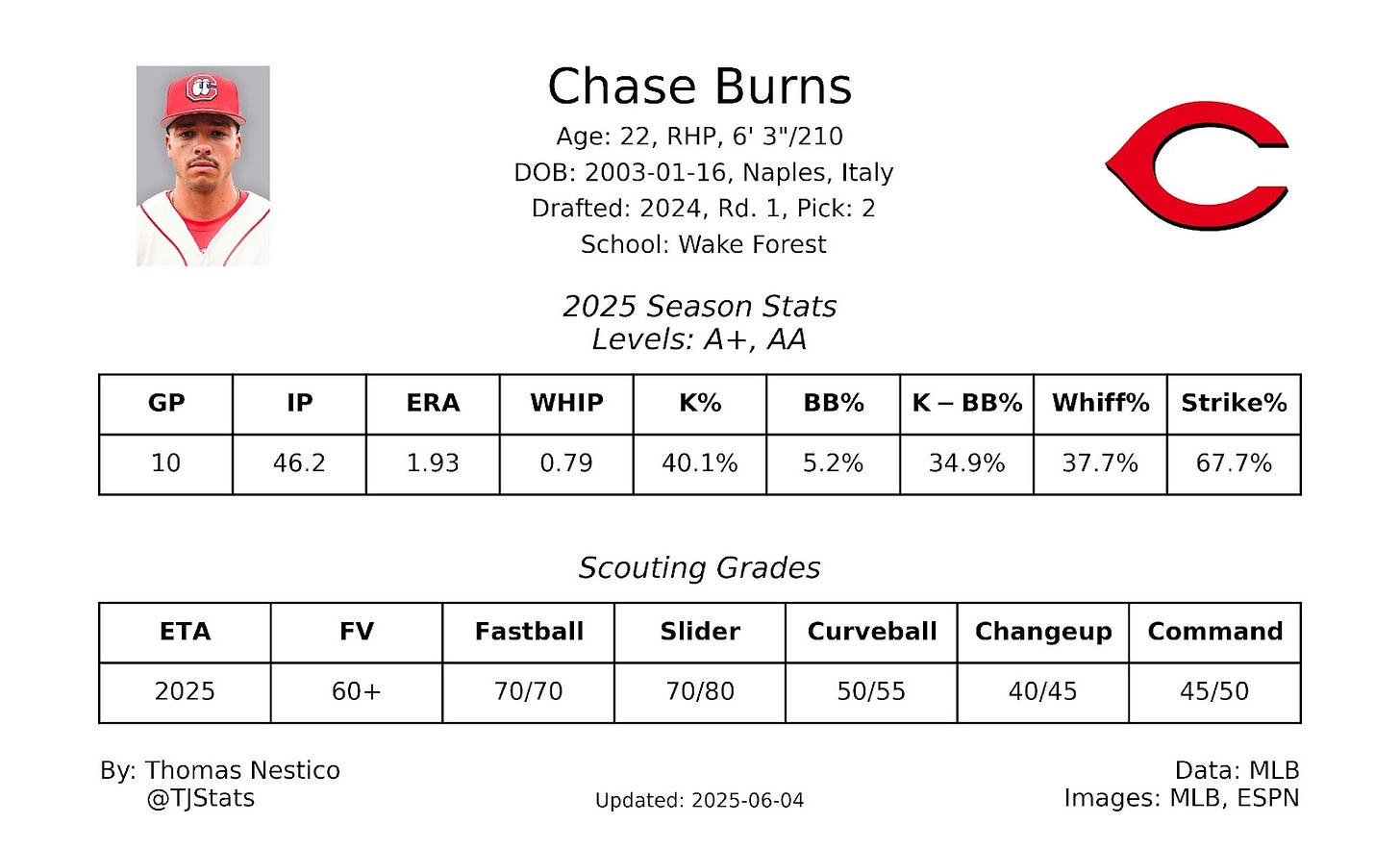
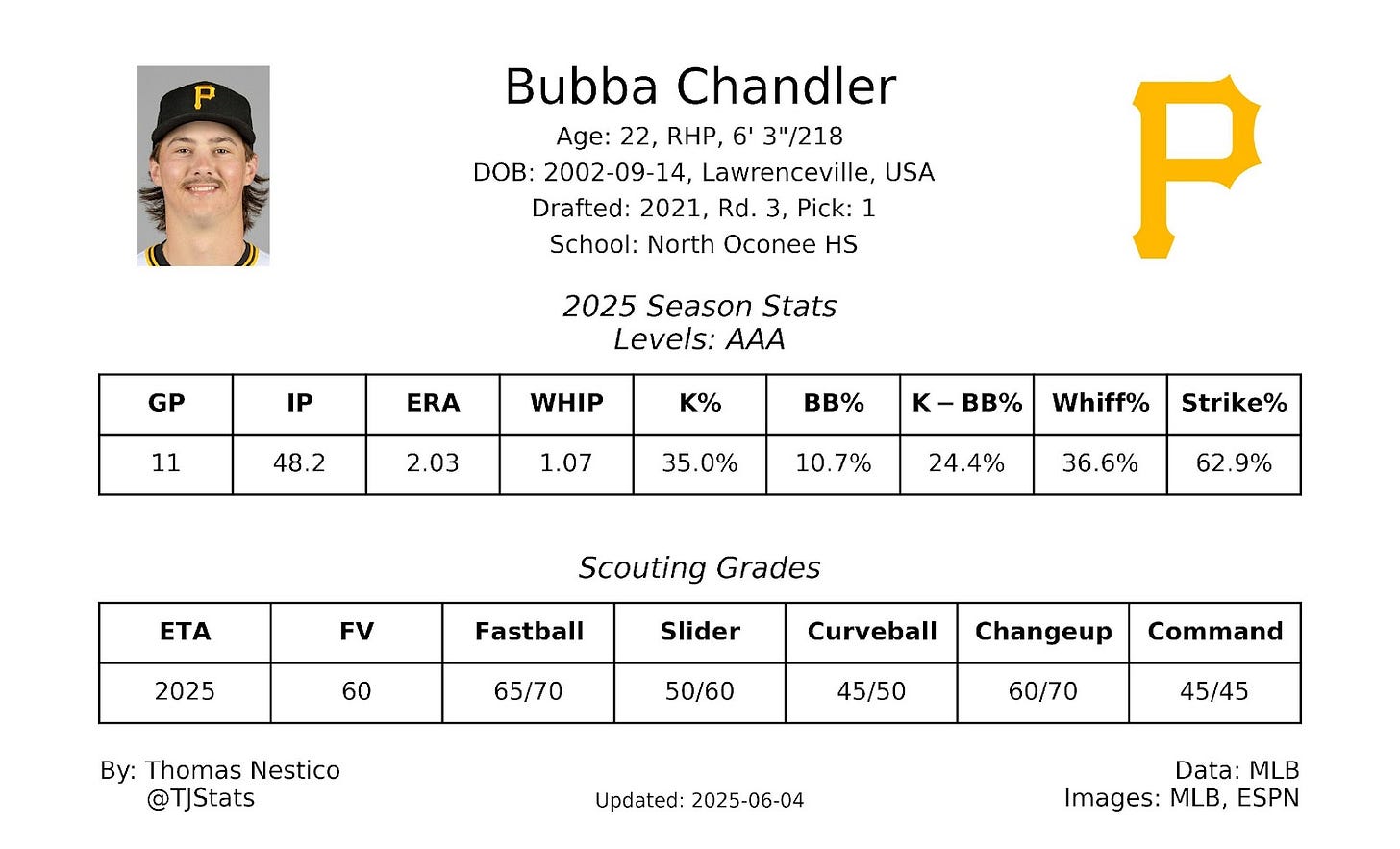
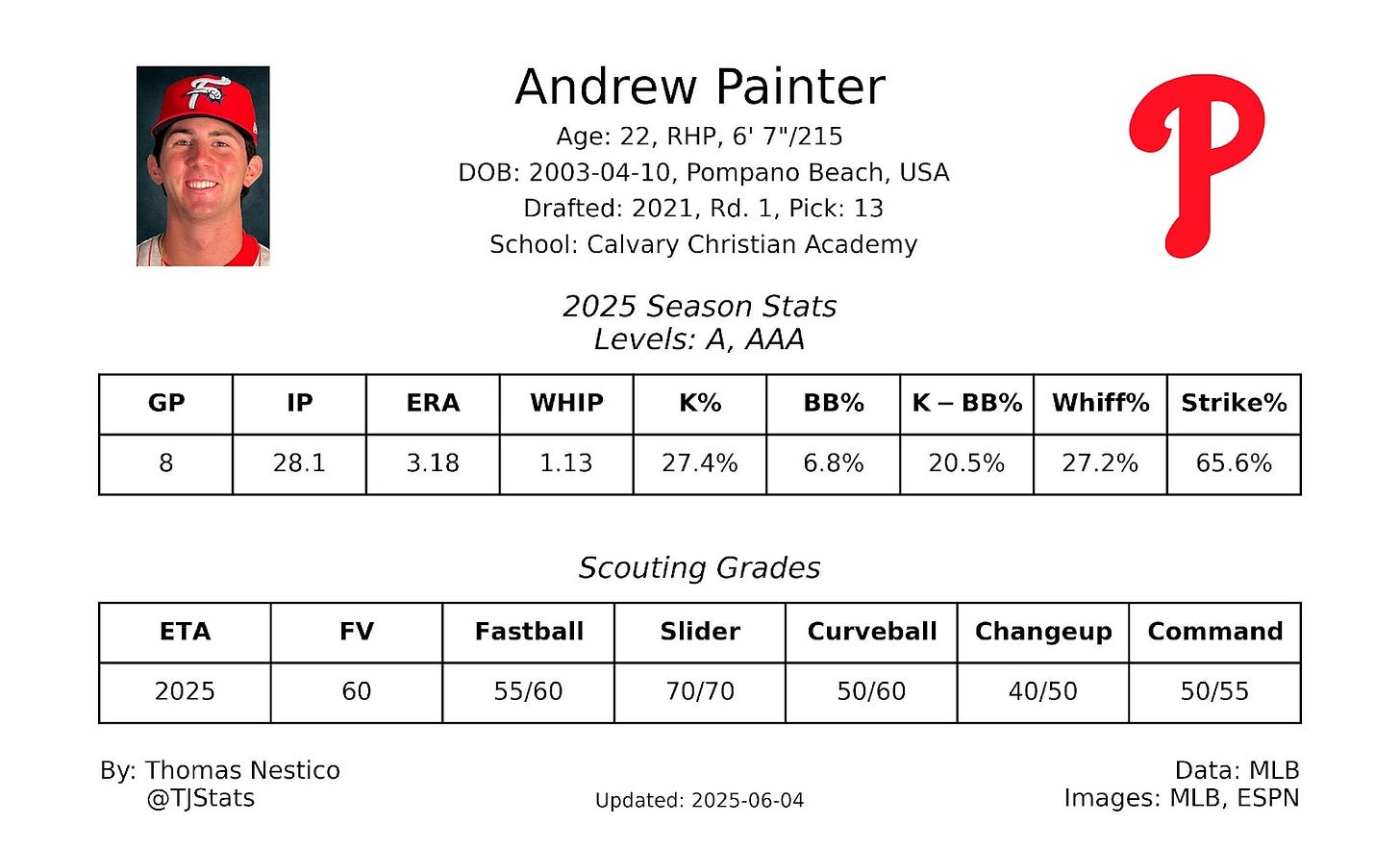
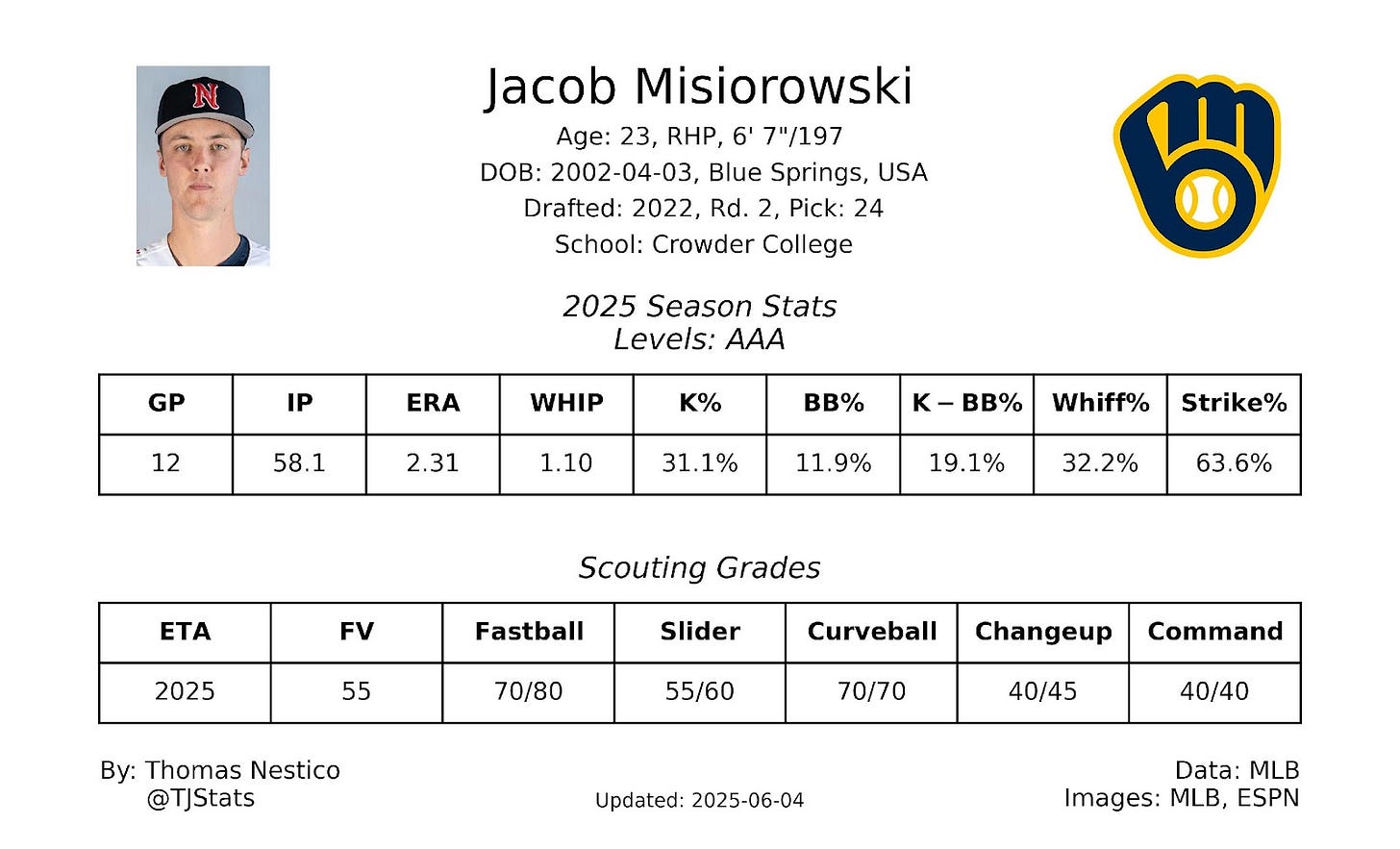
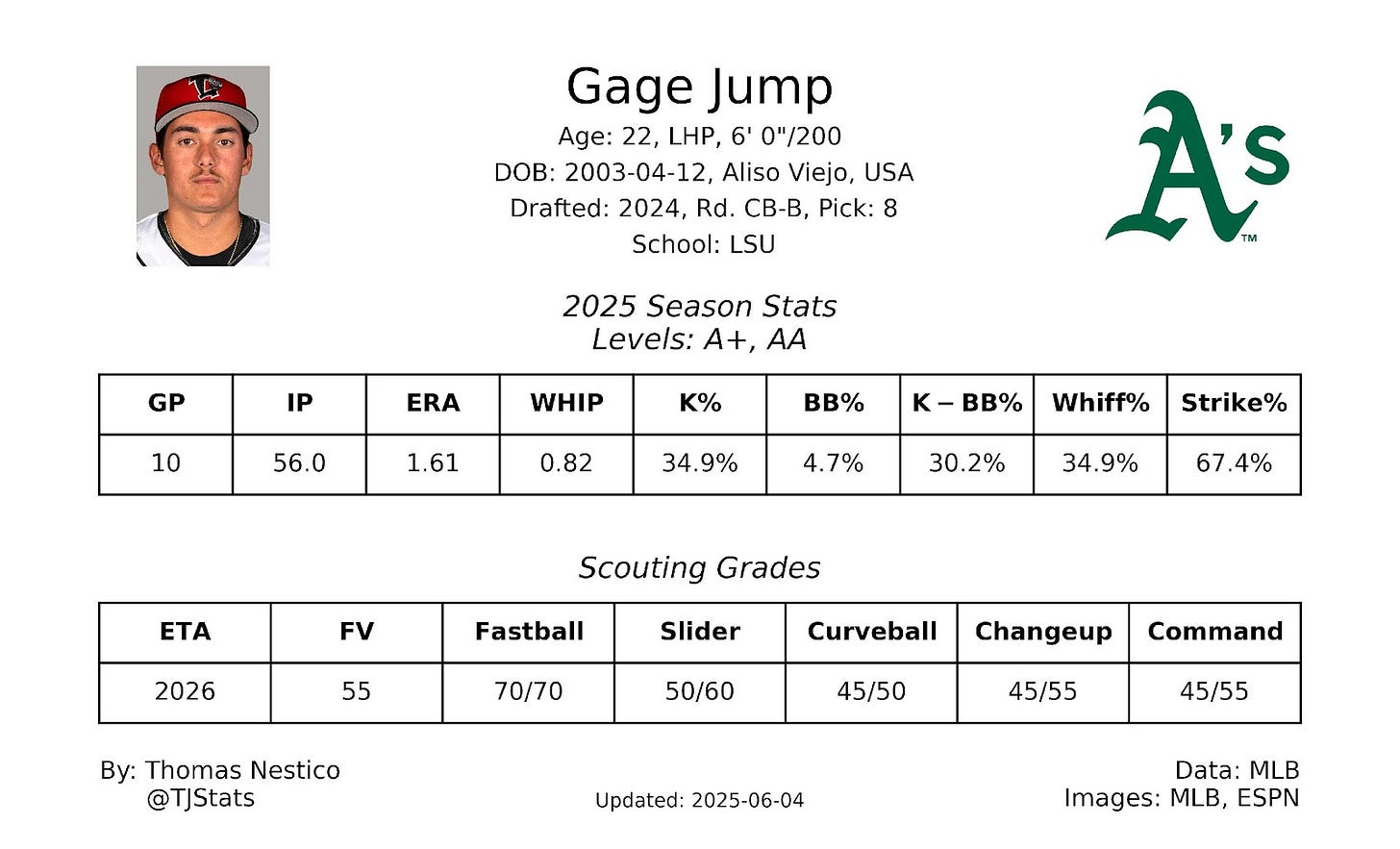
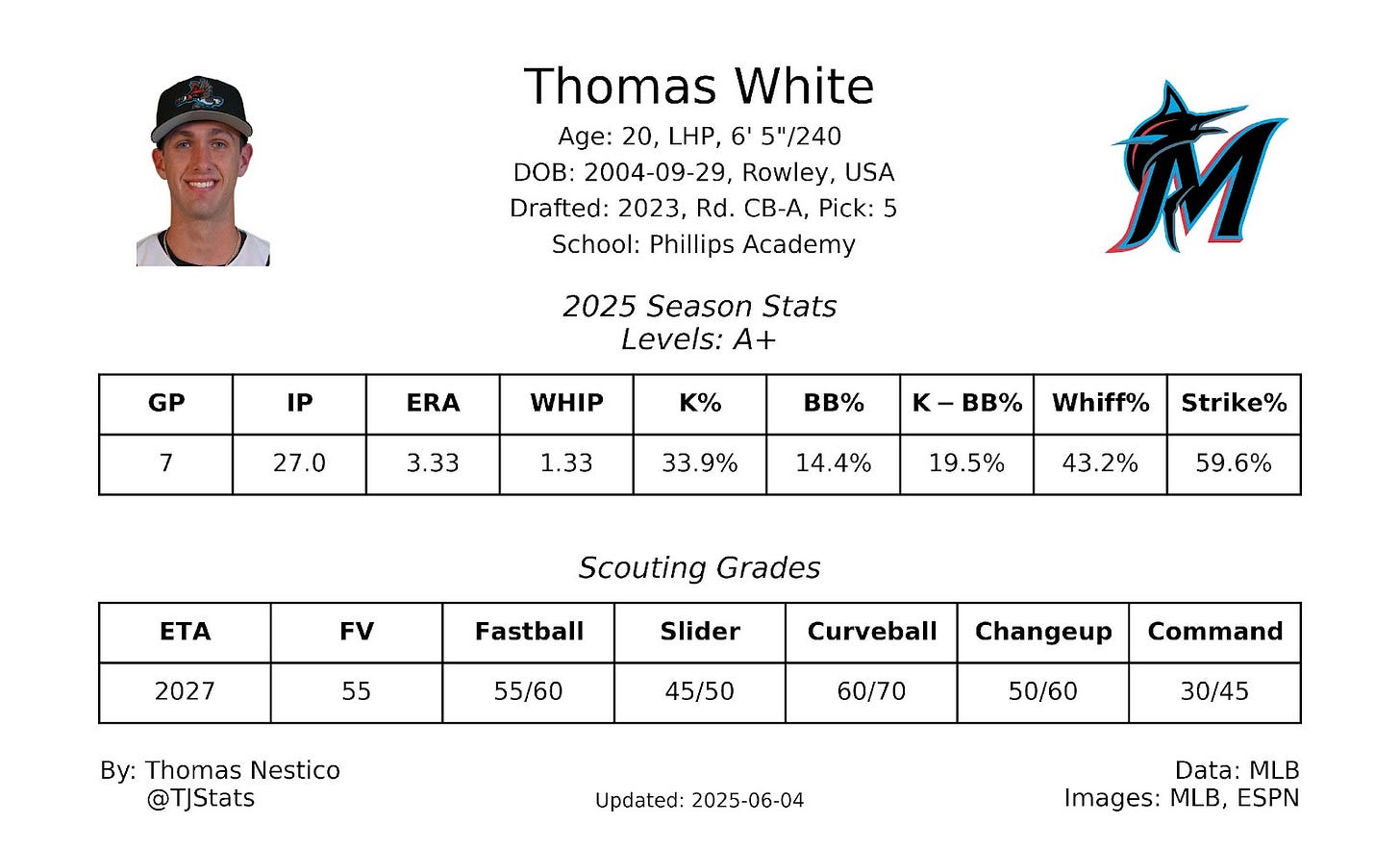
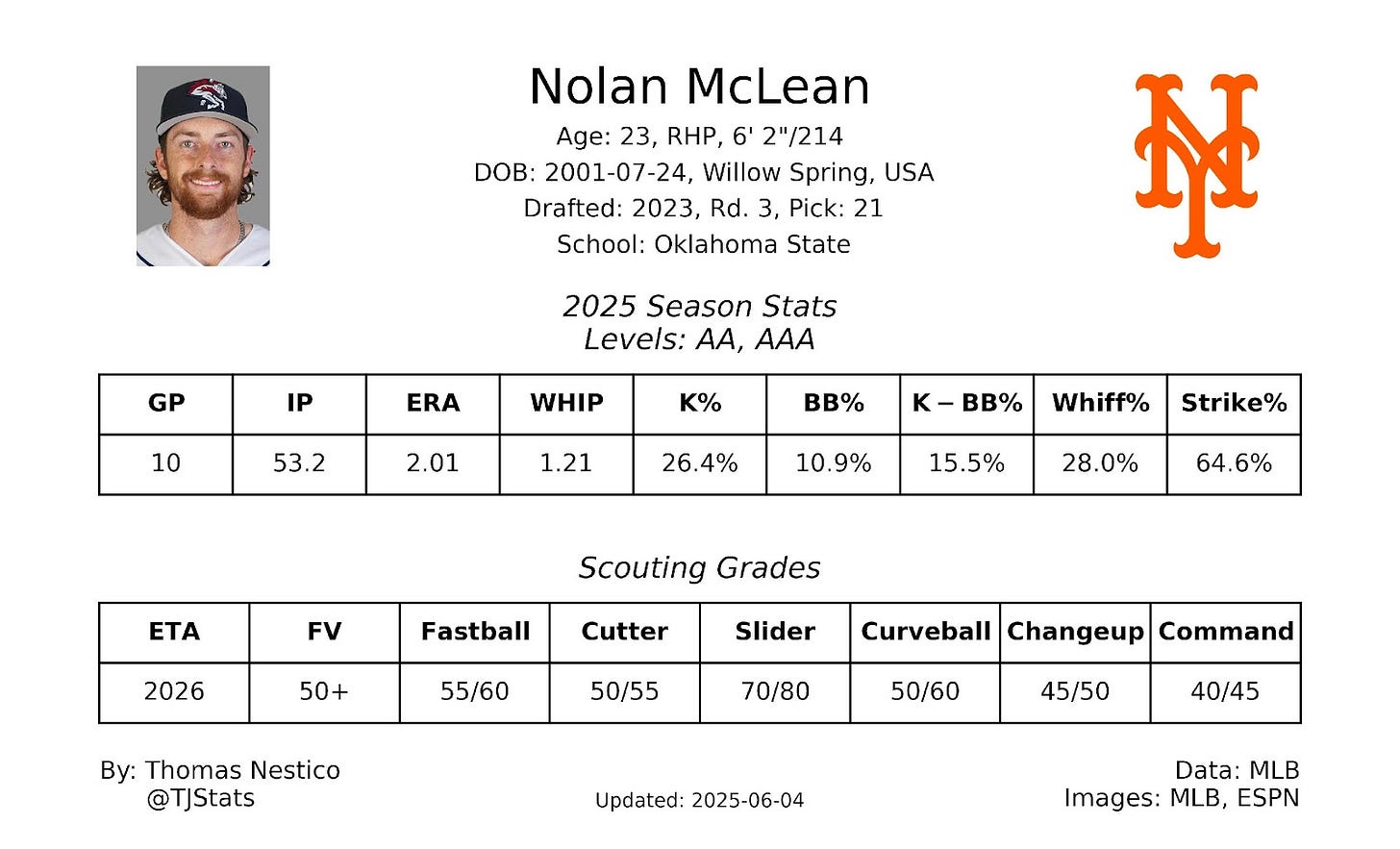
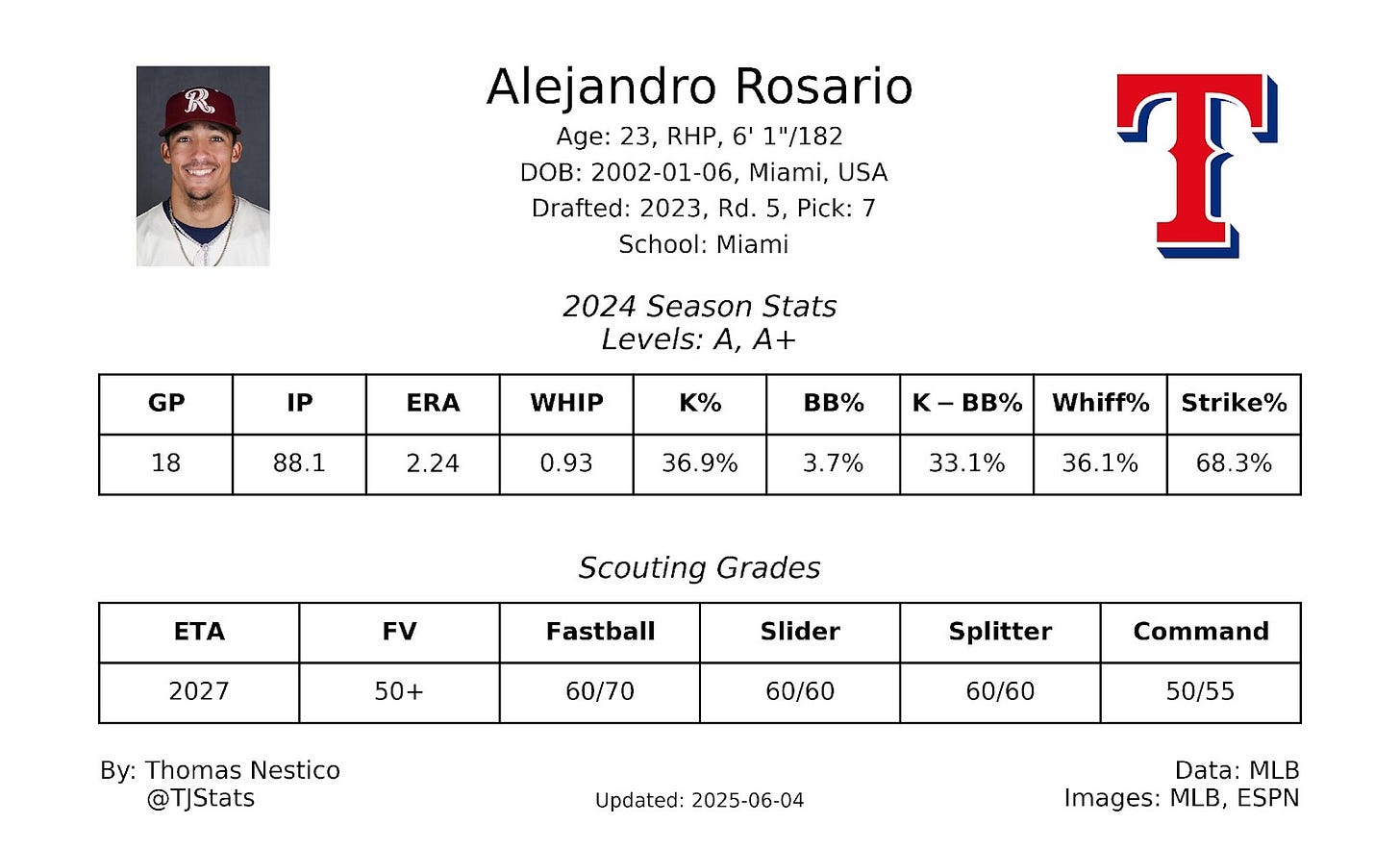

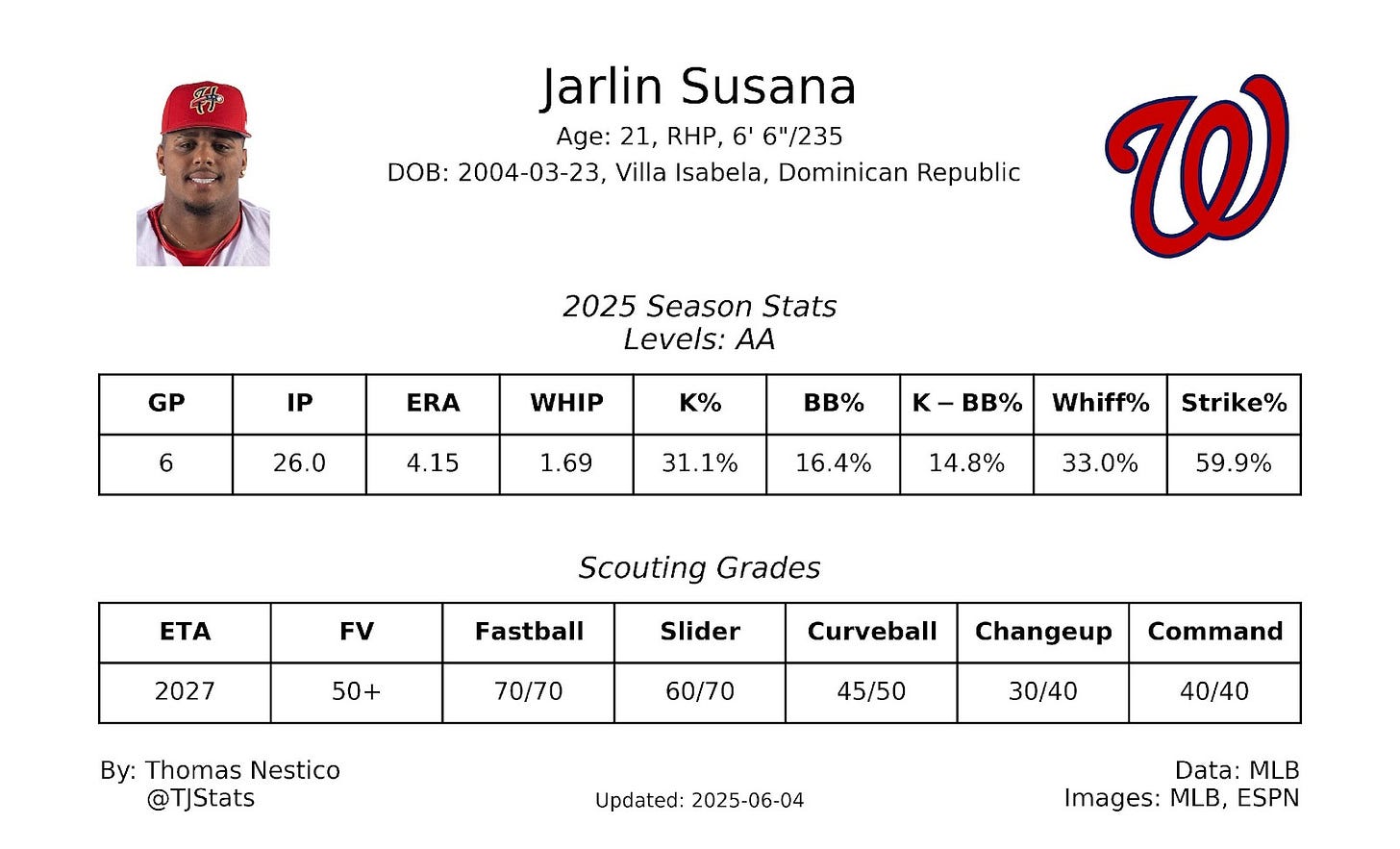
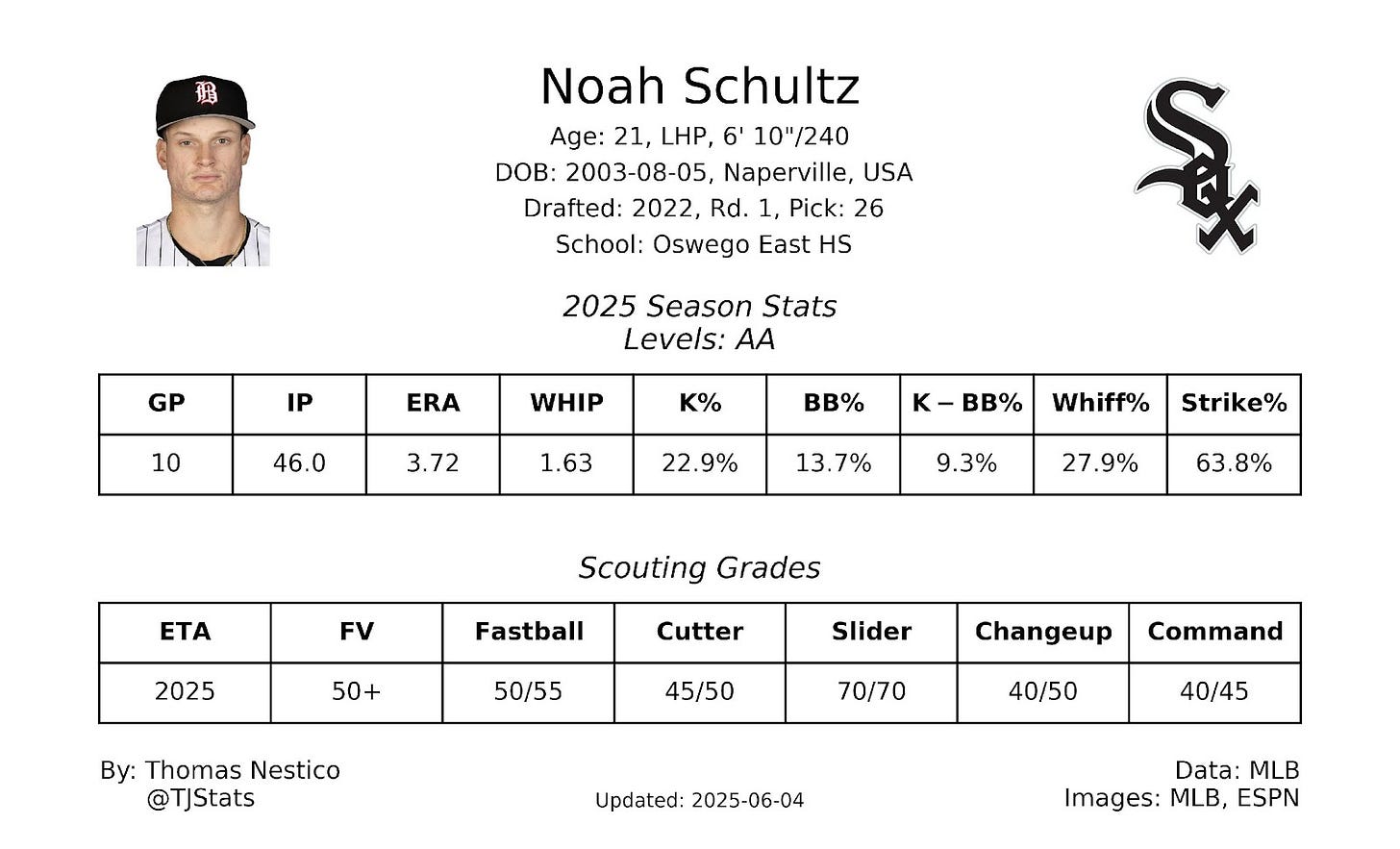
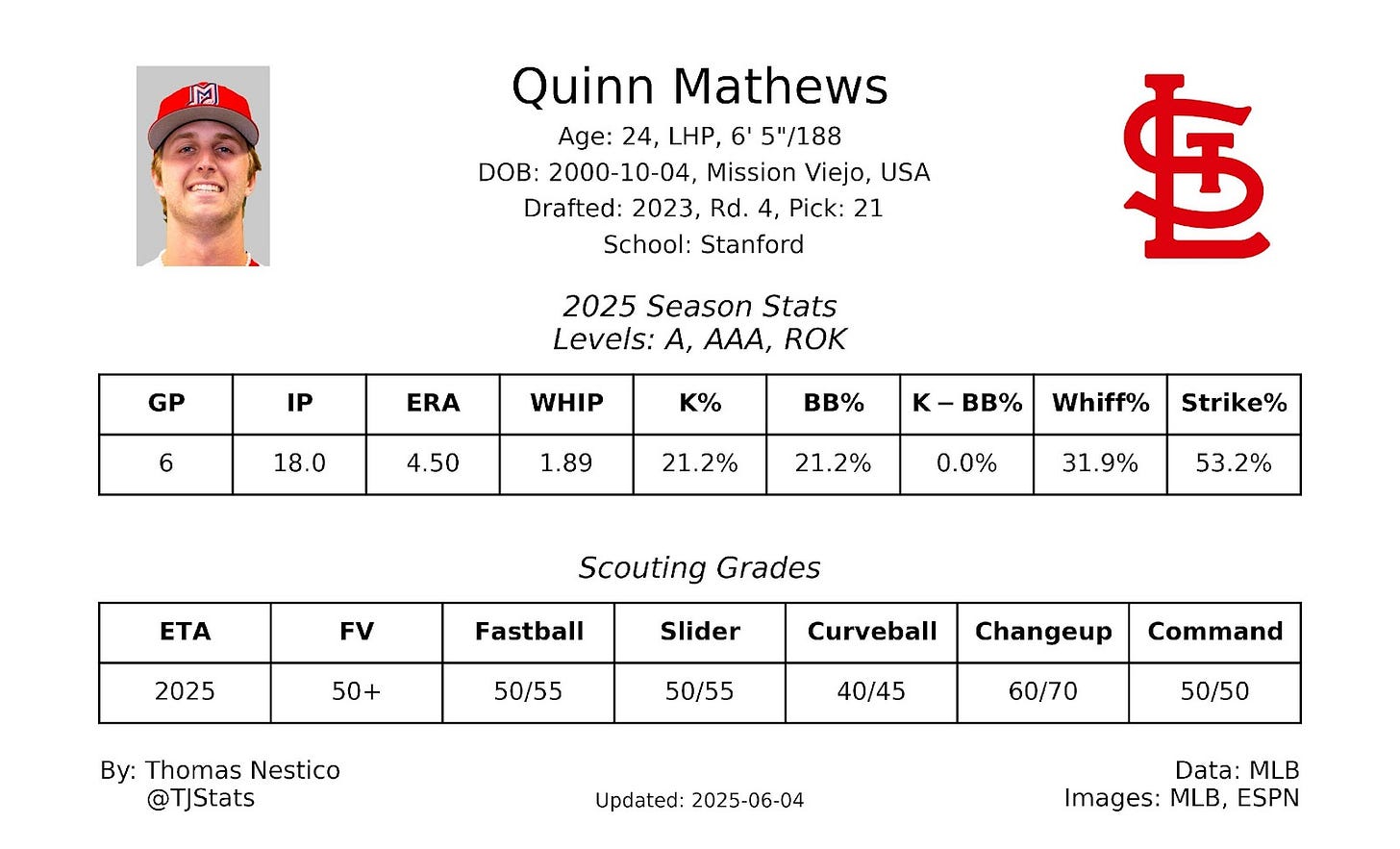
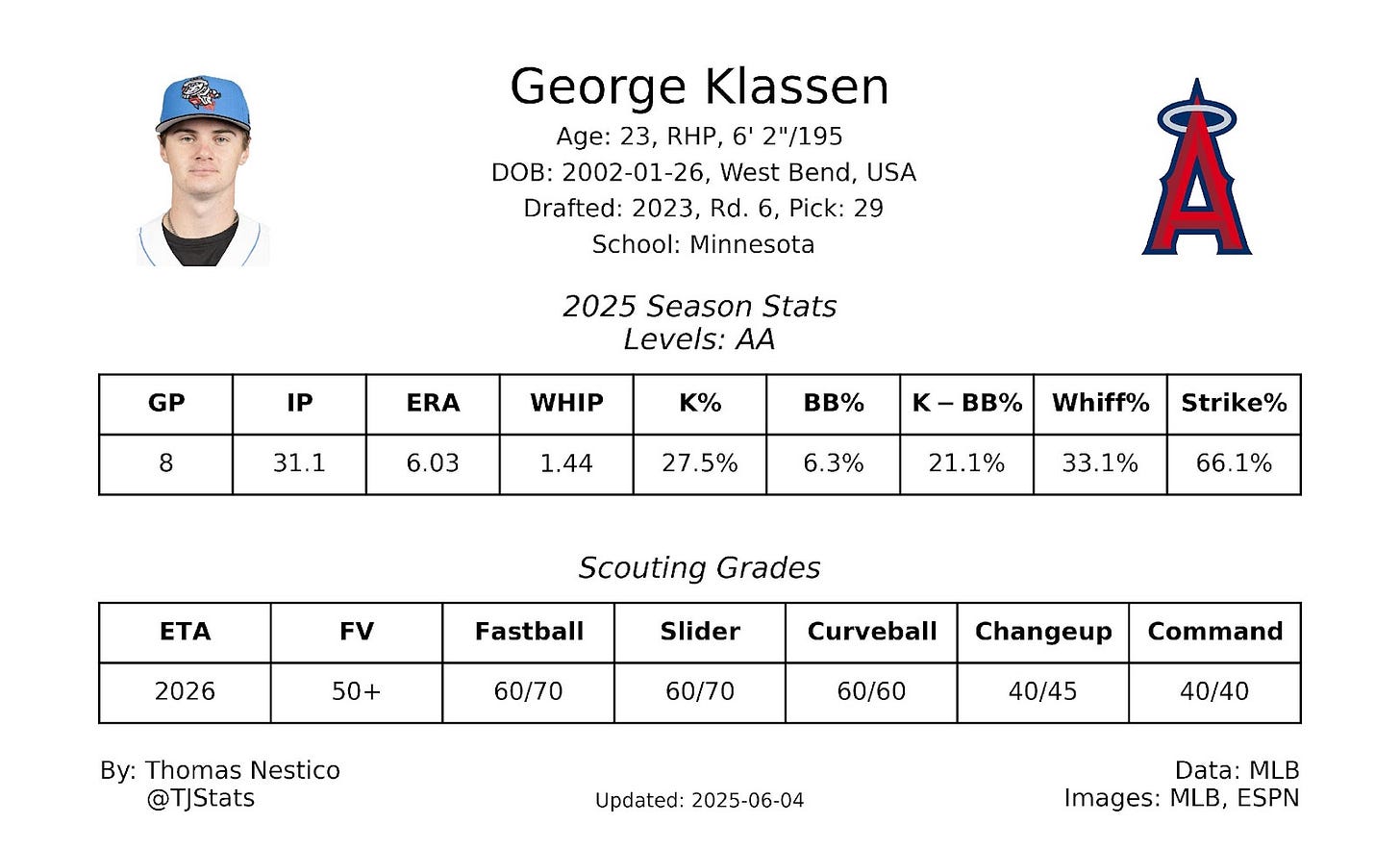
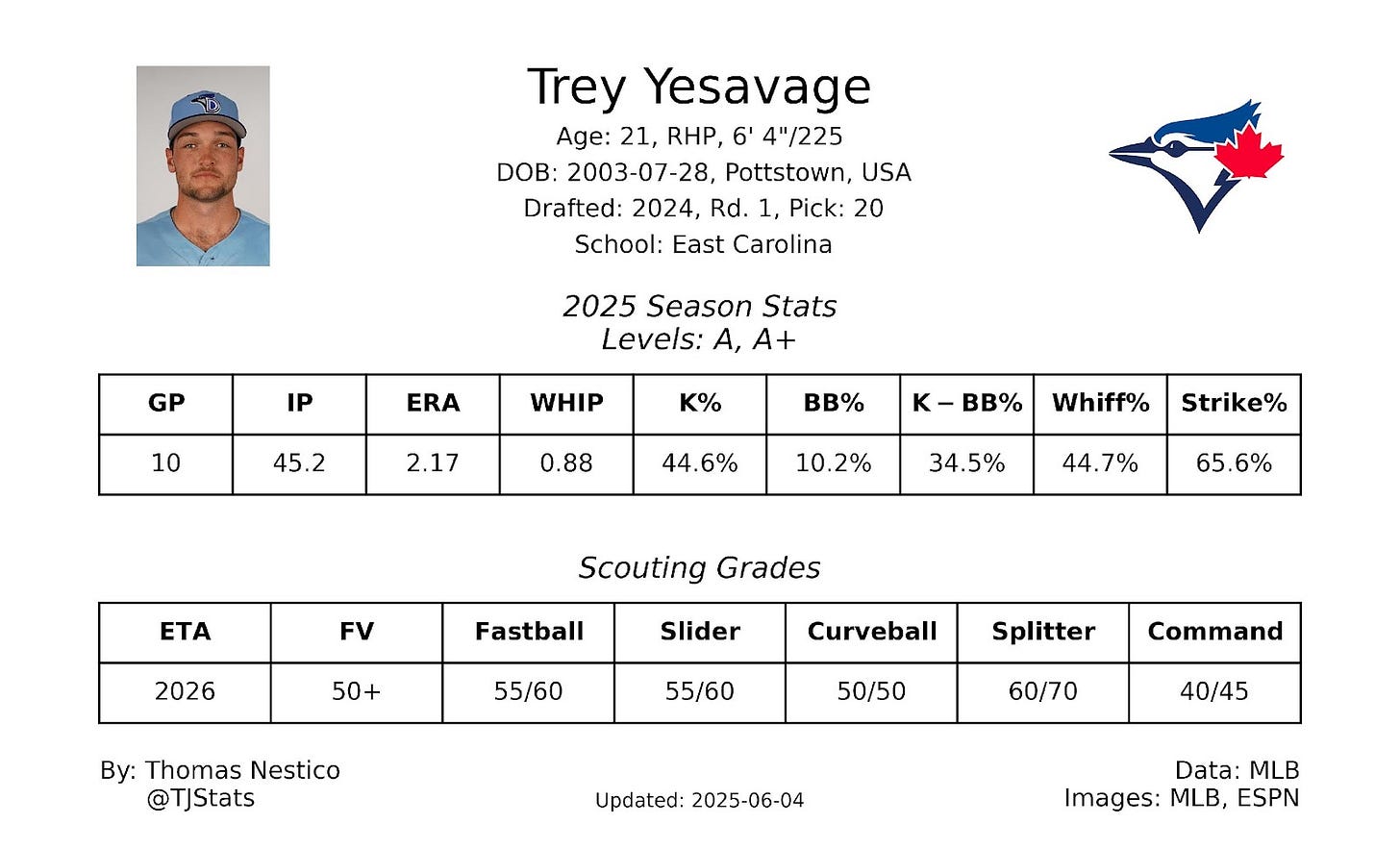
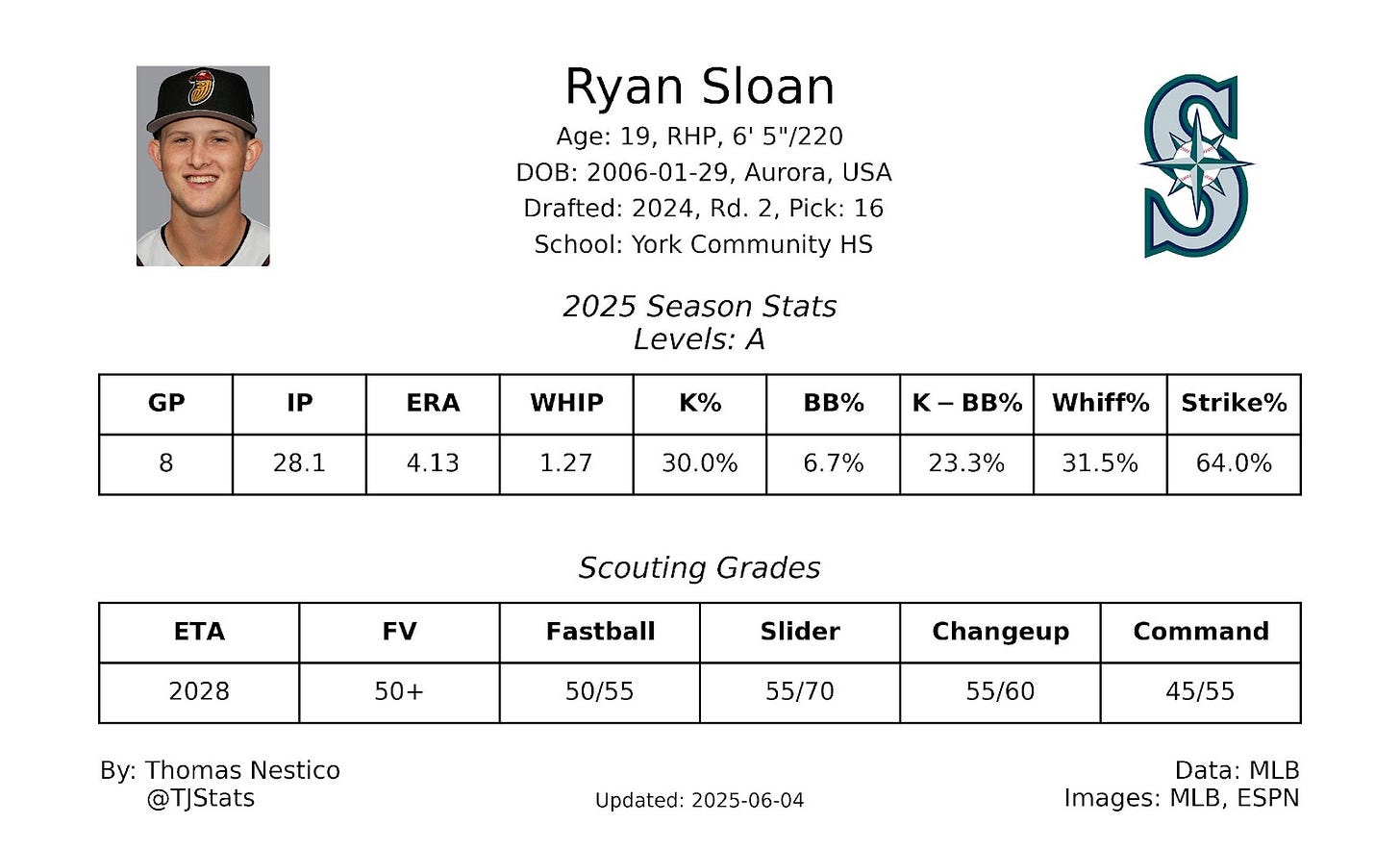
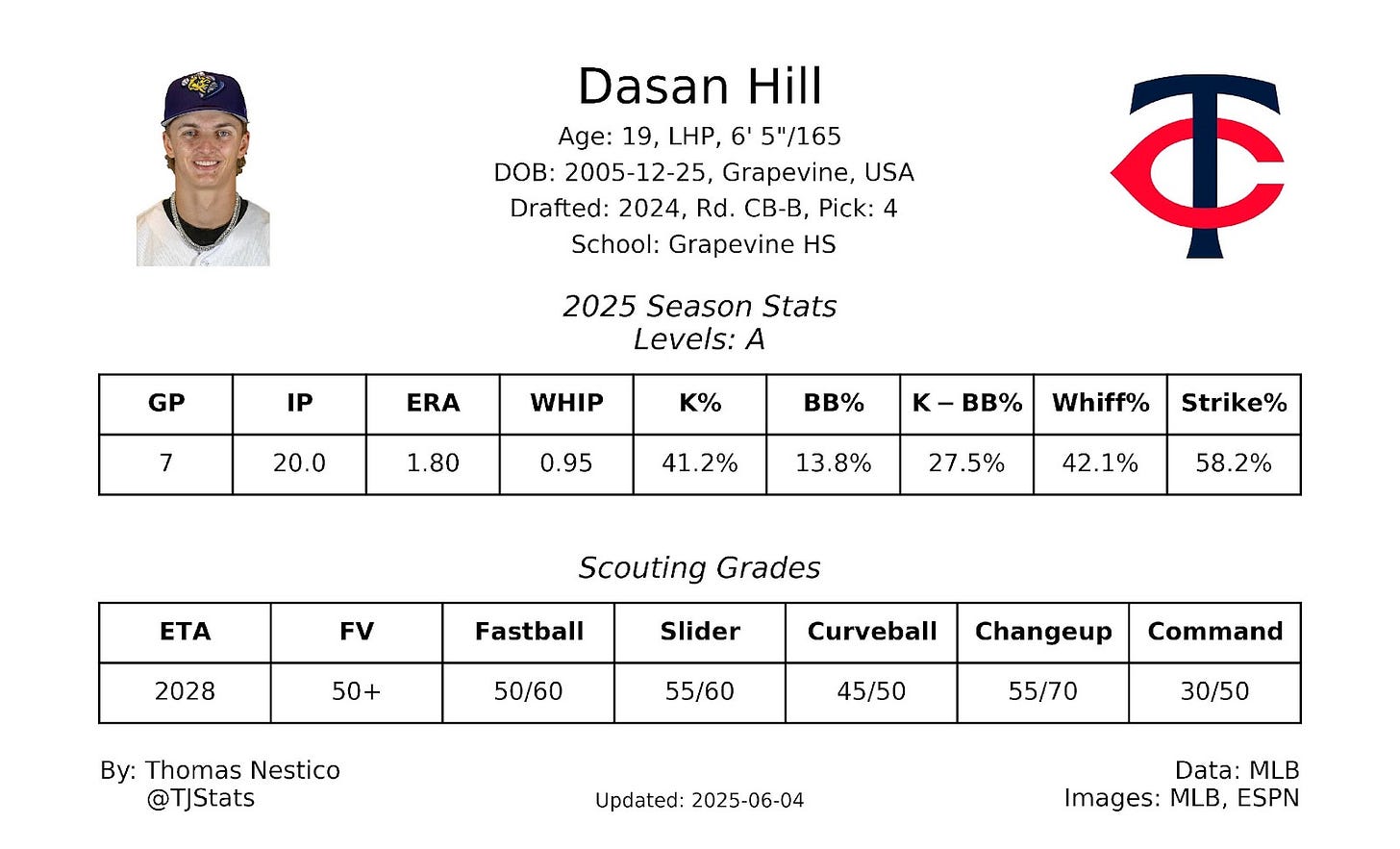

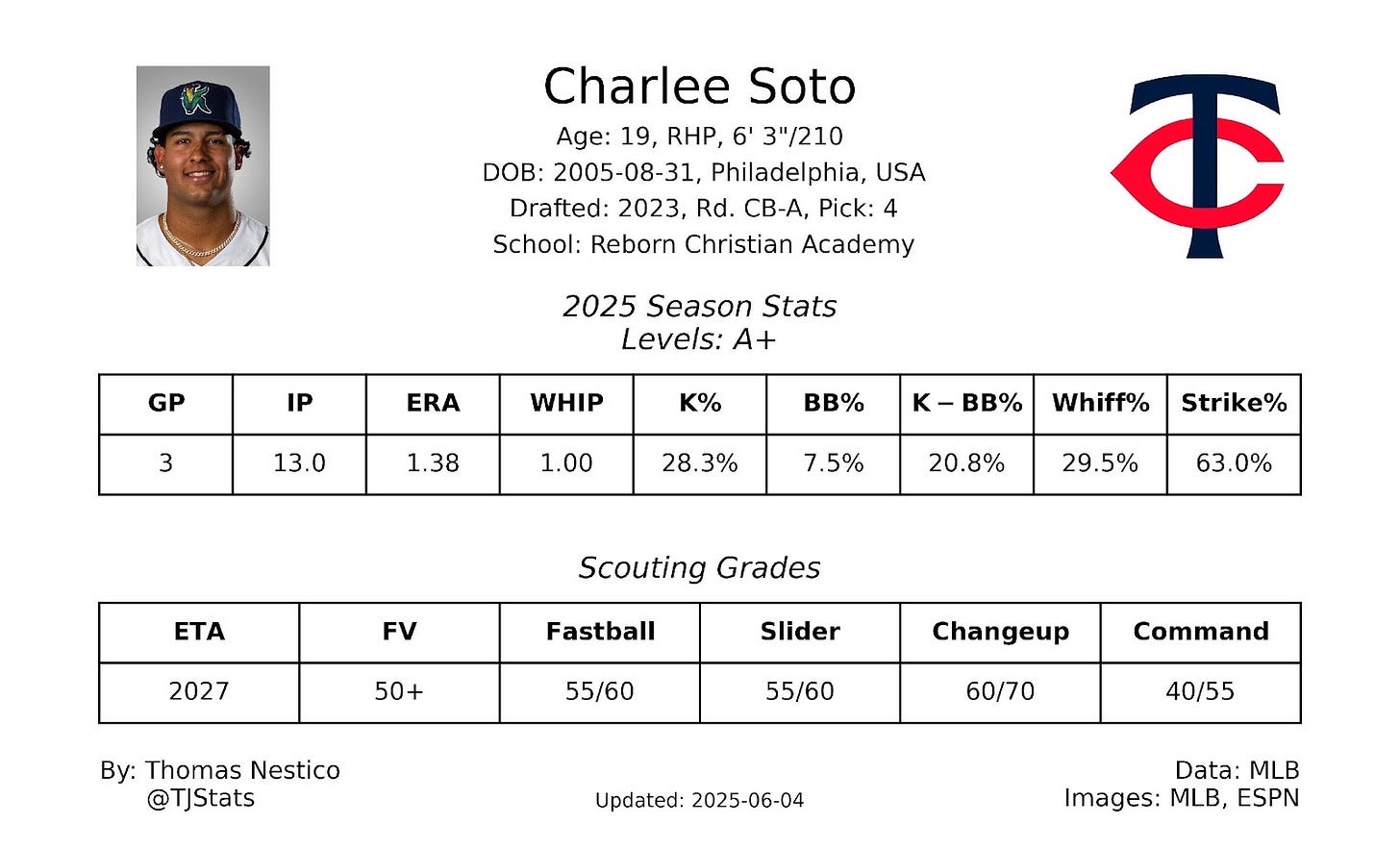
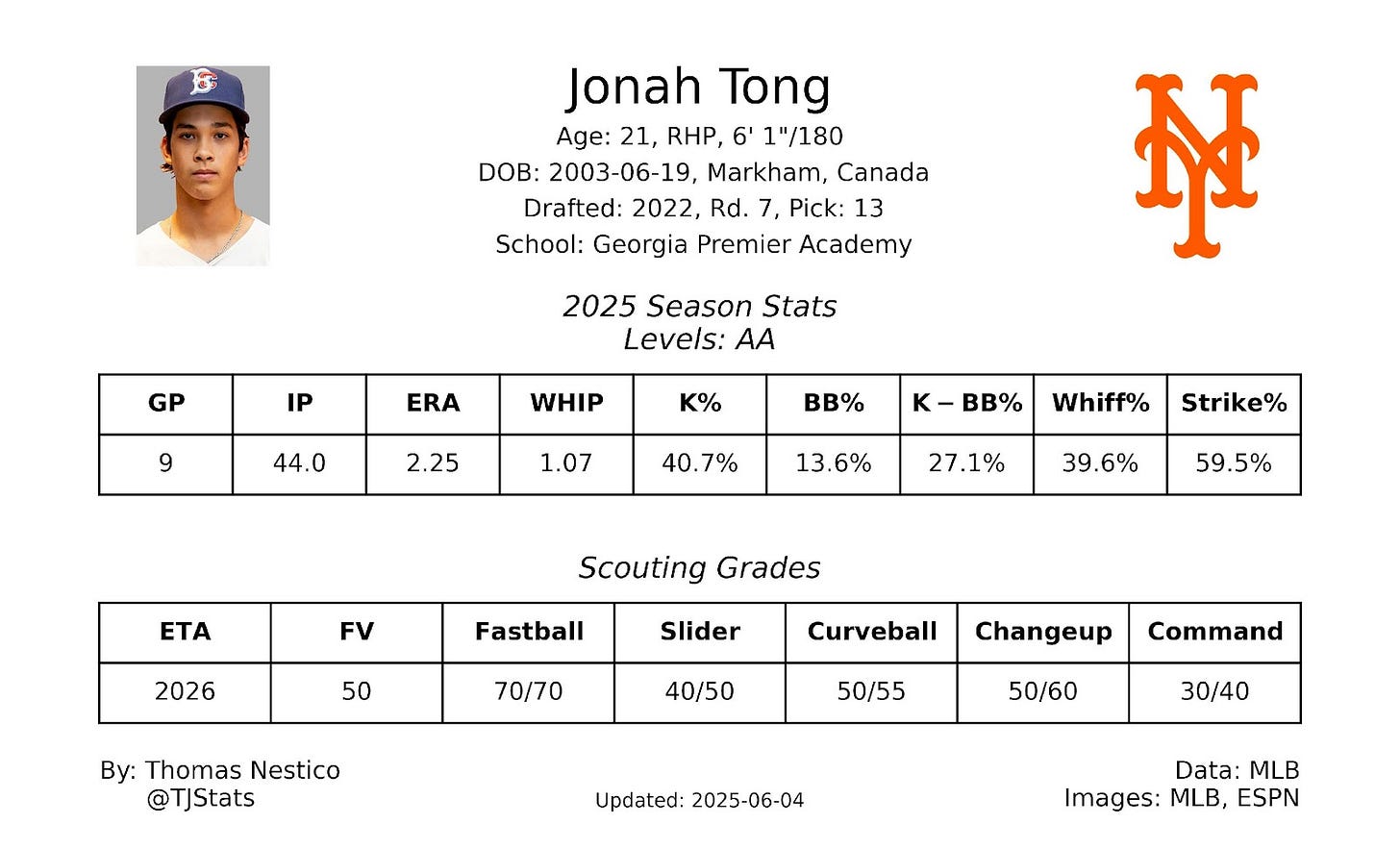
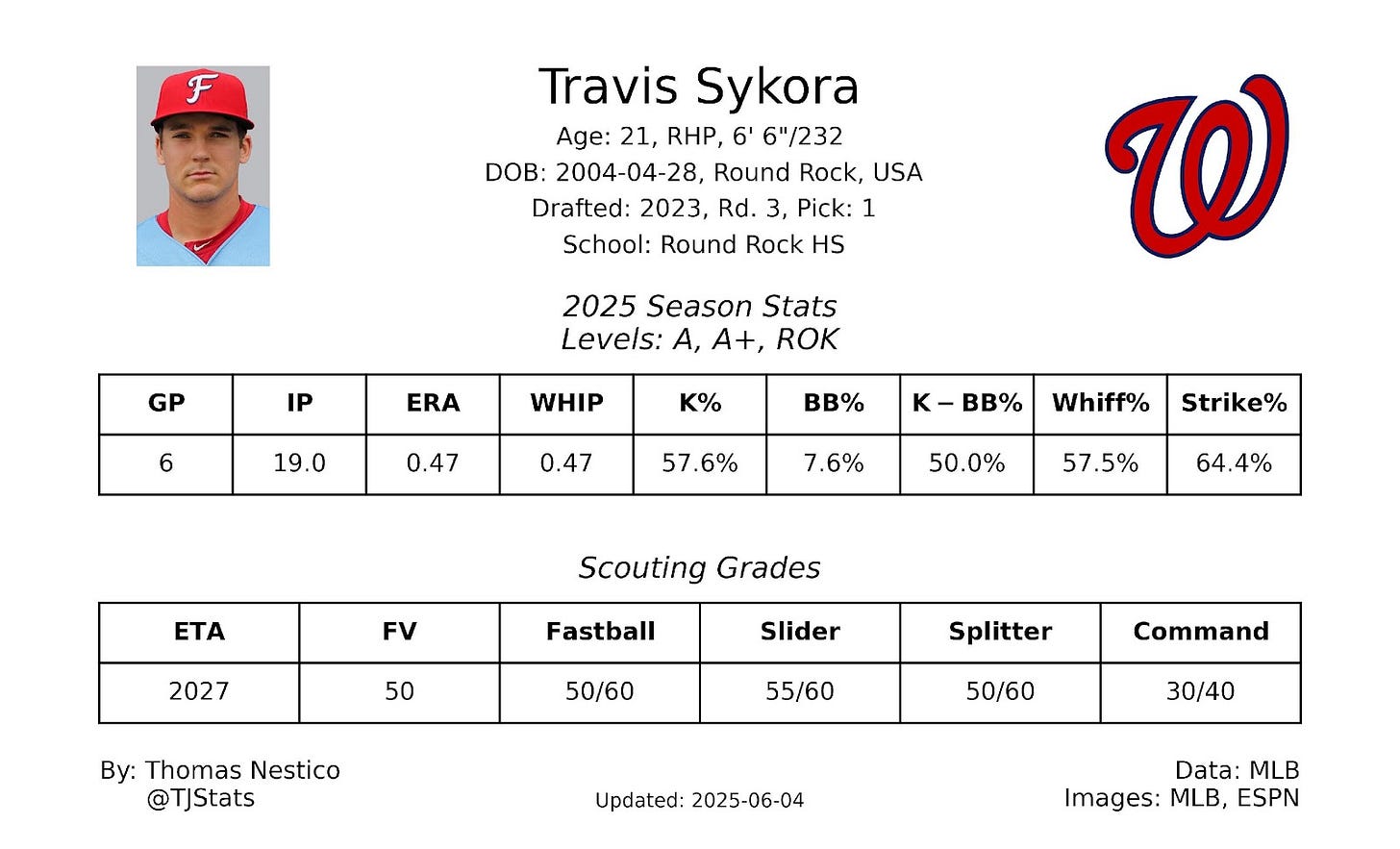
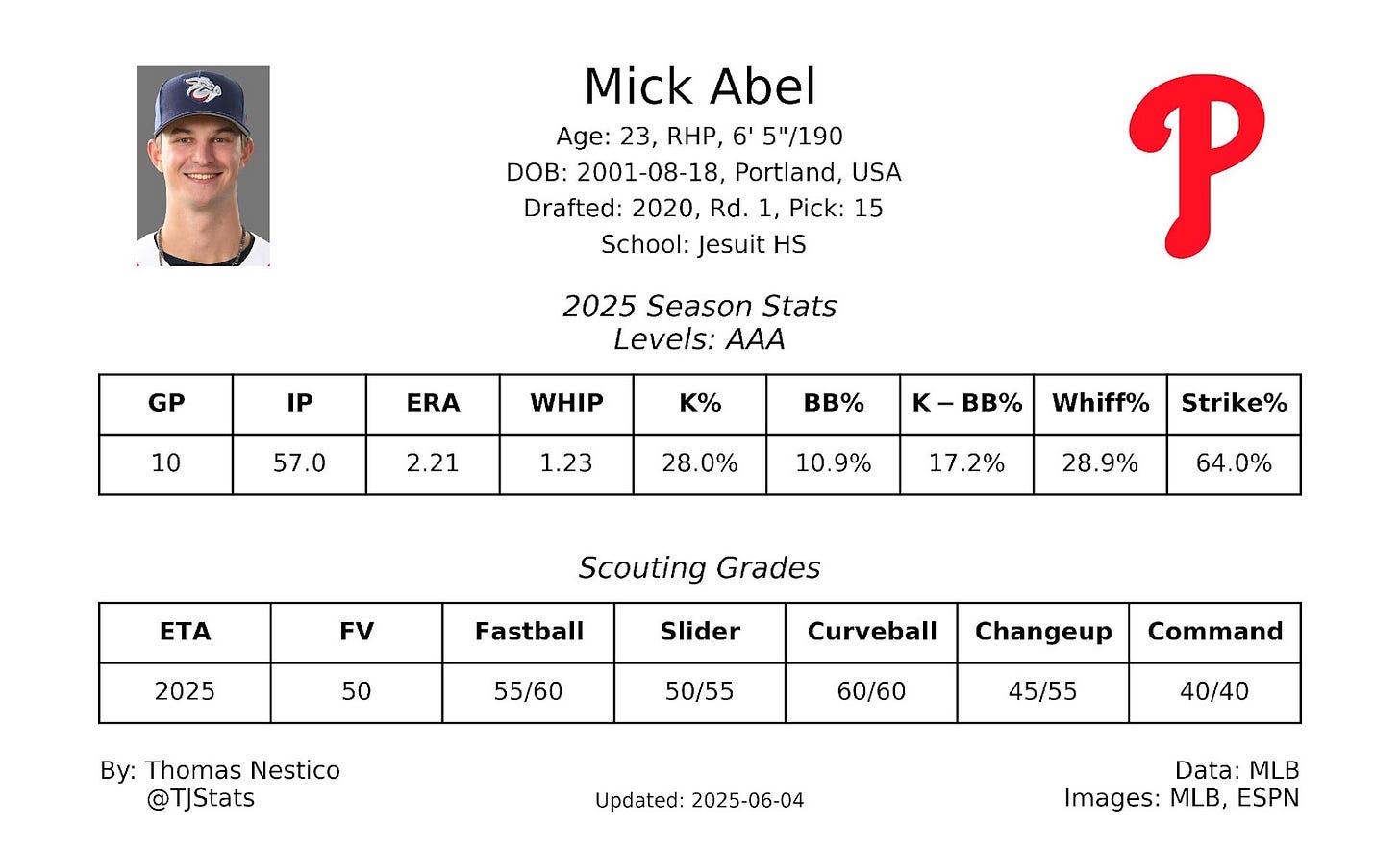
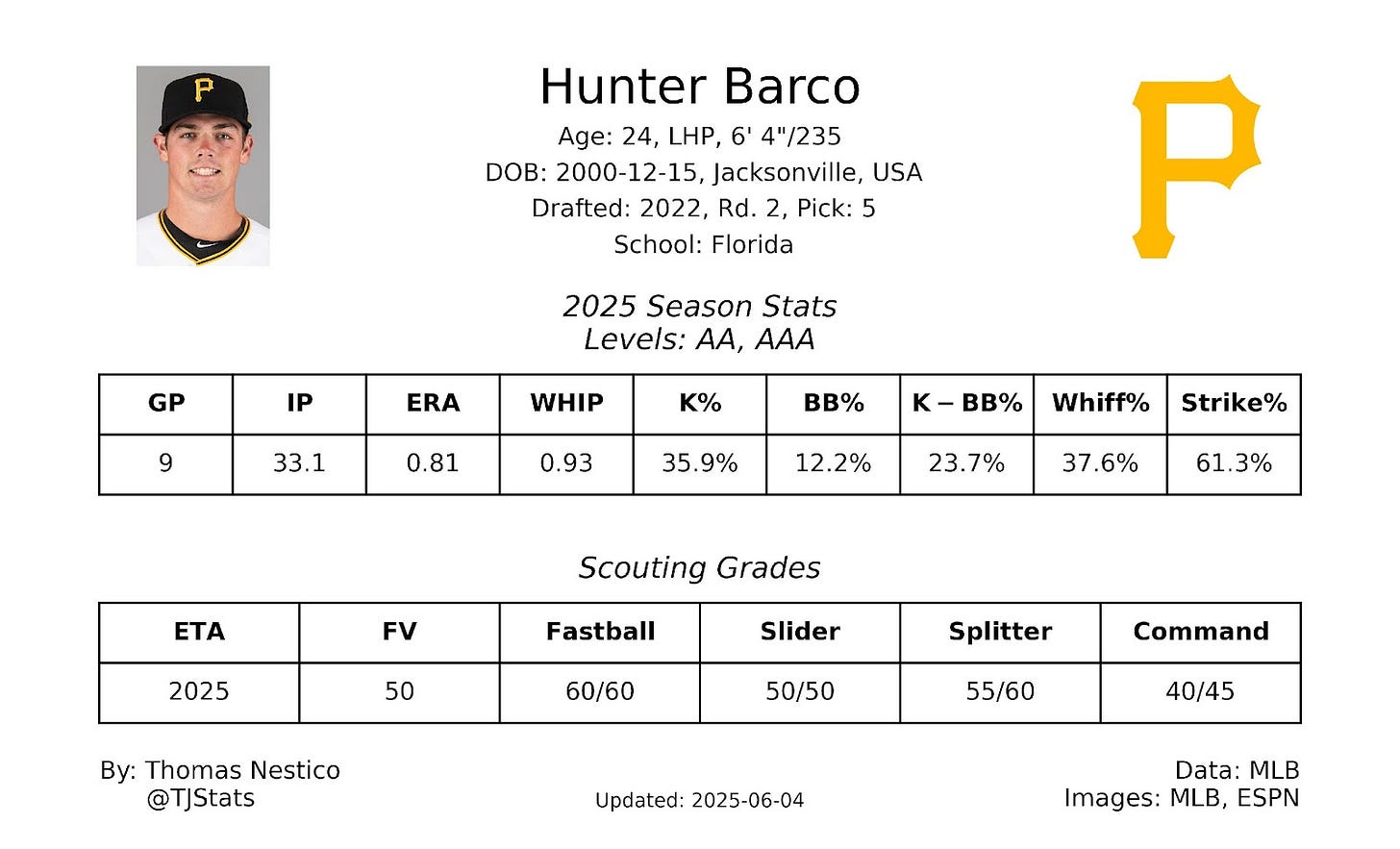
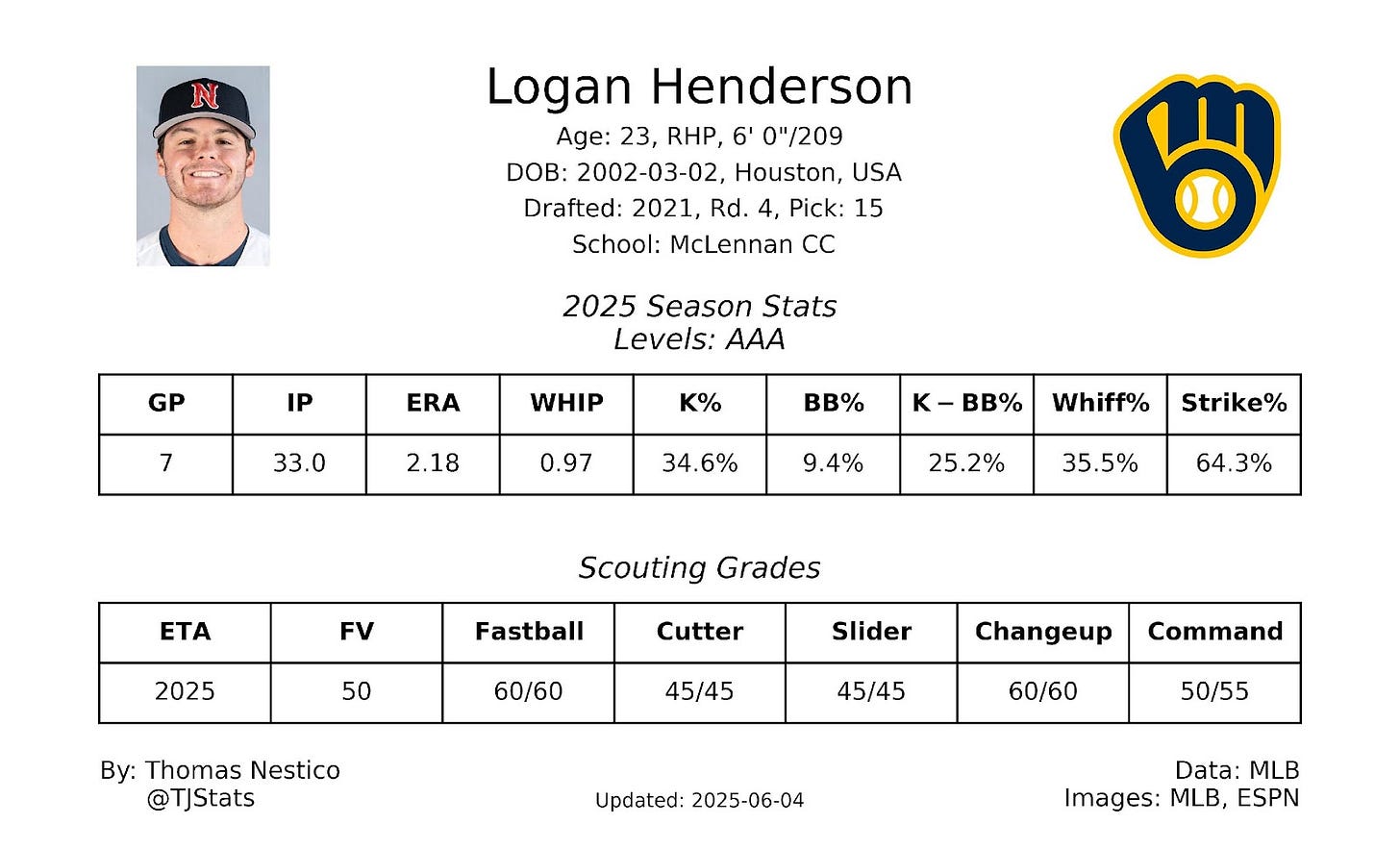
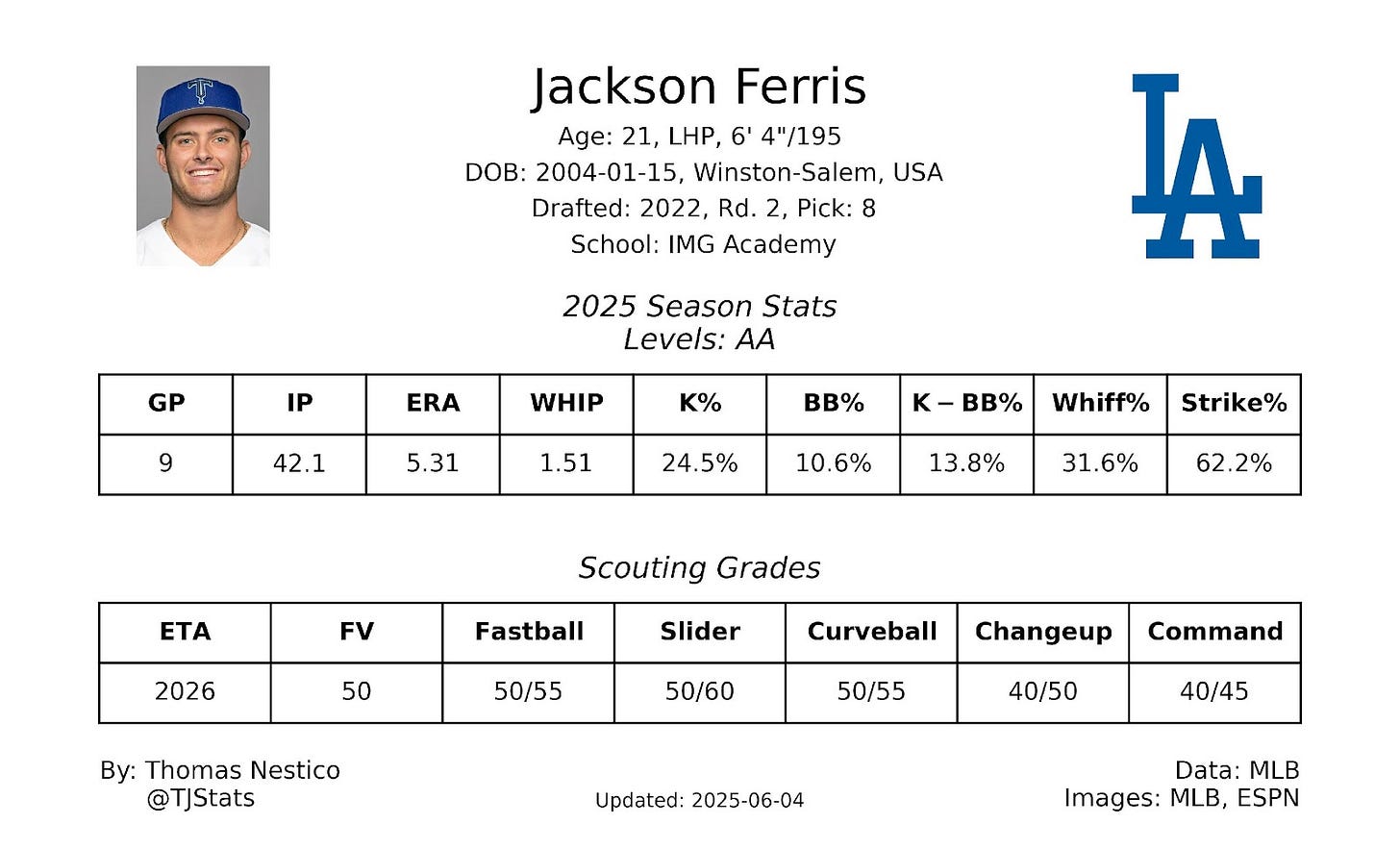
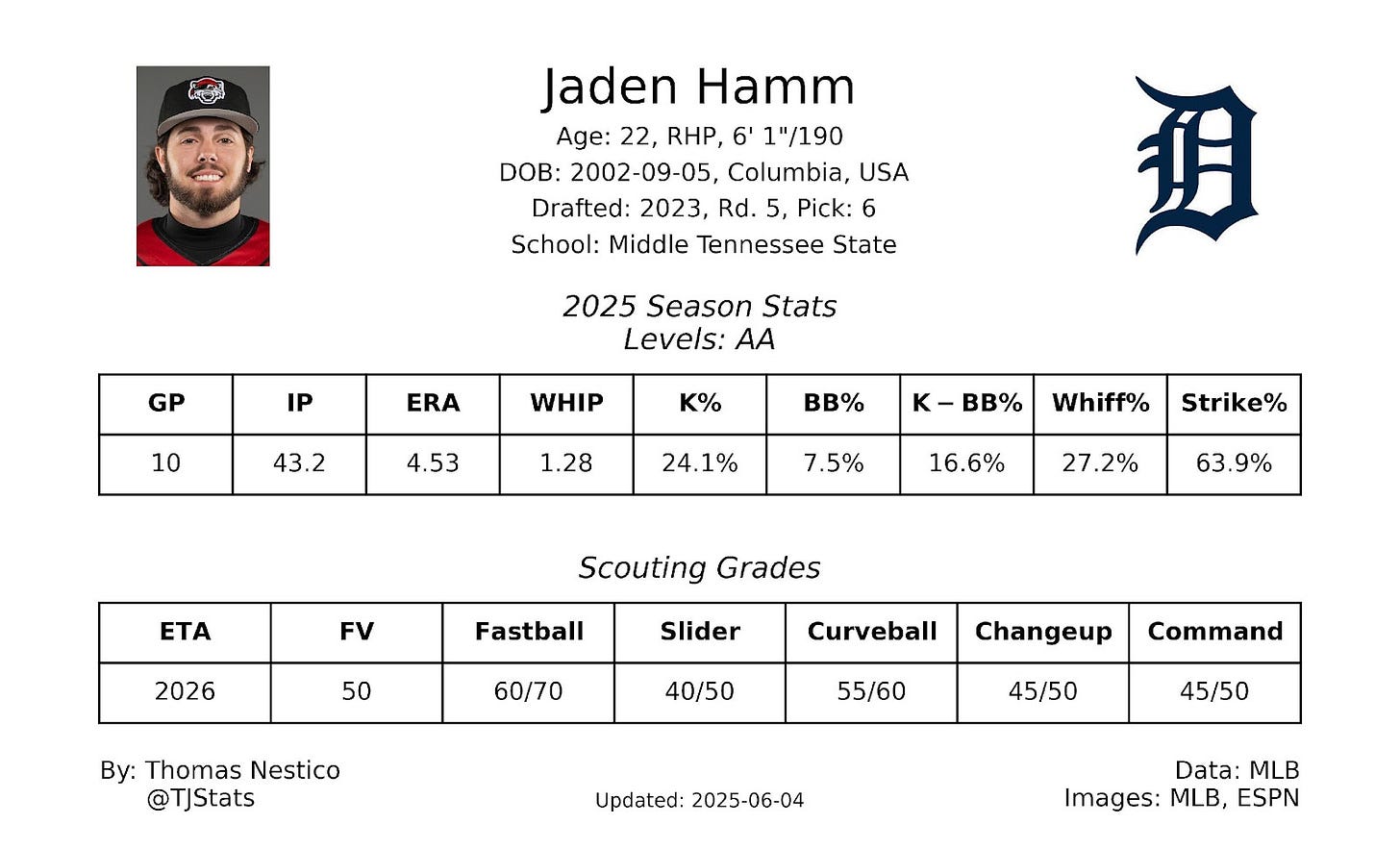
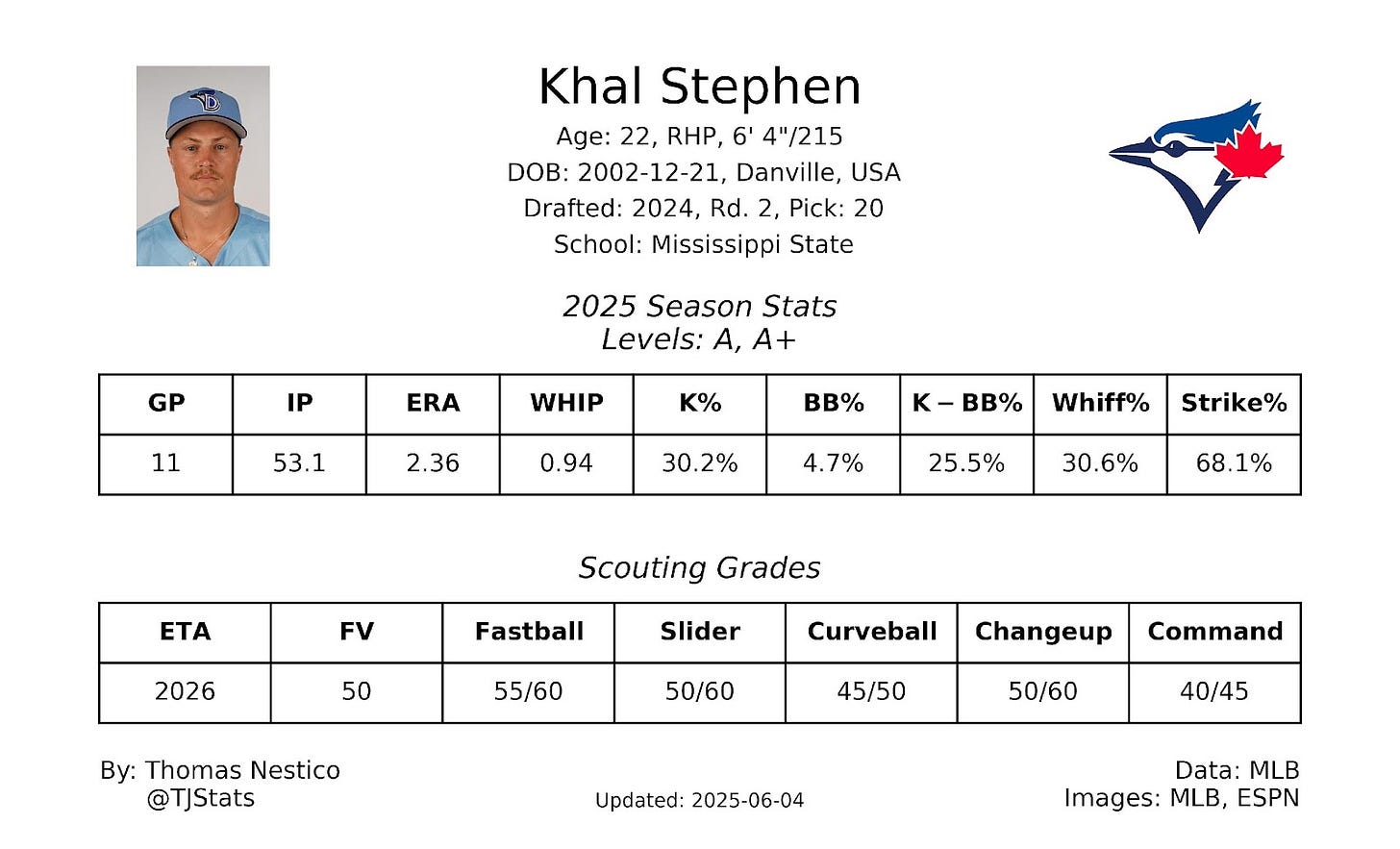
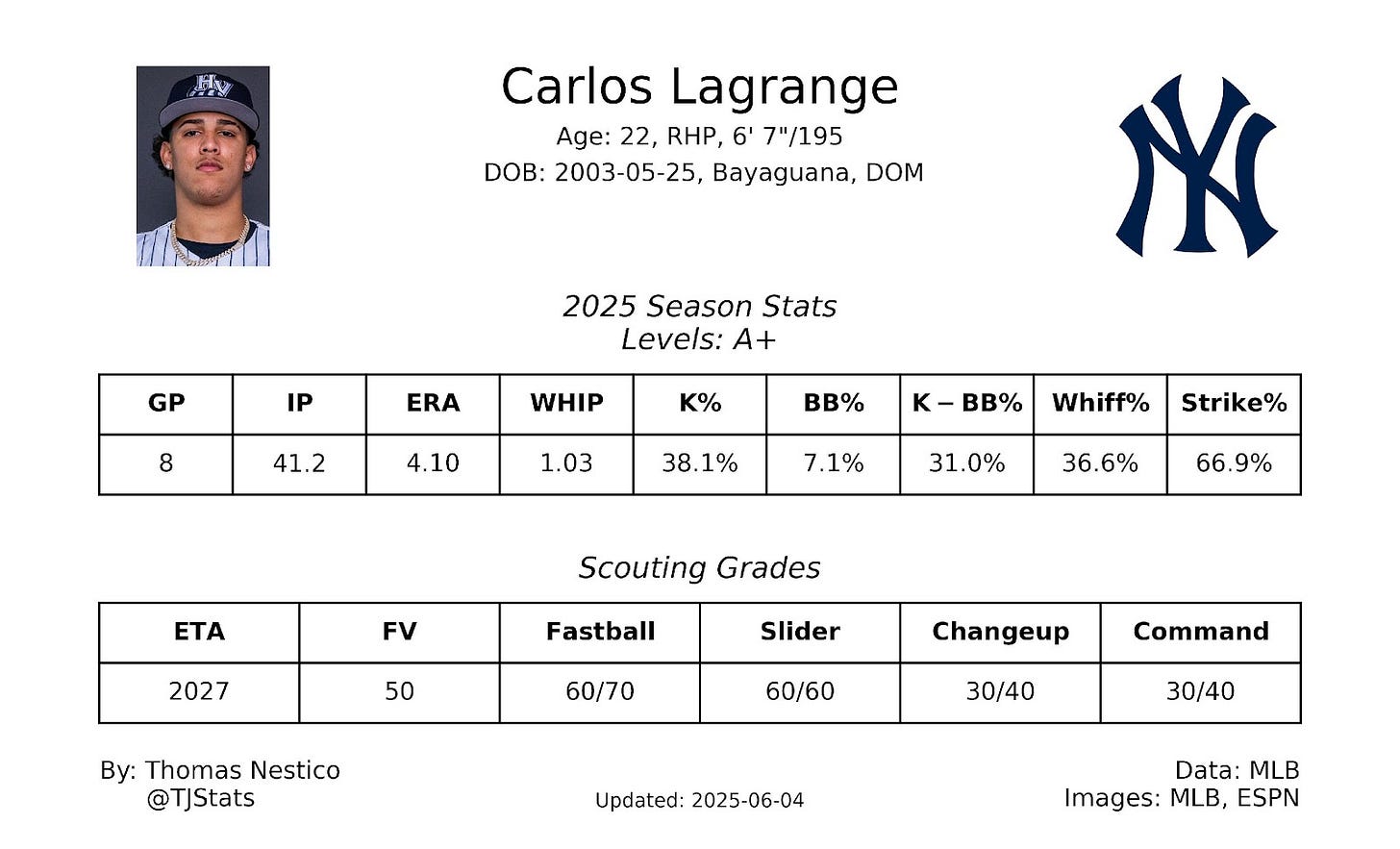
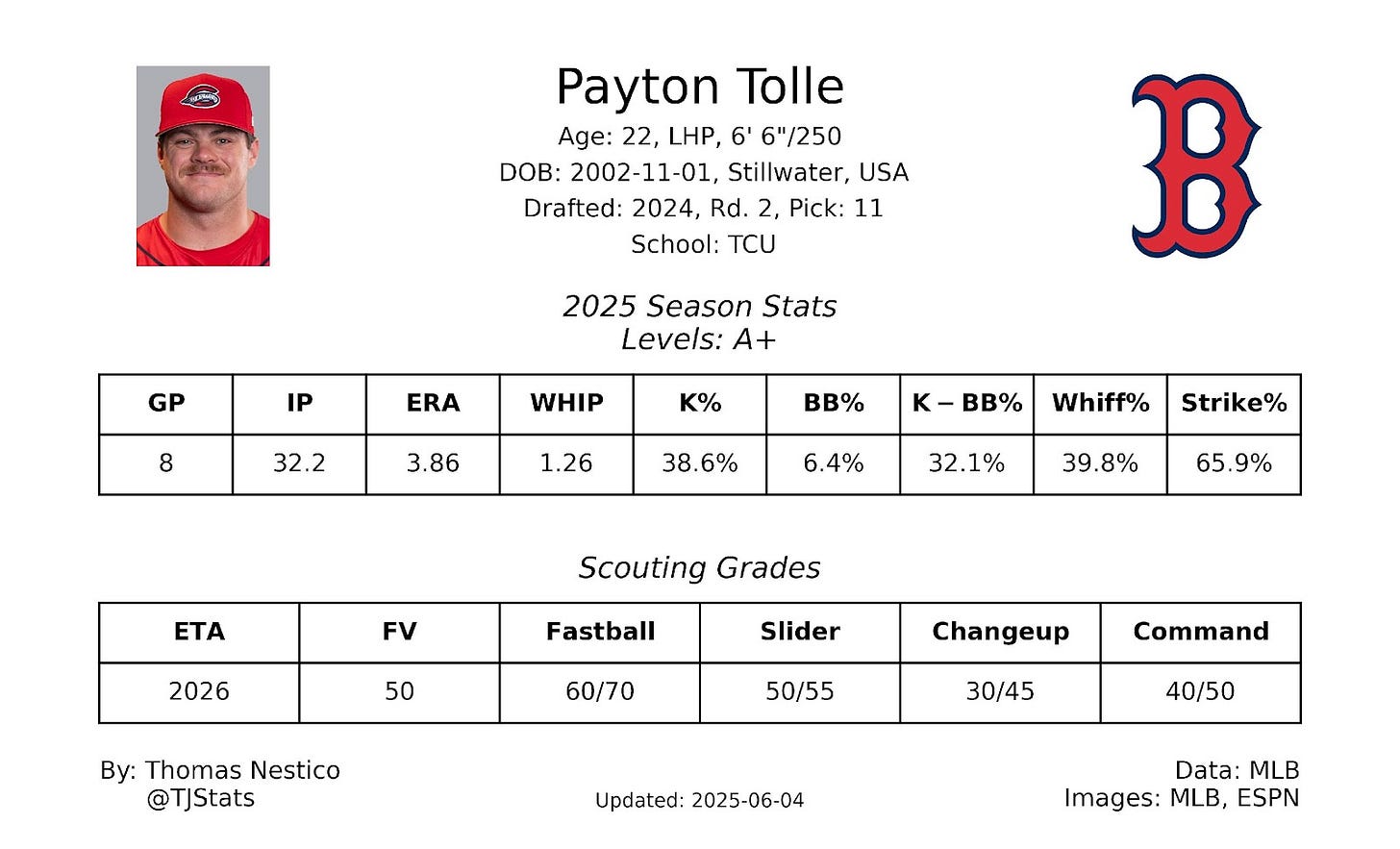
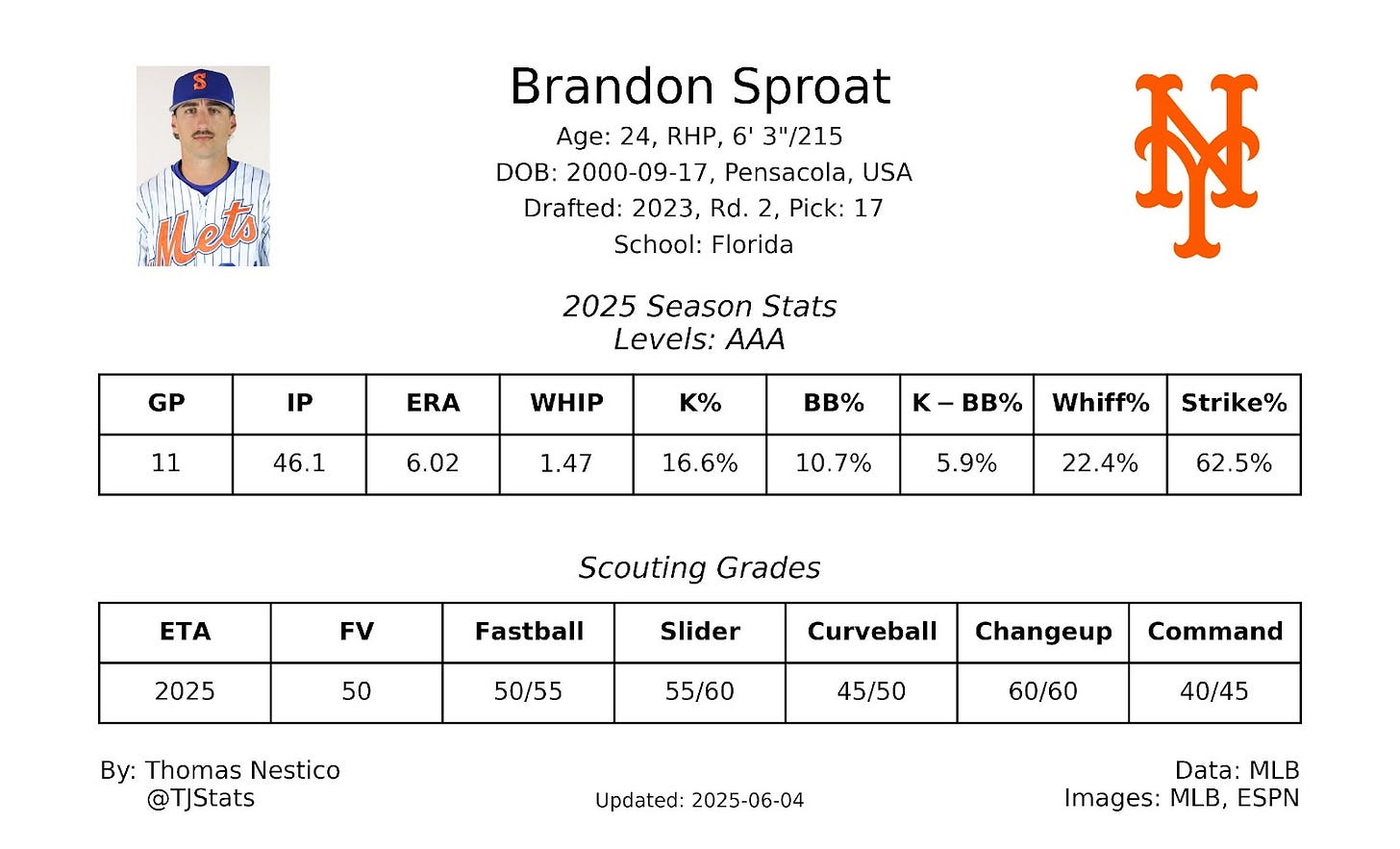
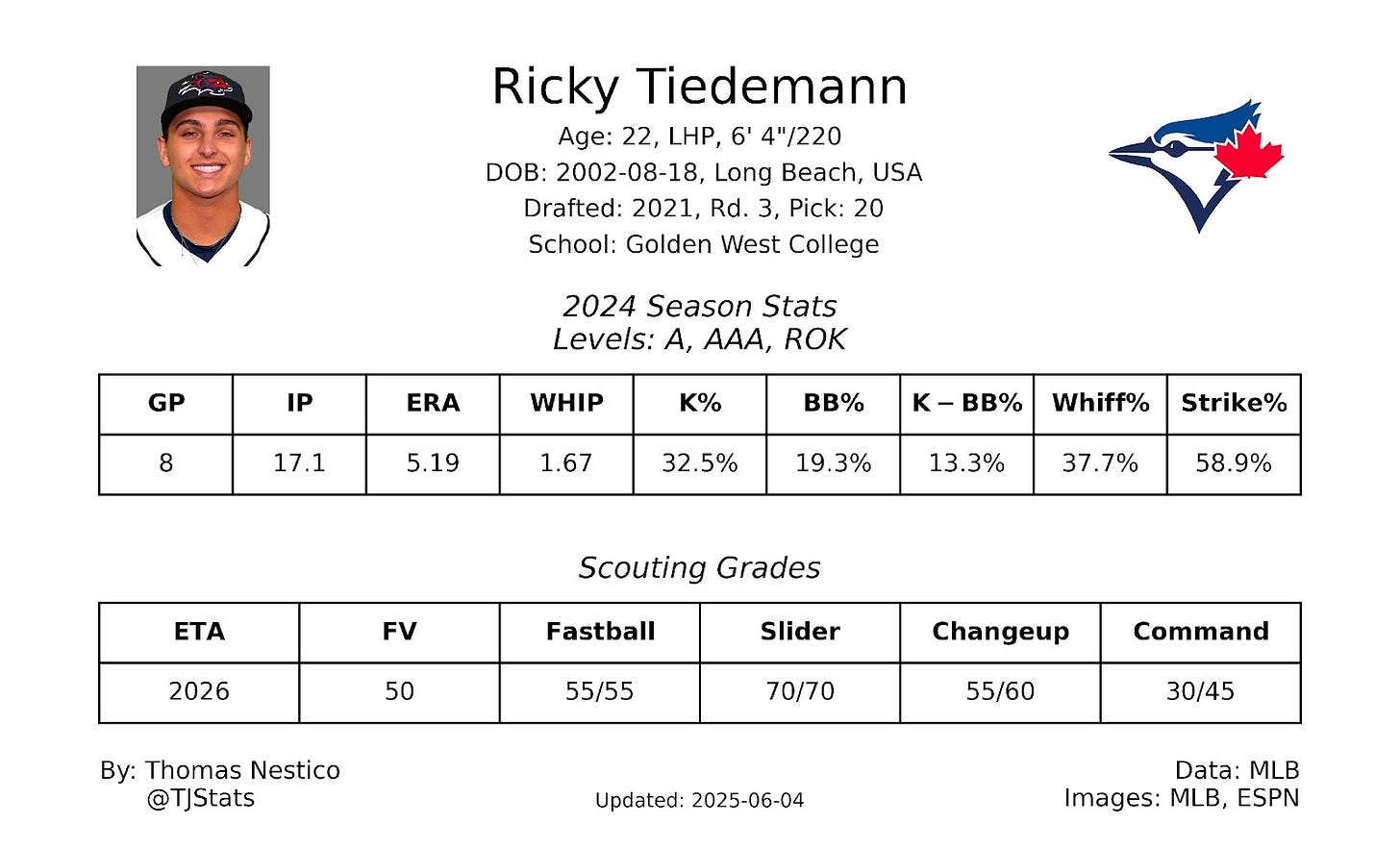
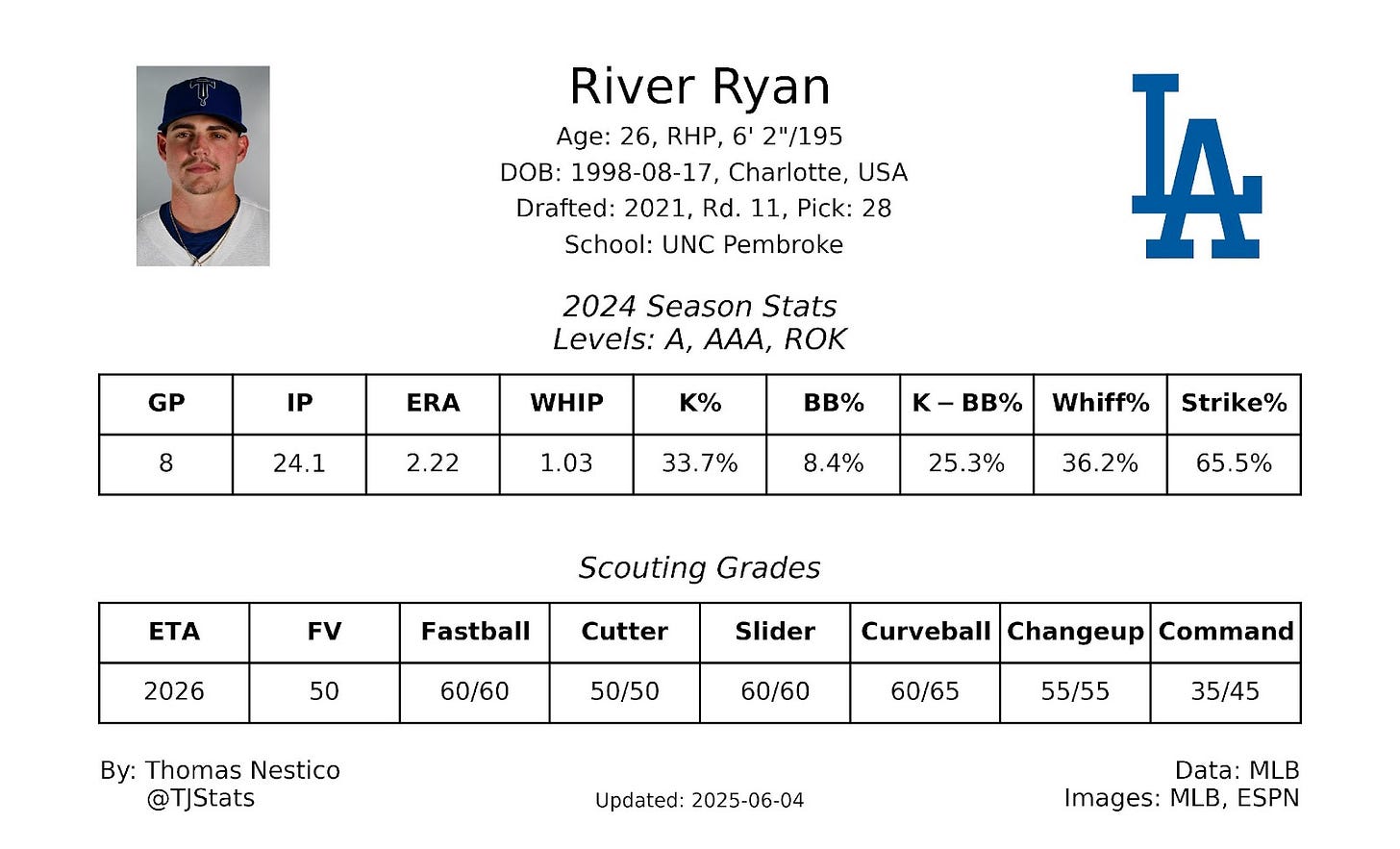
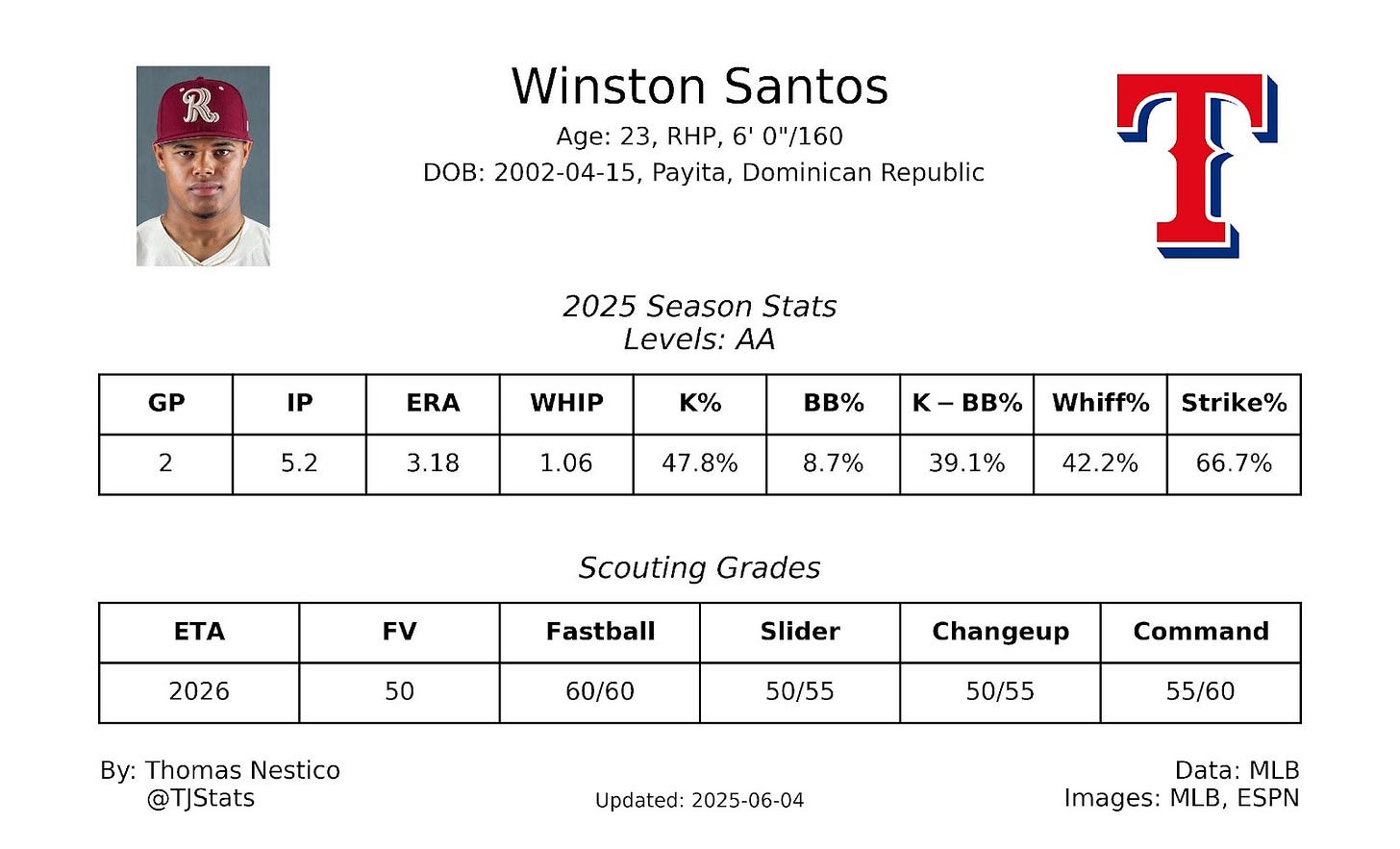
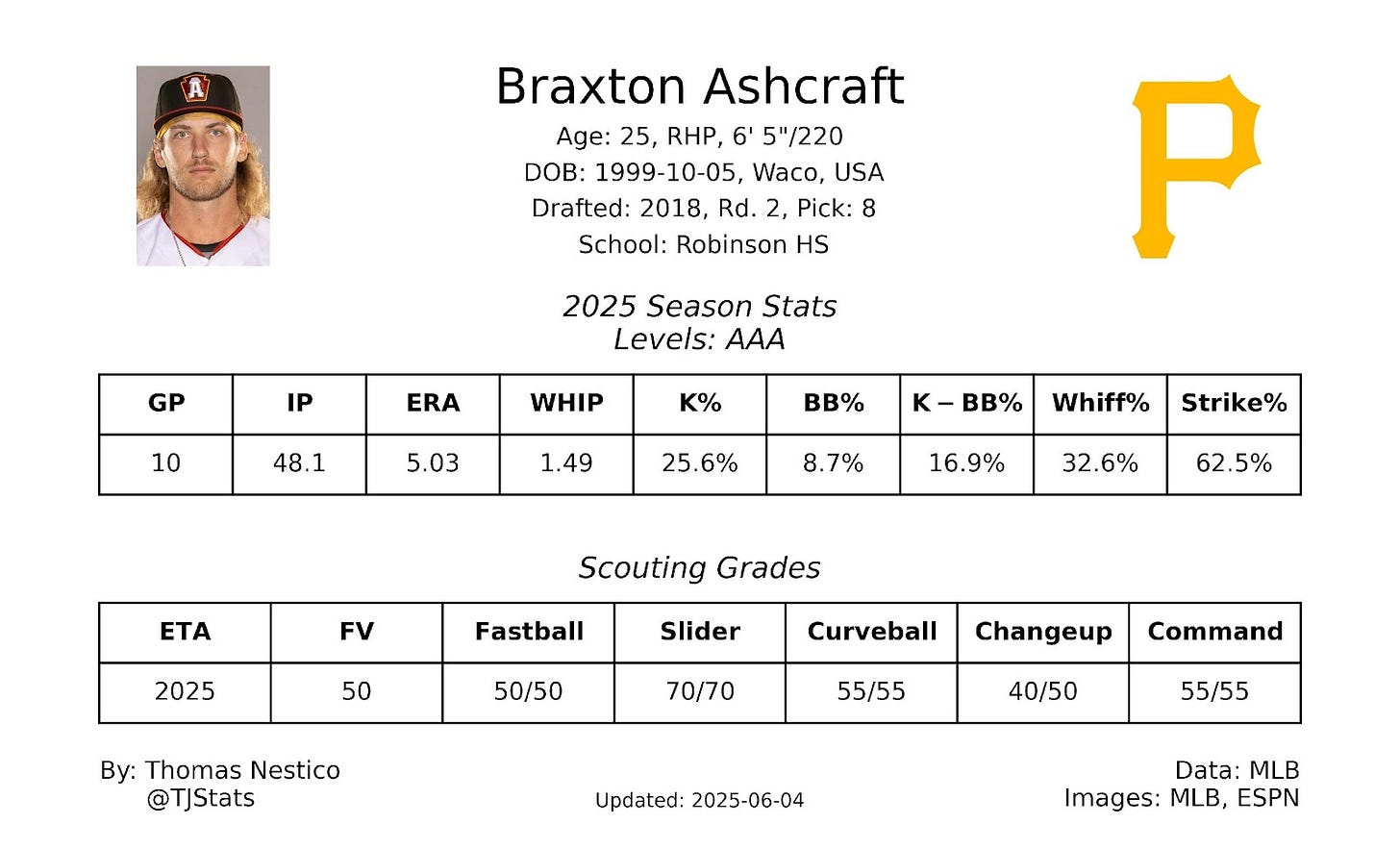
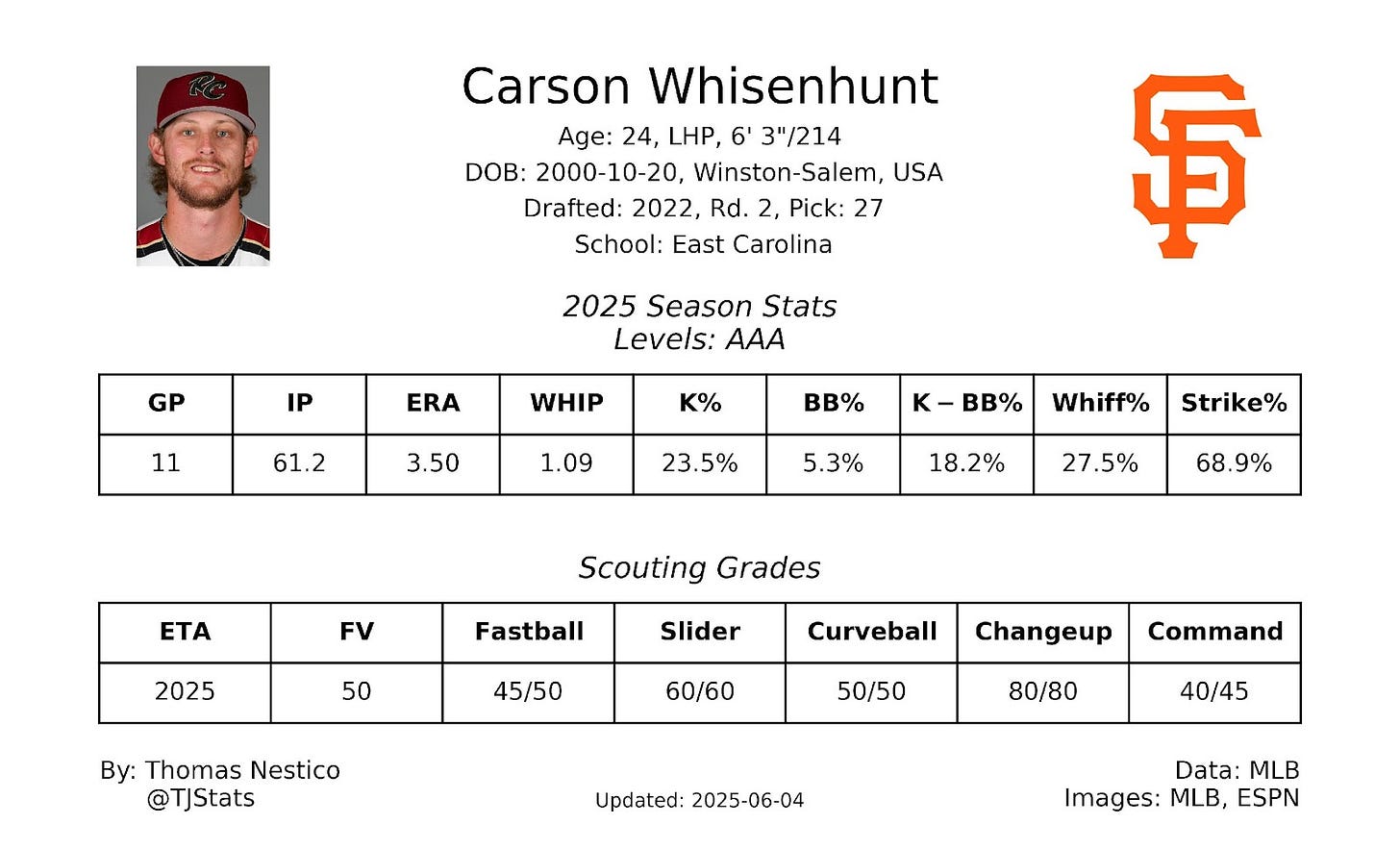

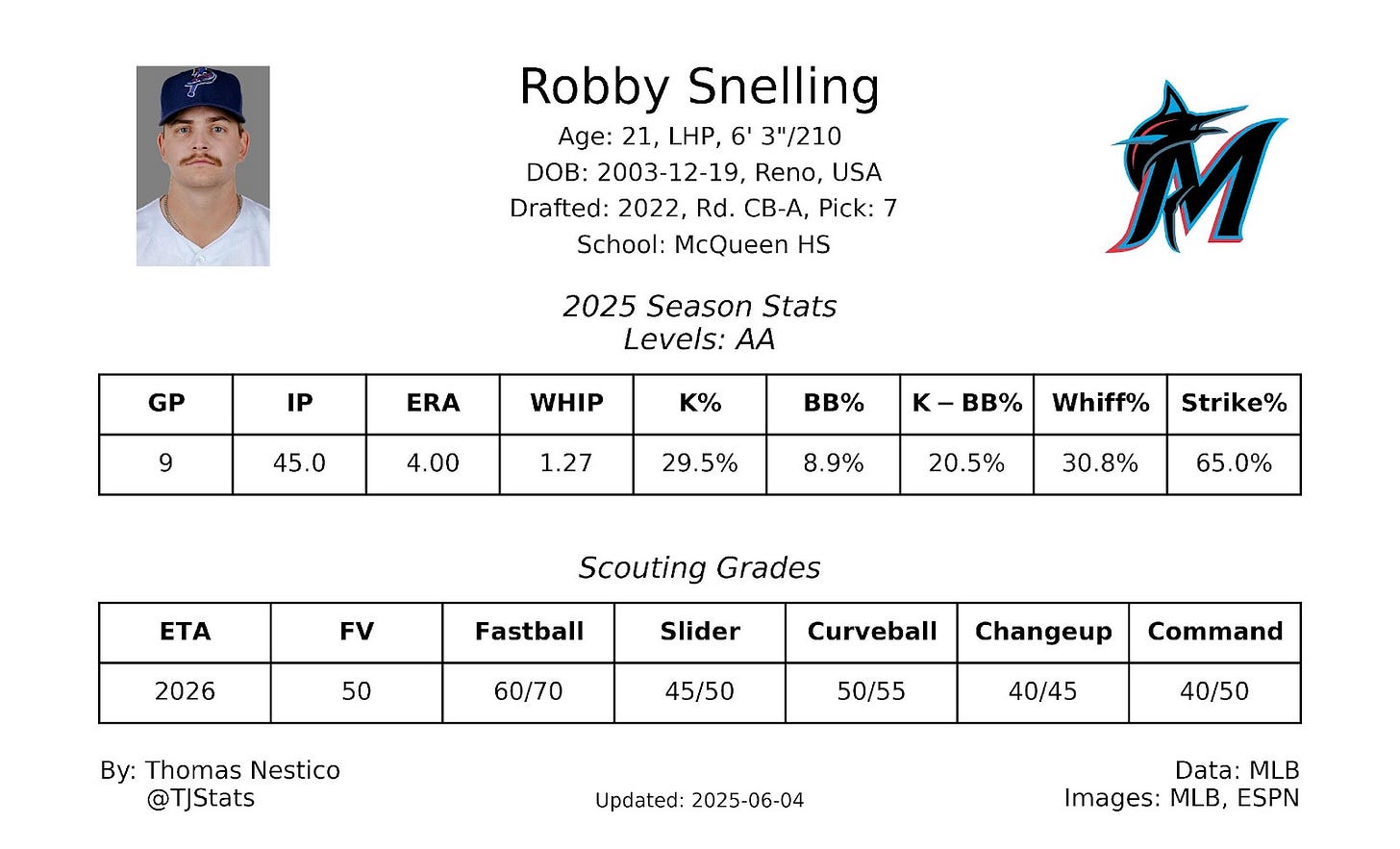
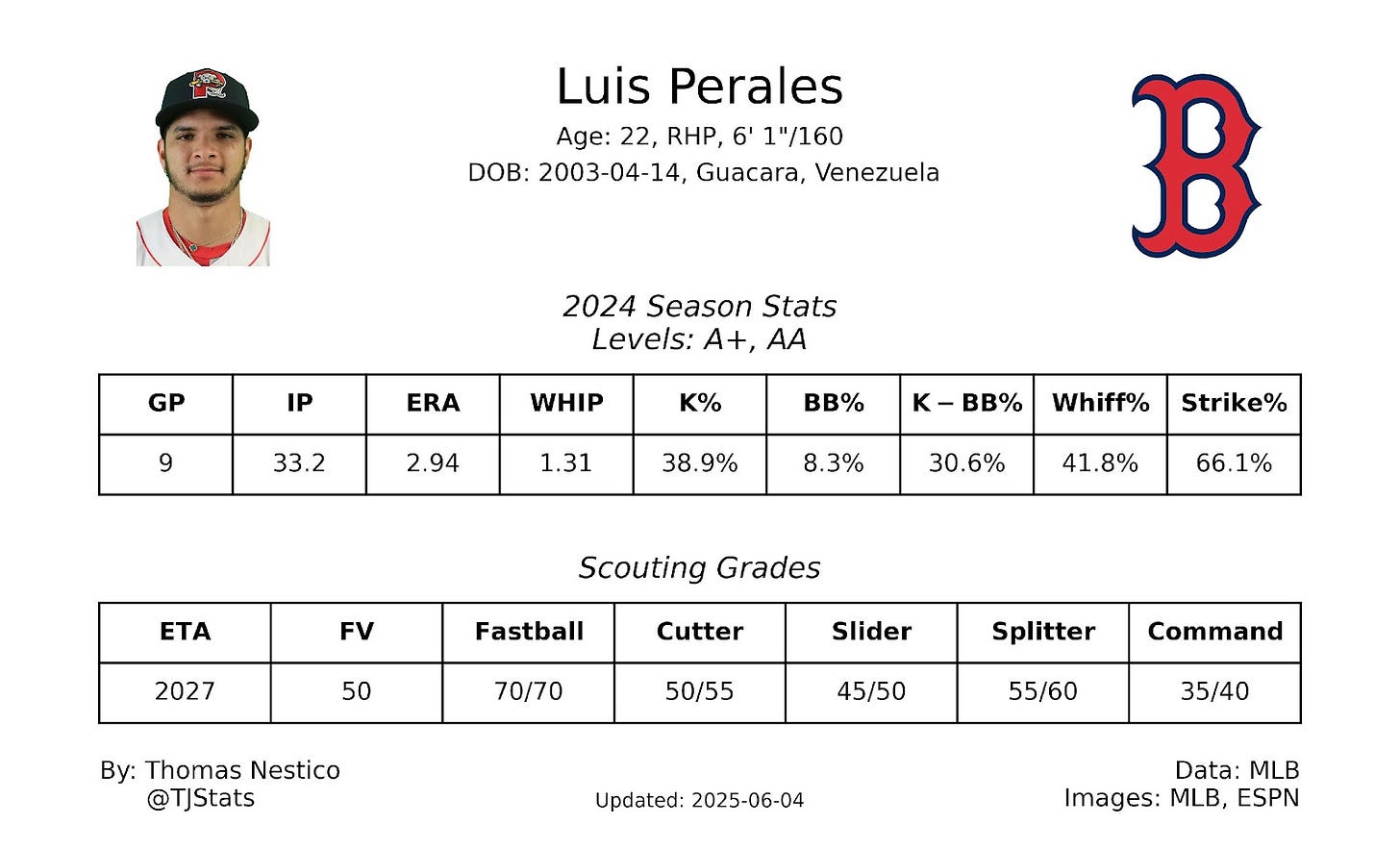

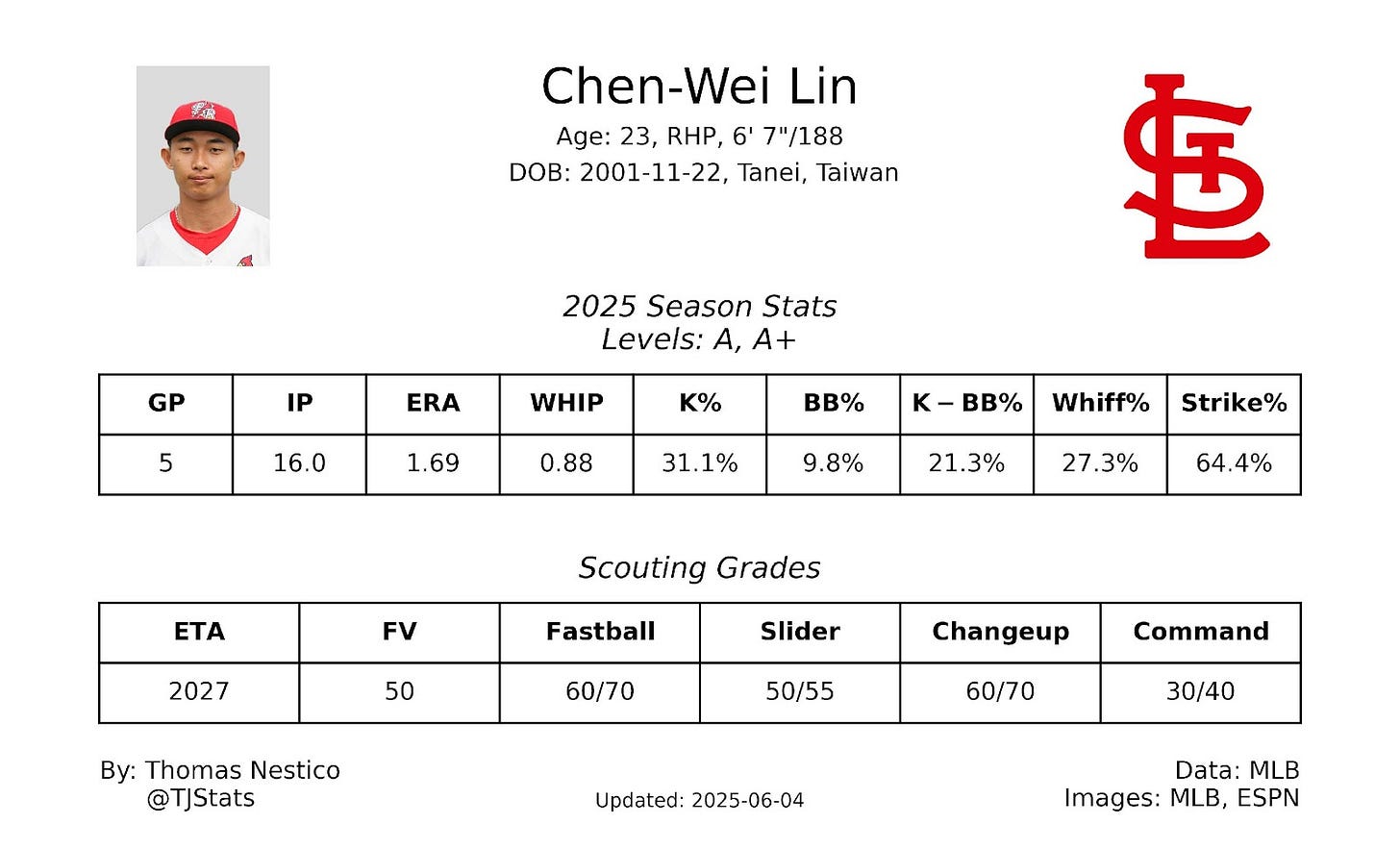
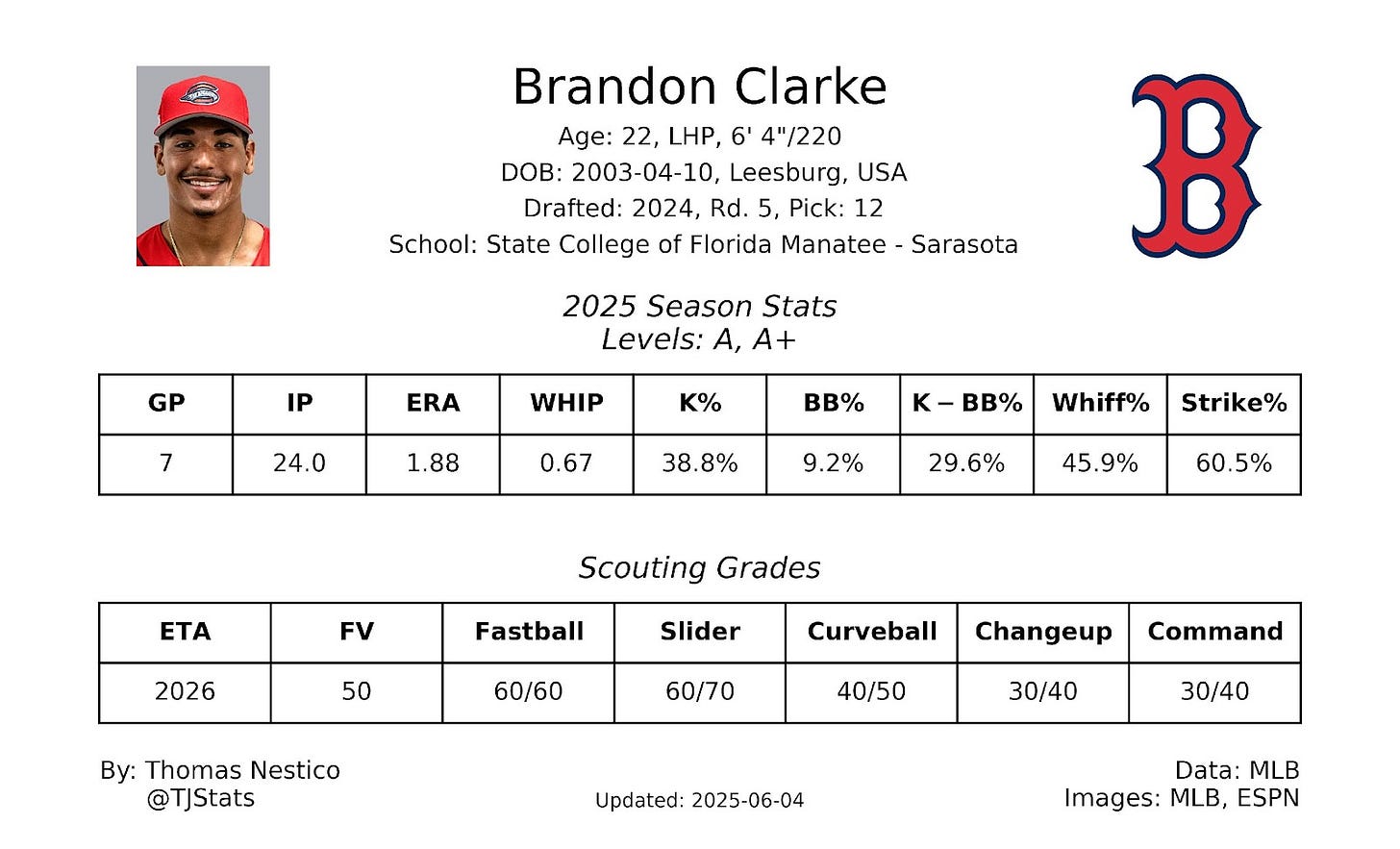
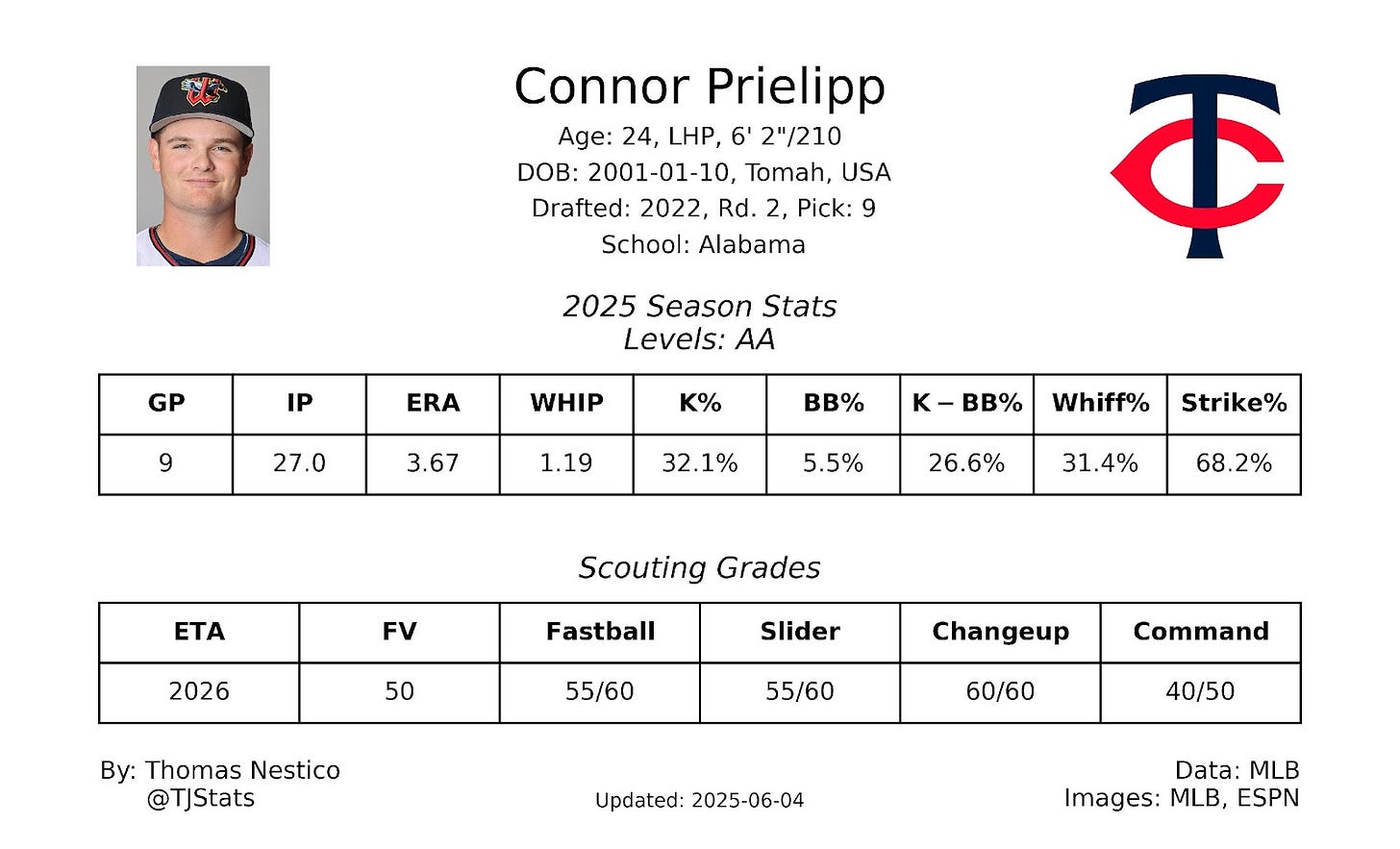
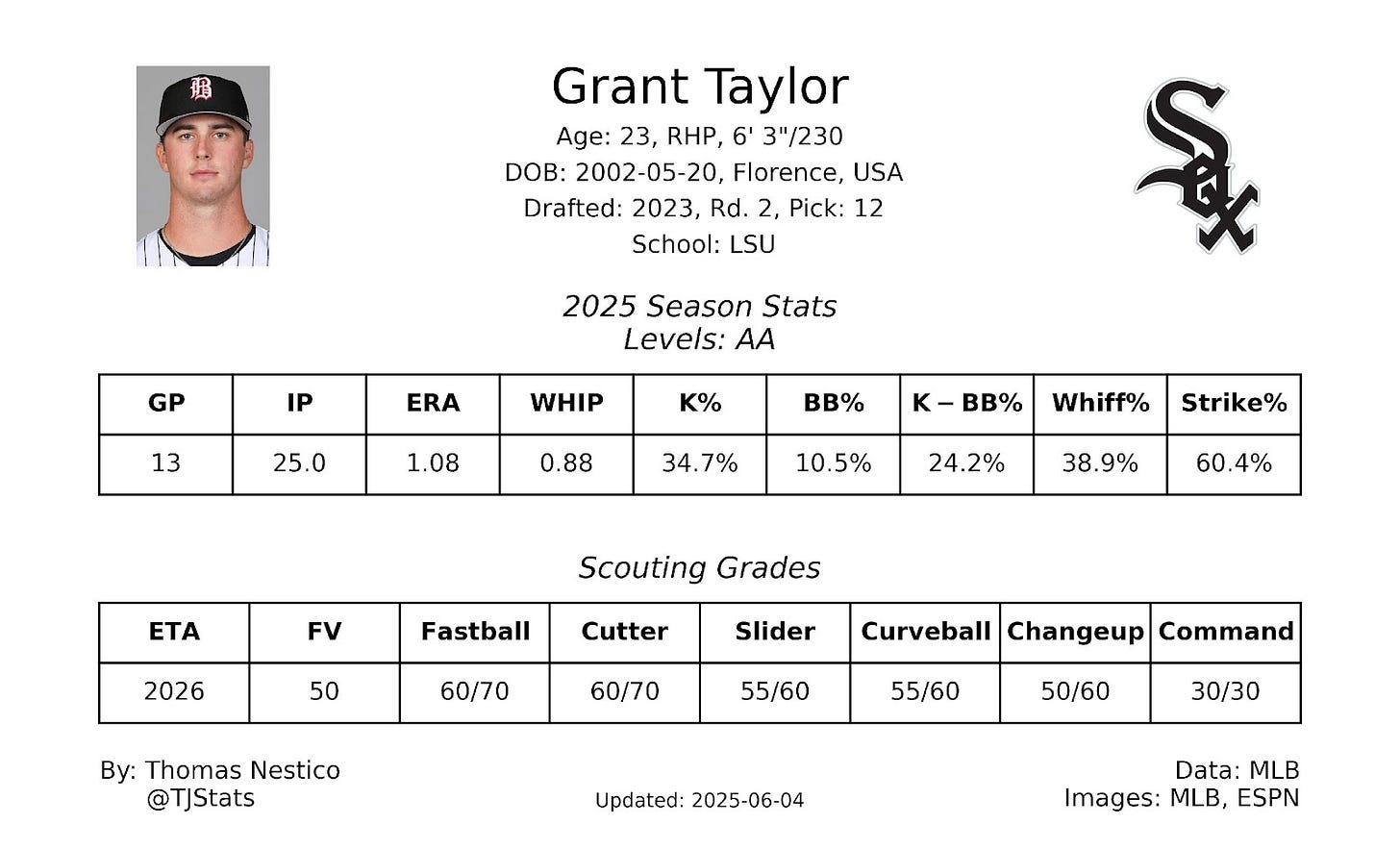
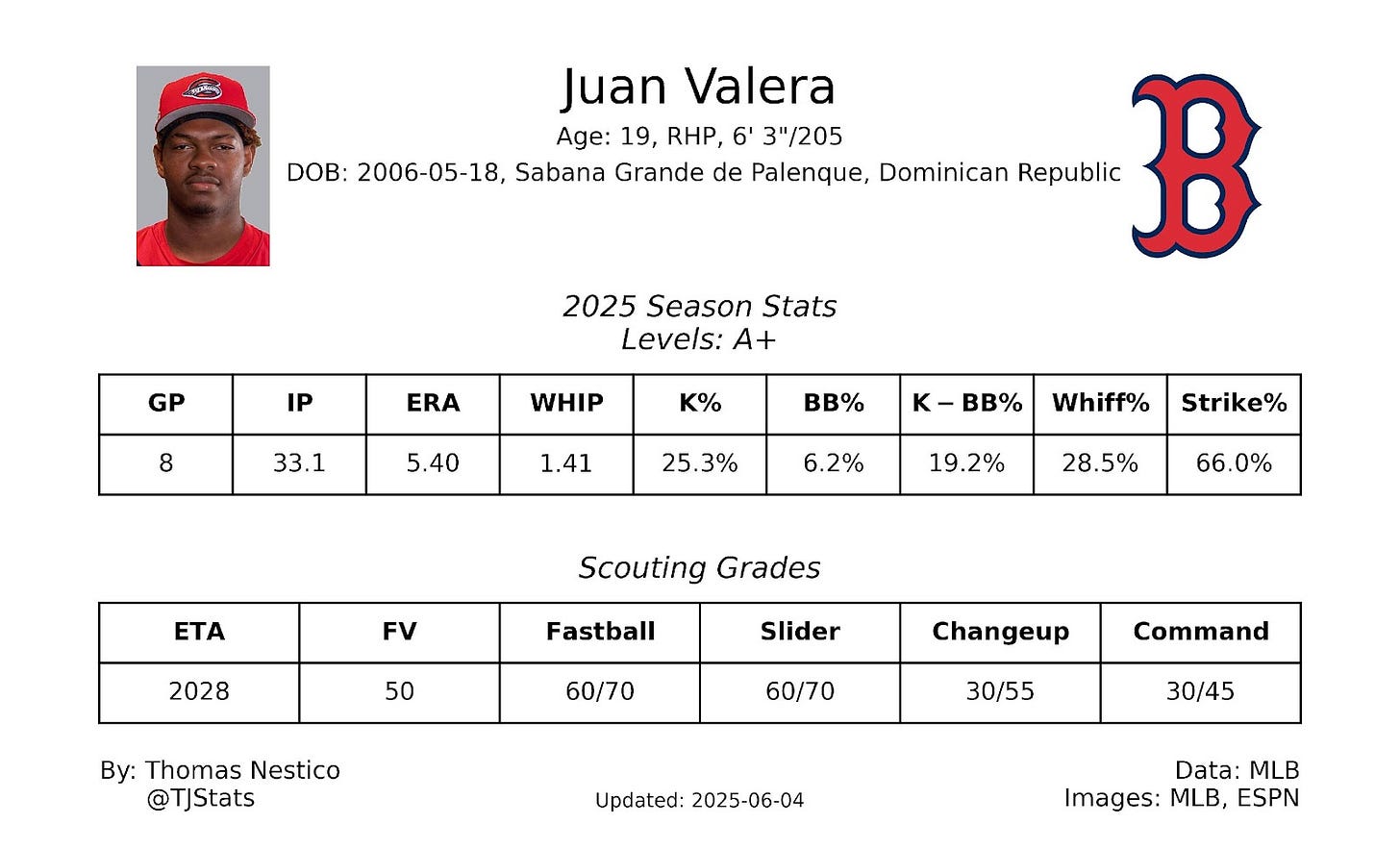
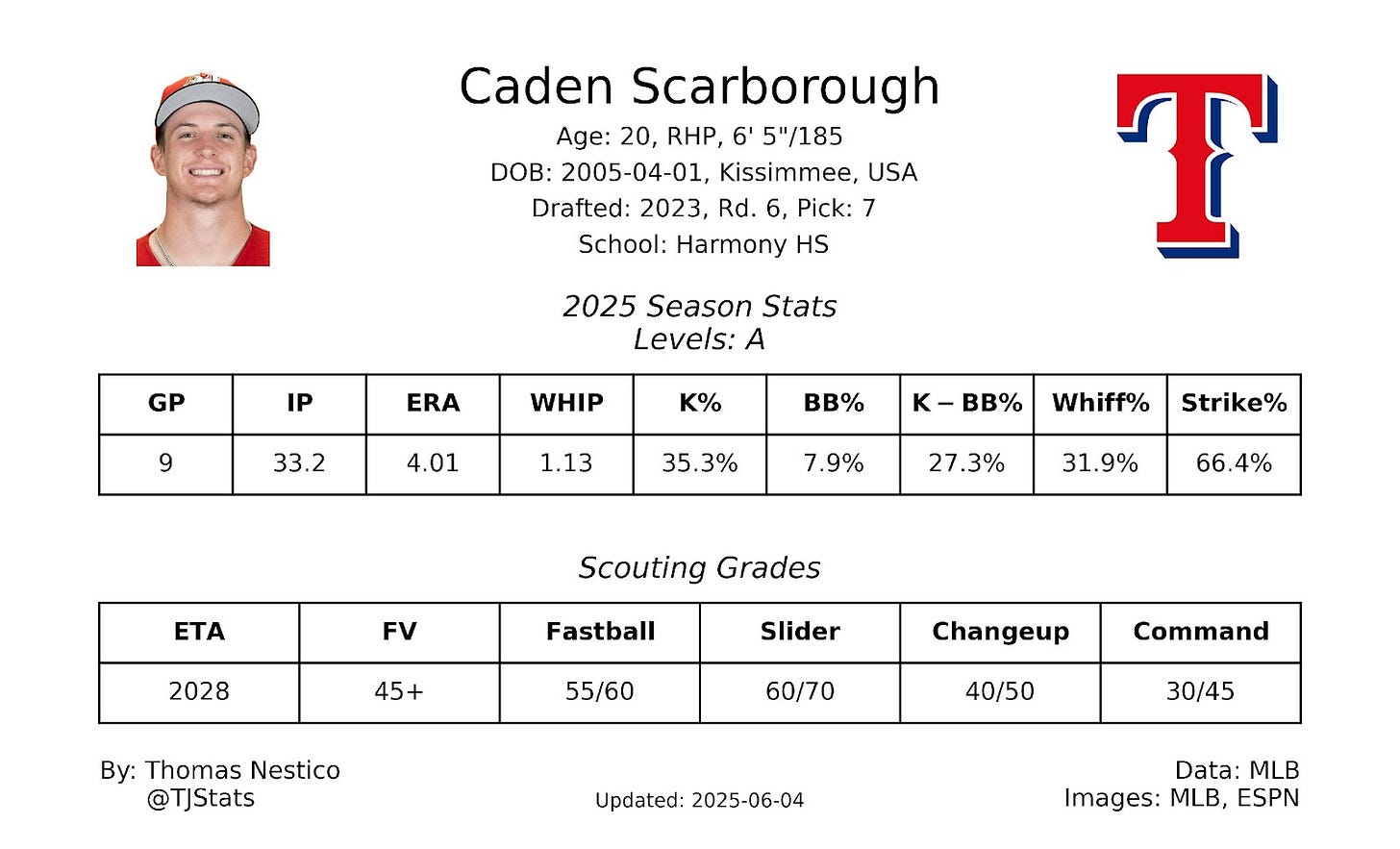
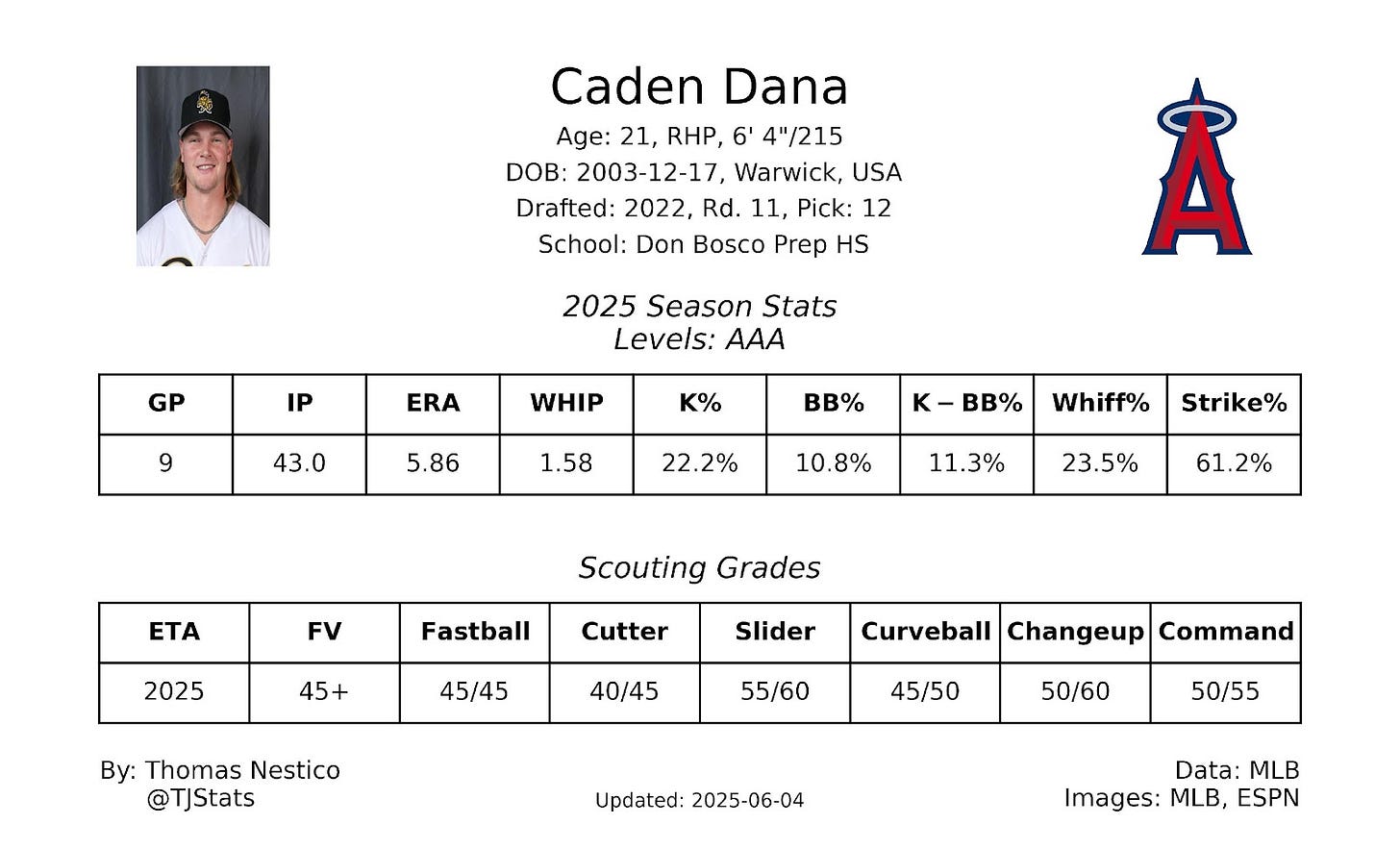
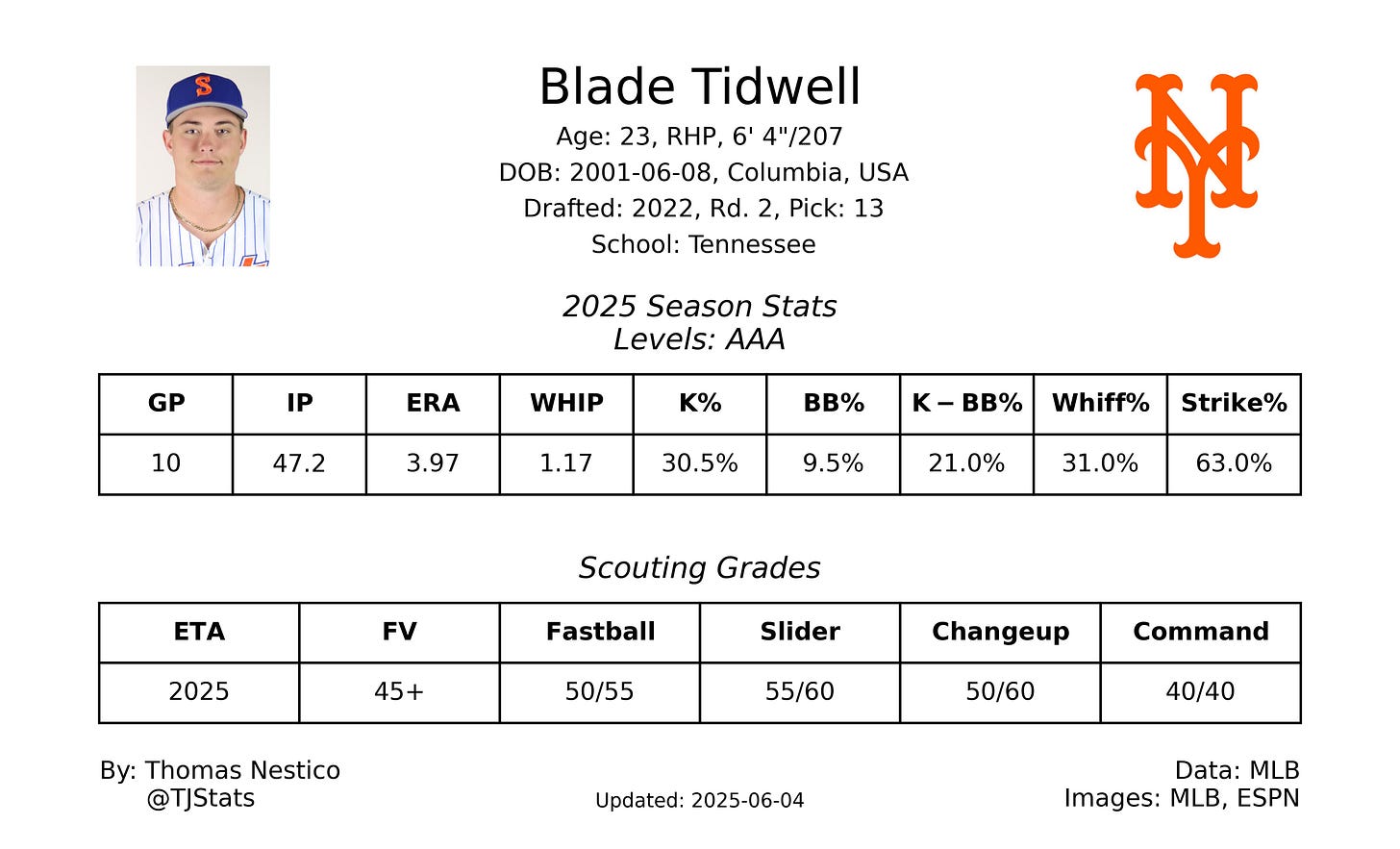
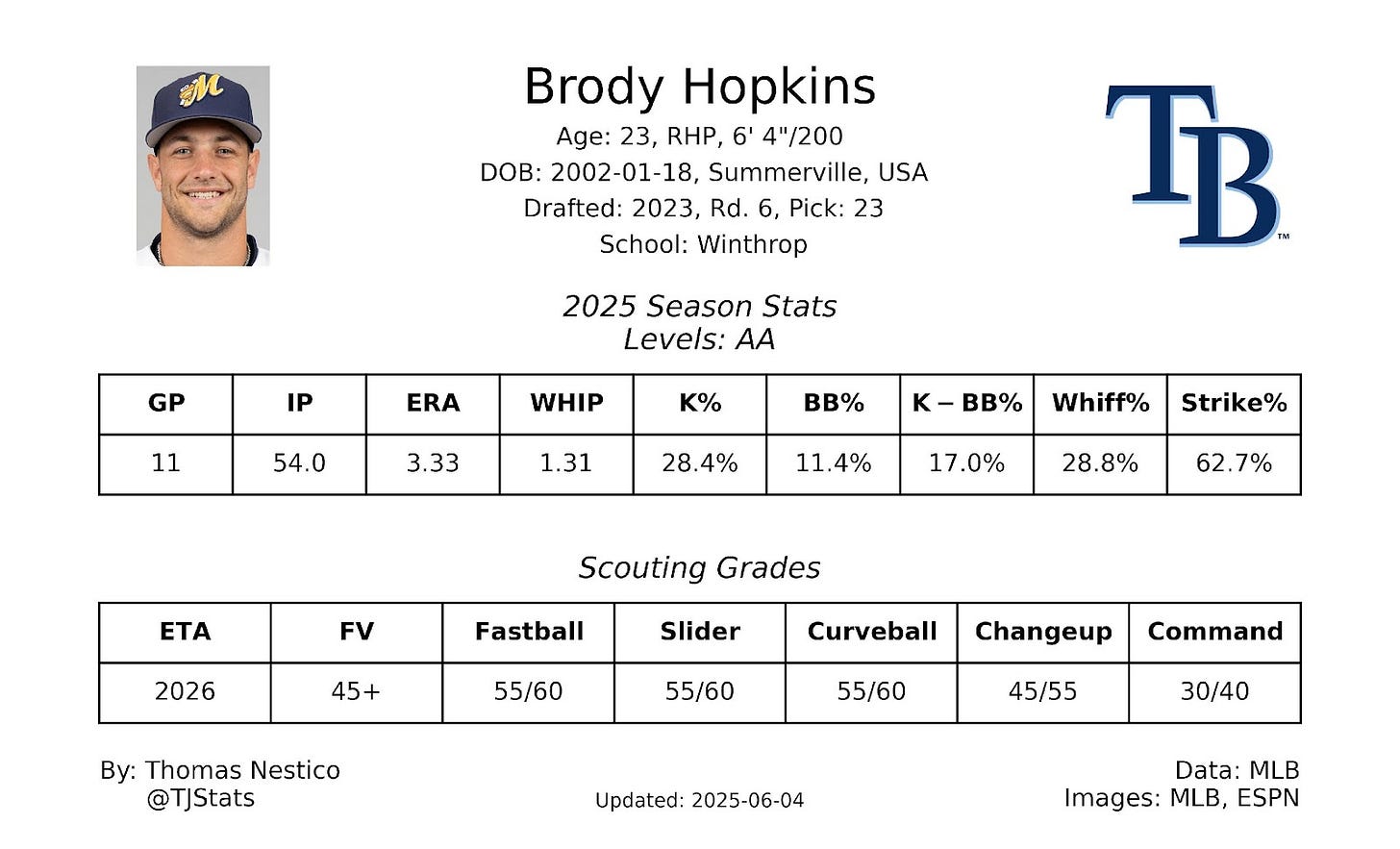
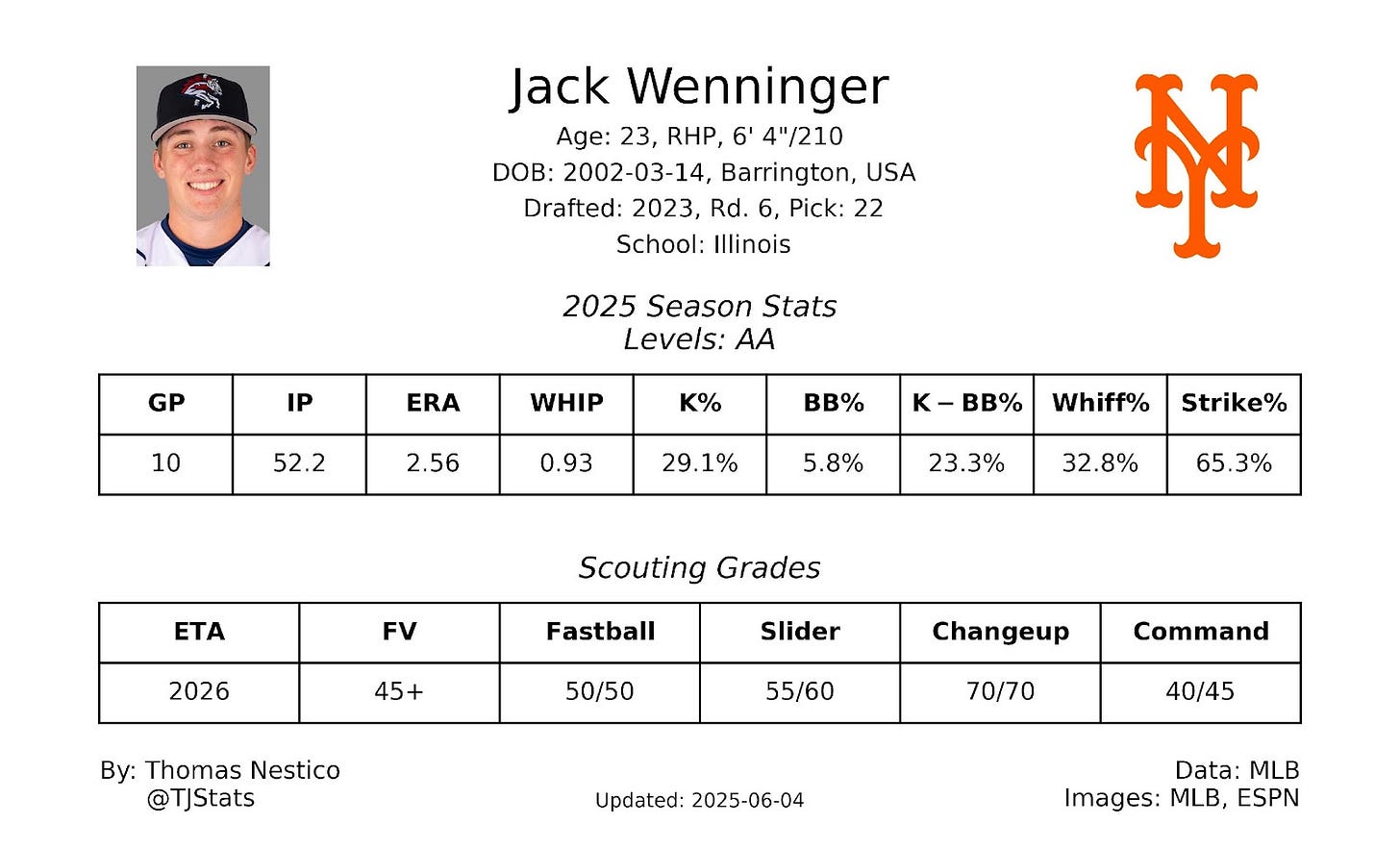
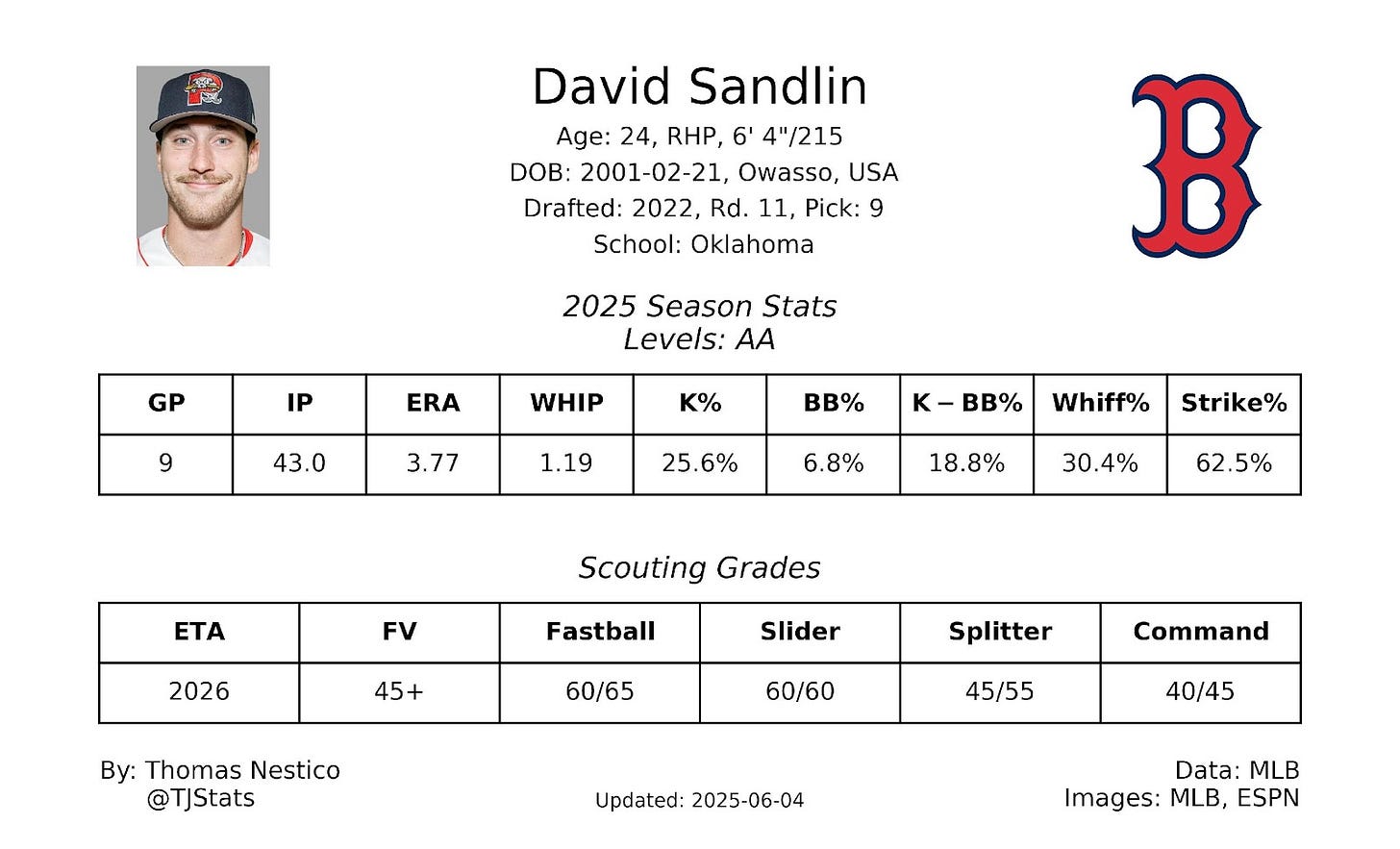
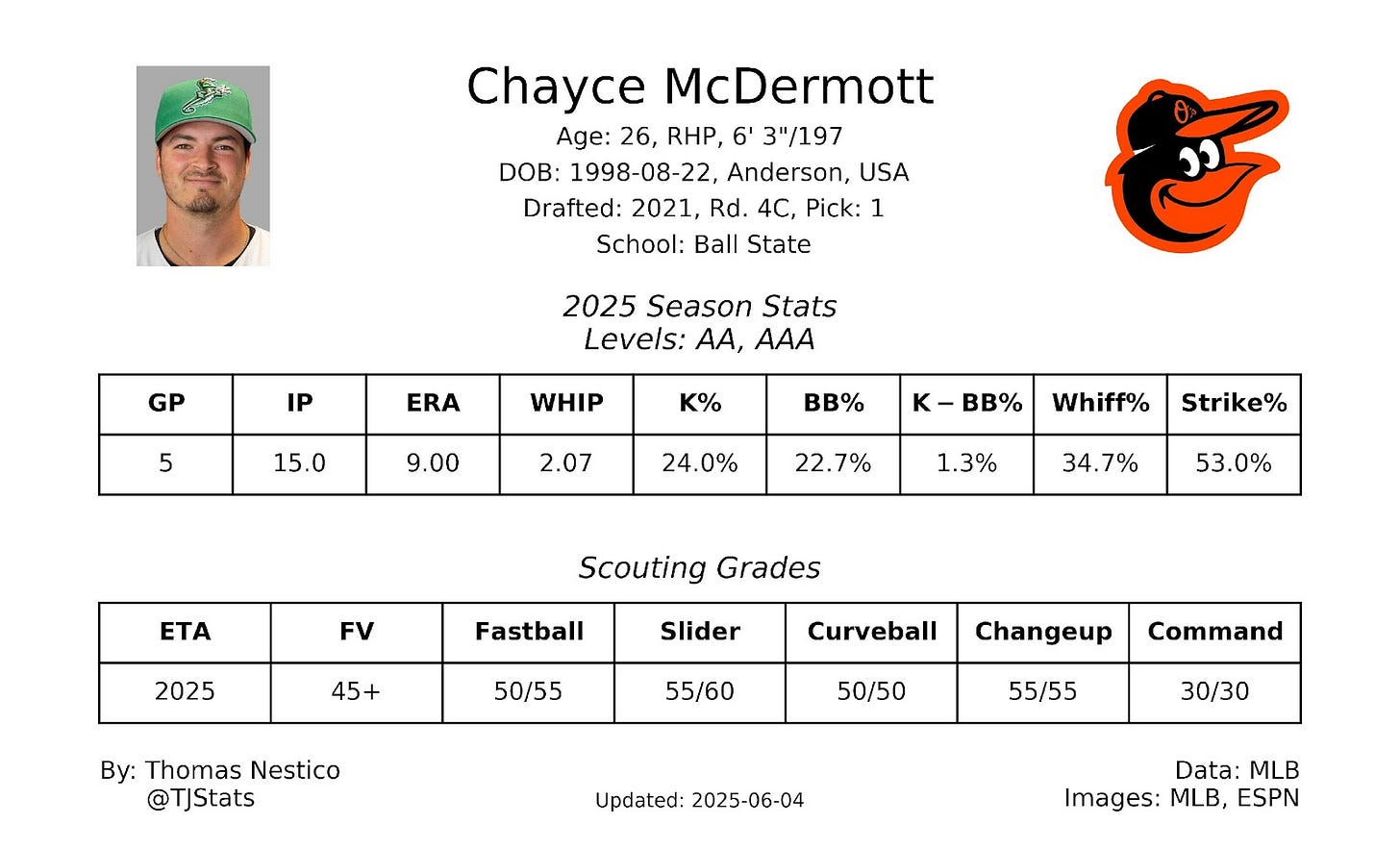
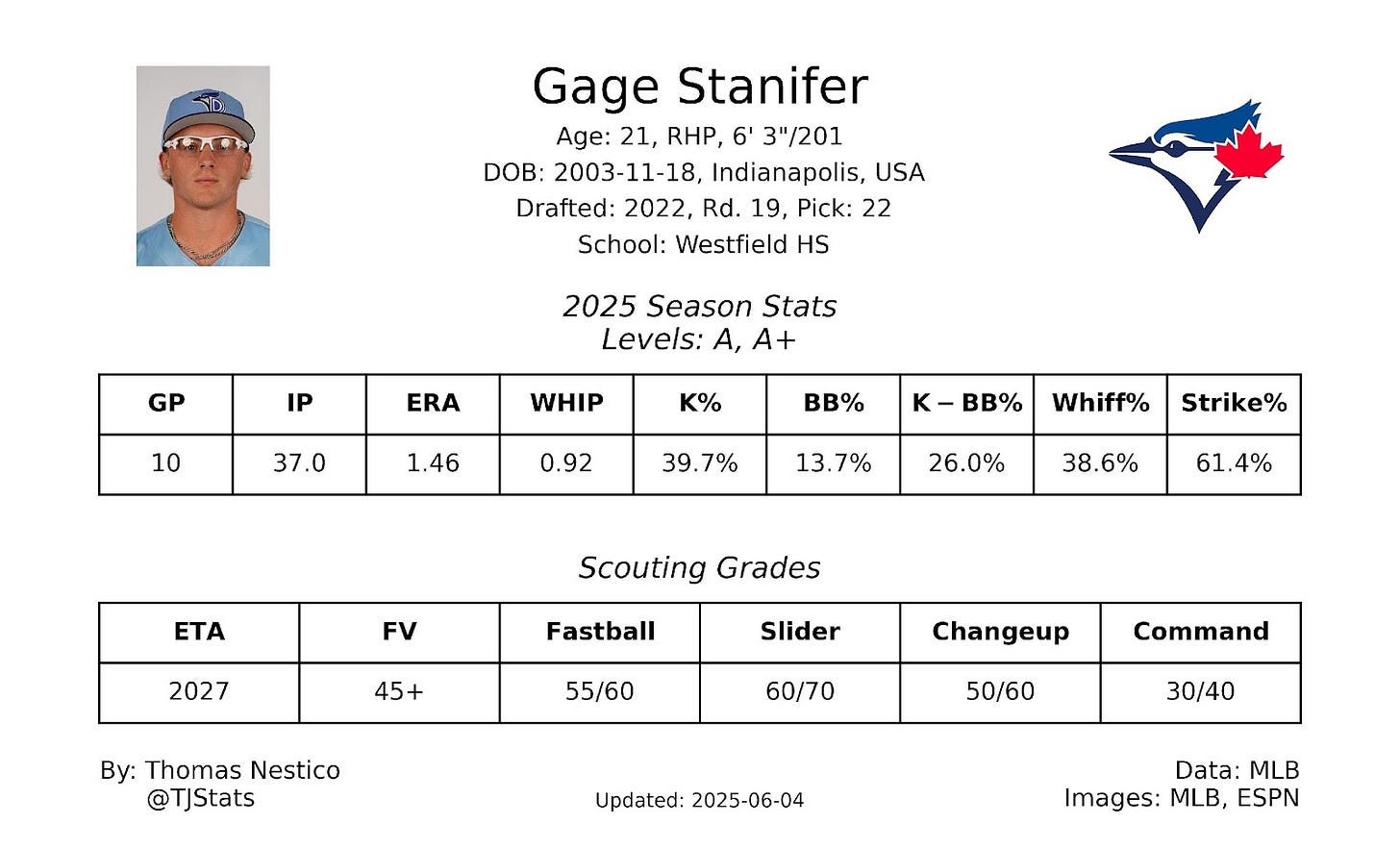
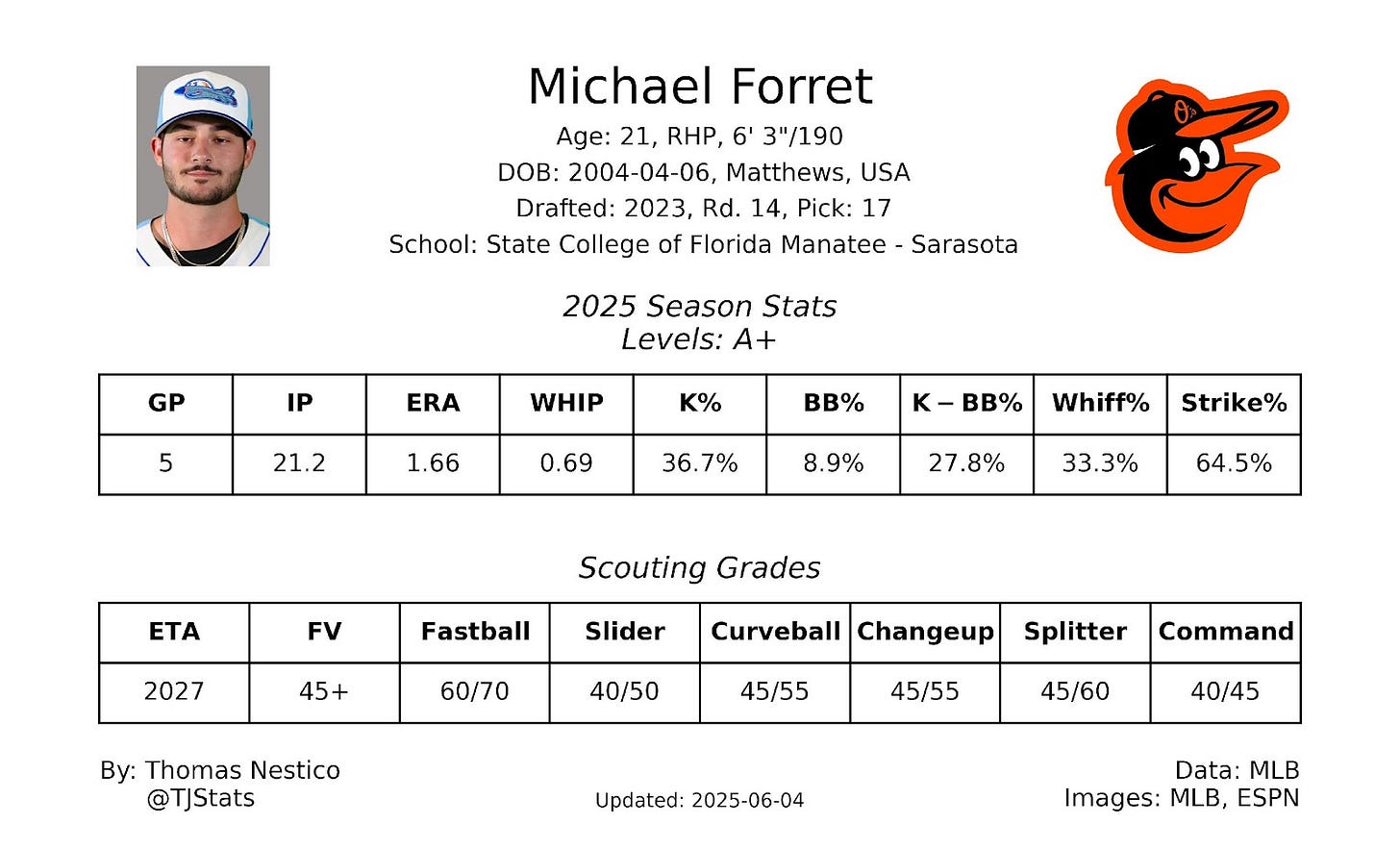
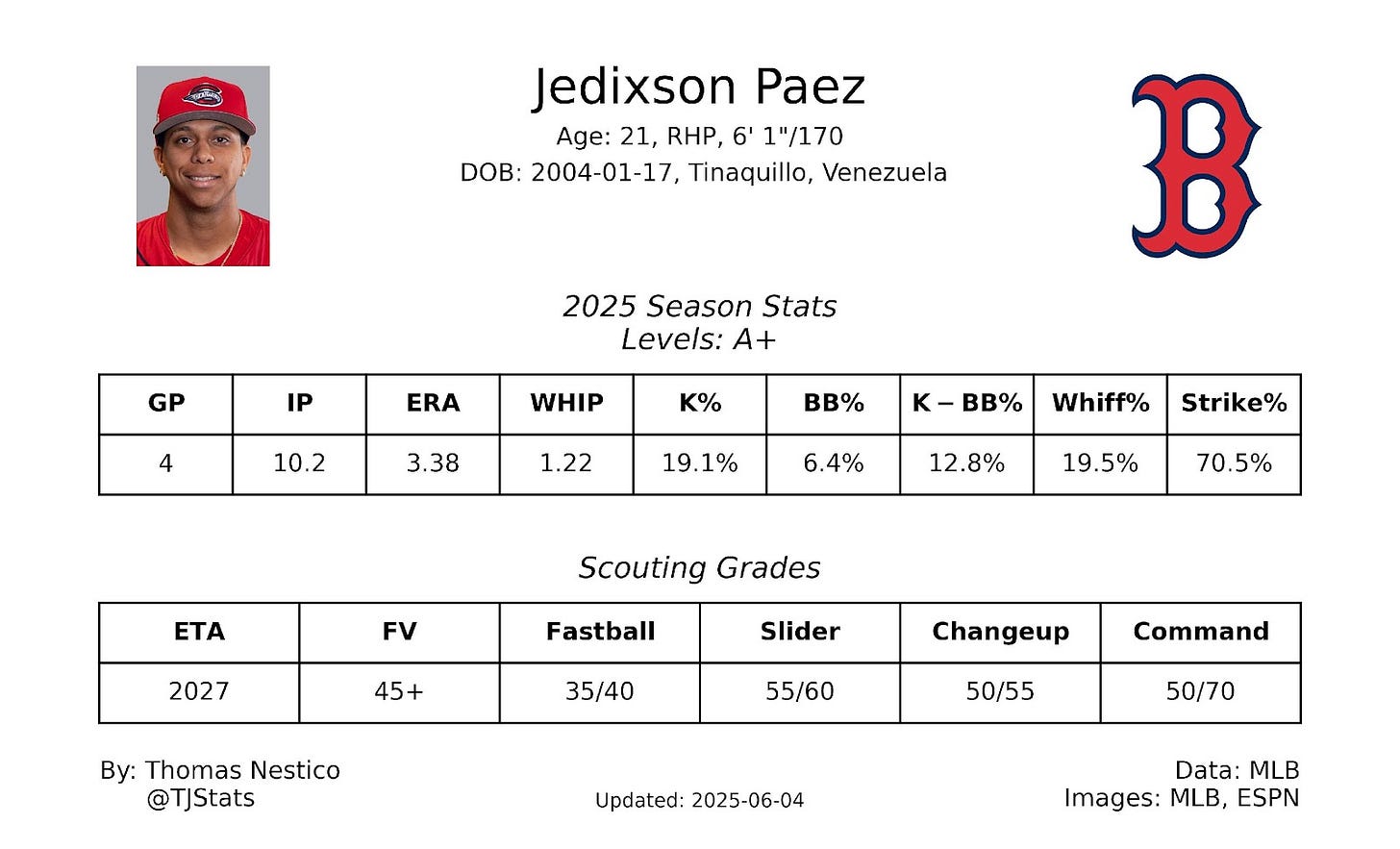
The end of Robby Snelling's report seems to be incomplete--looks like you missed the last line of a highlight before copy/pasting into Substack?